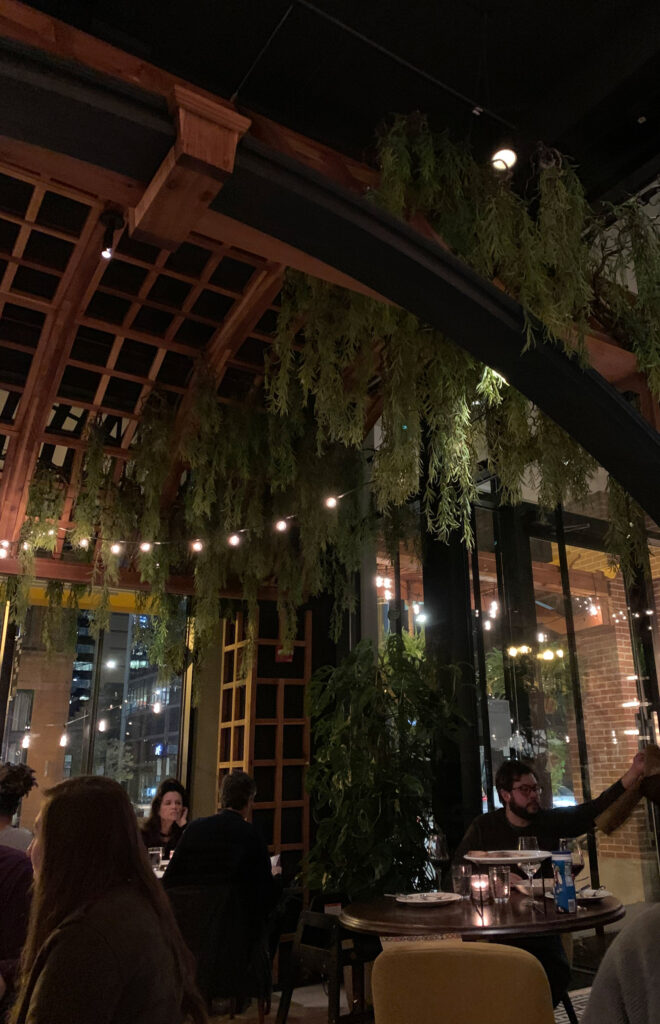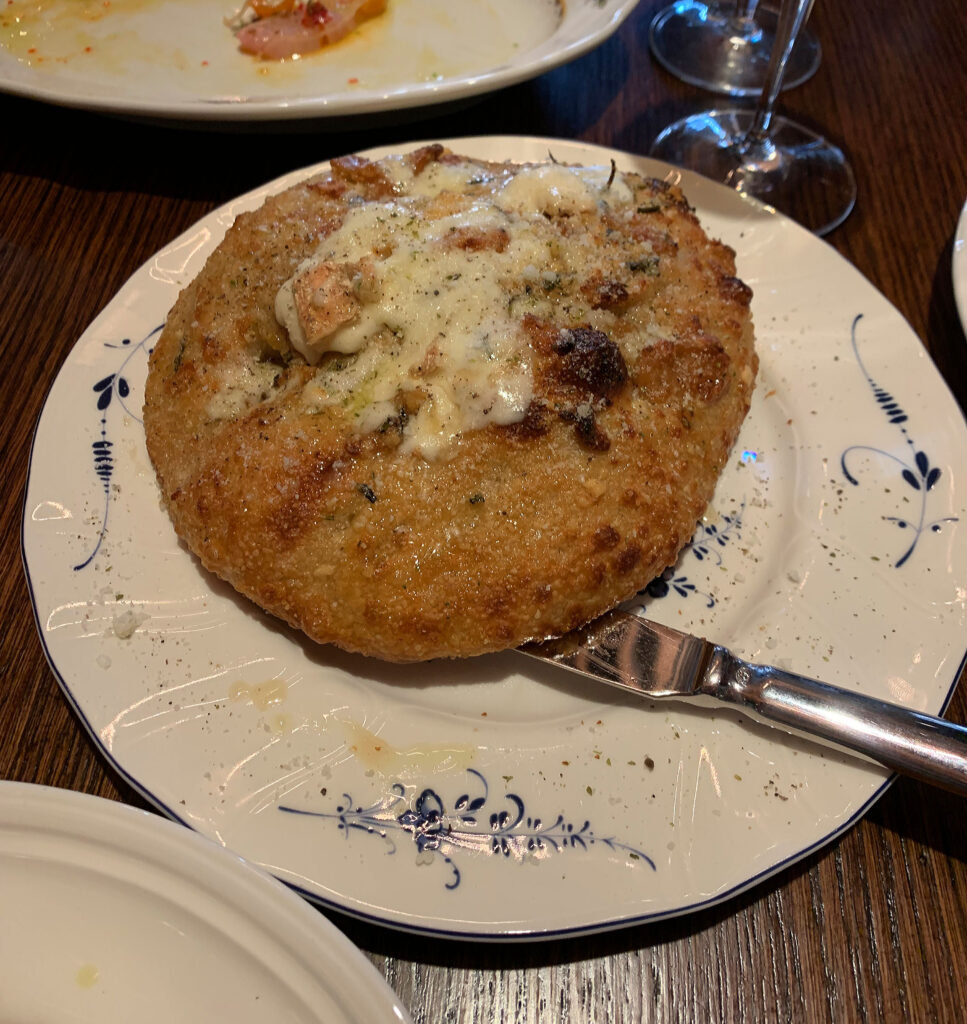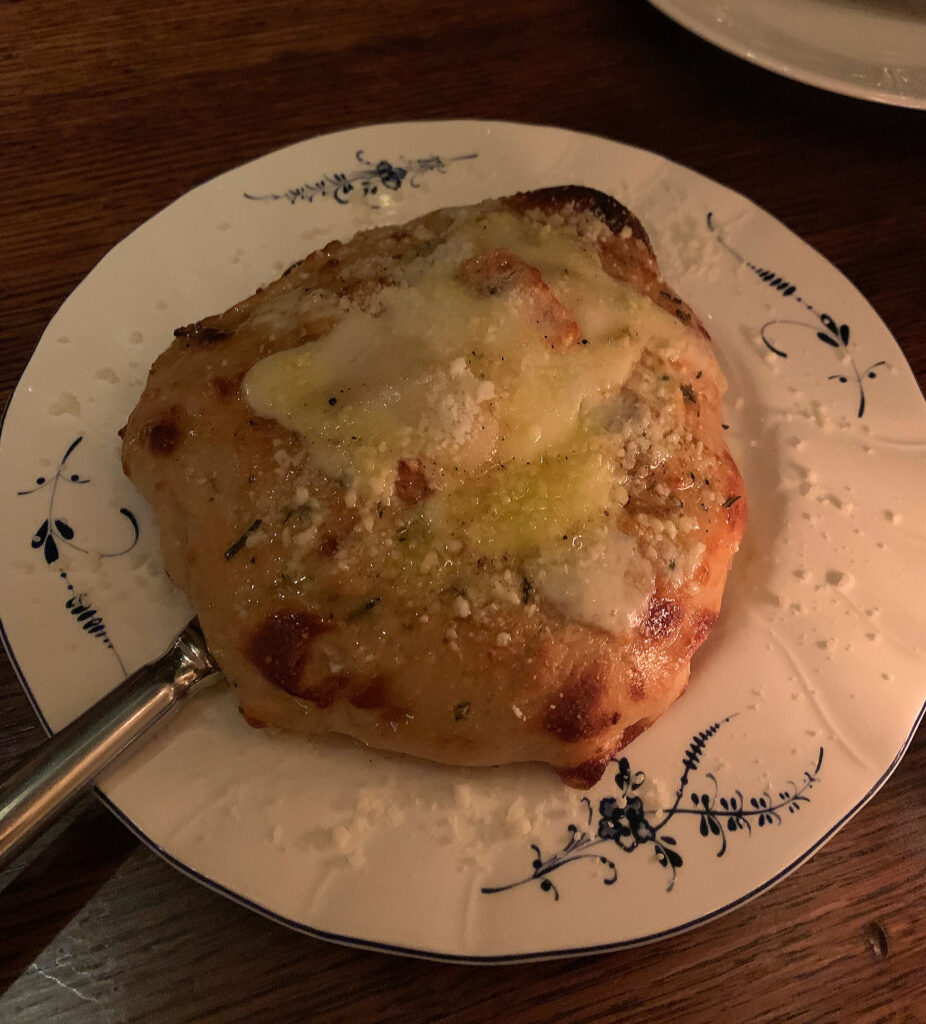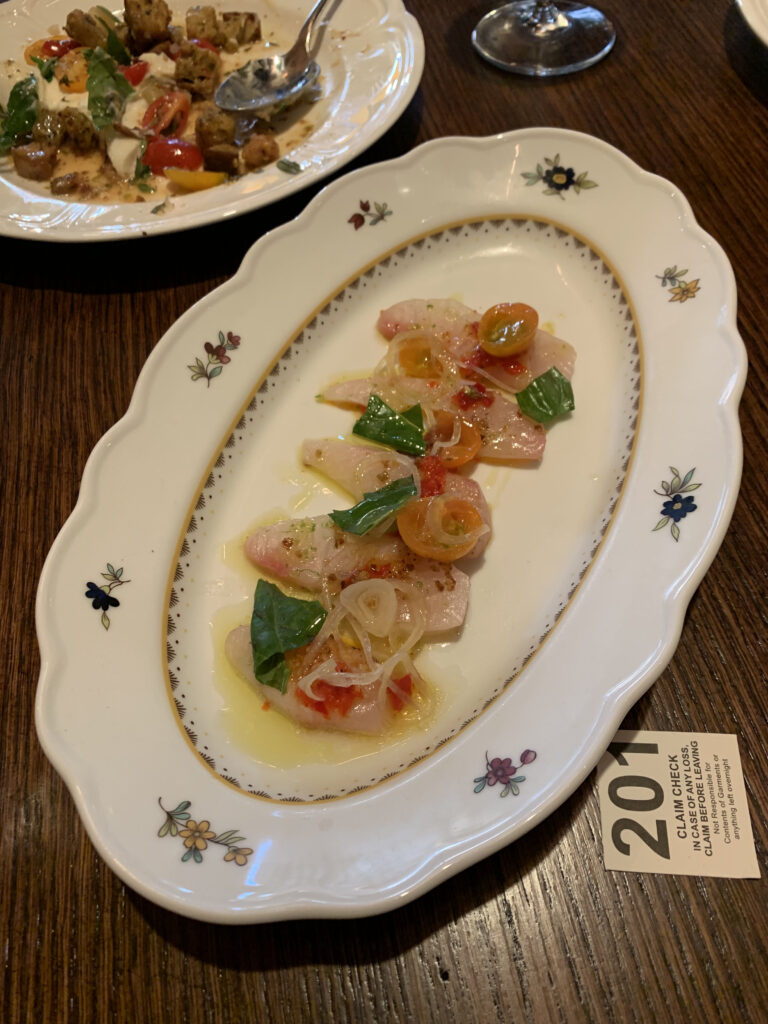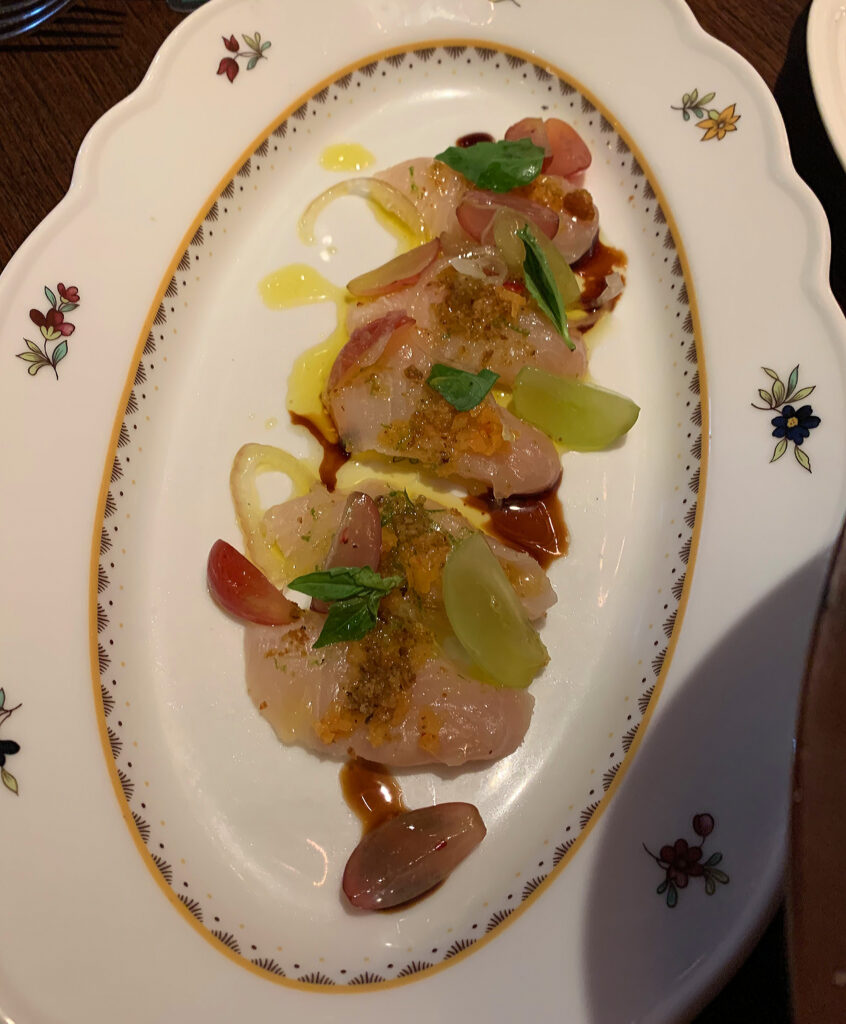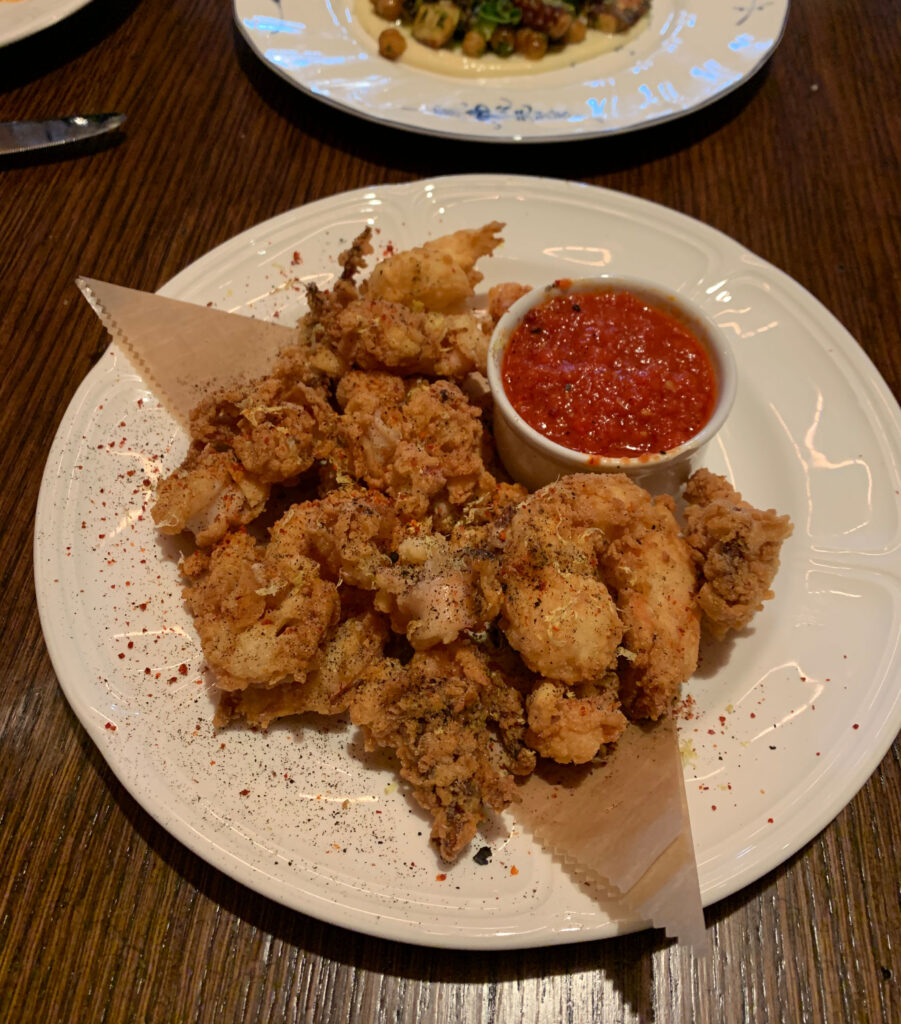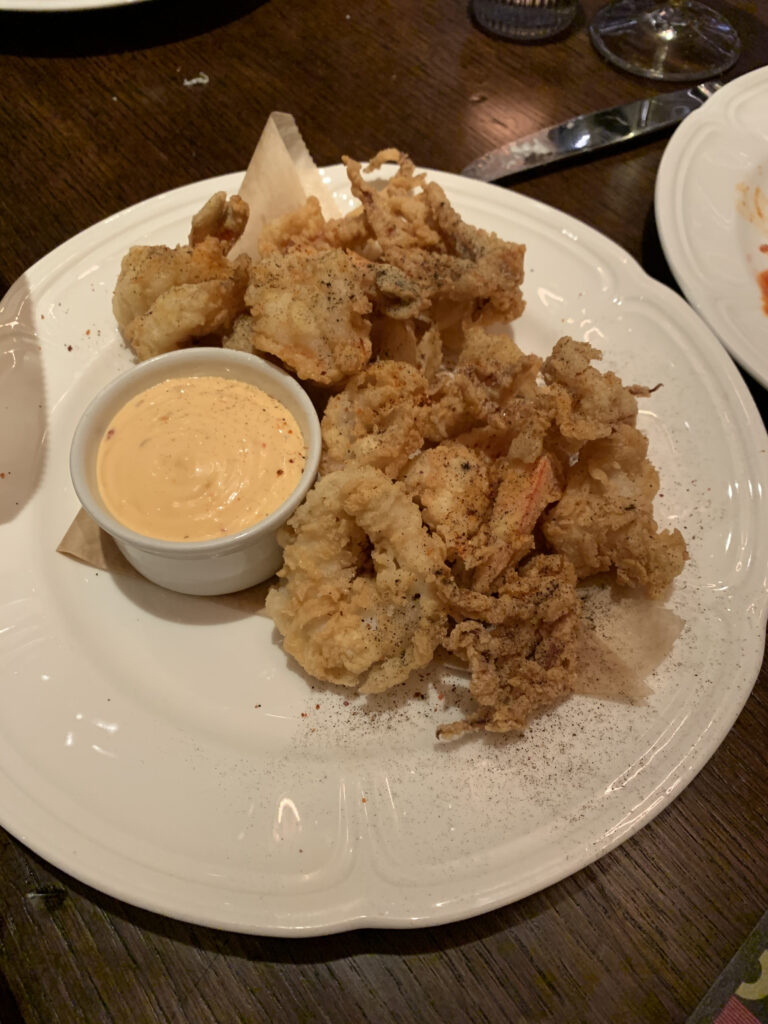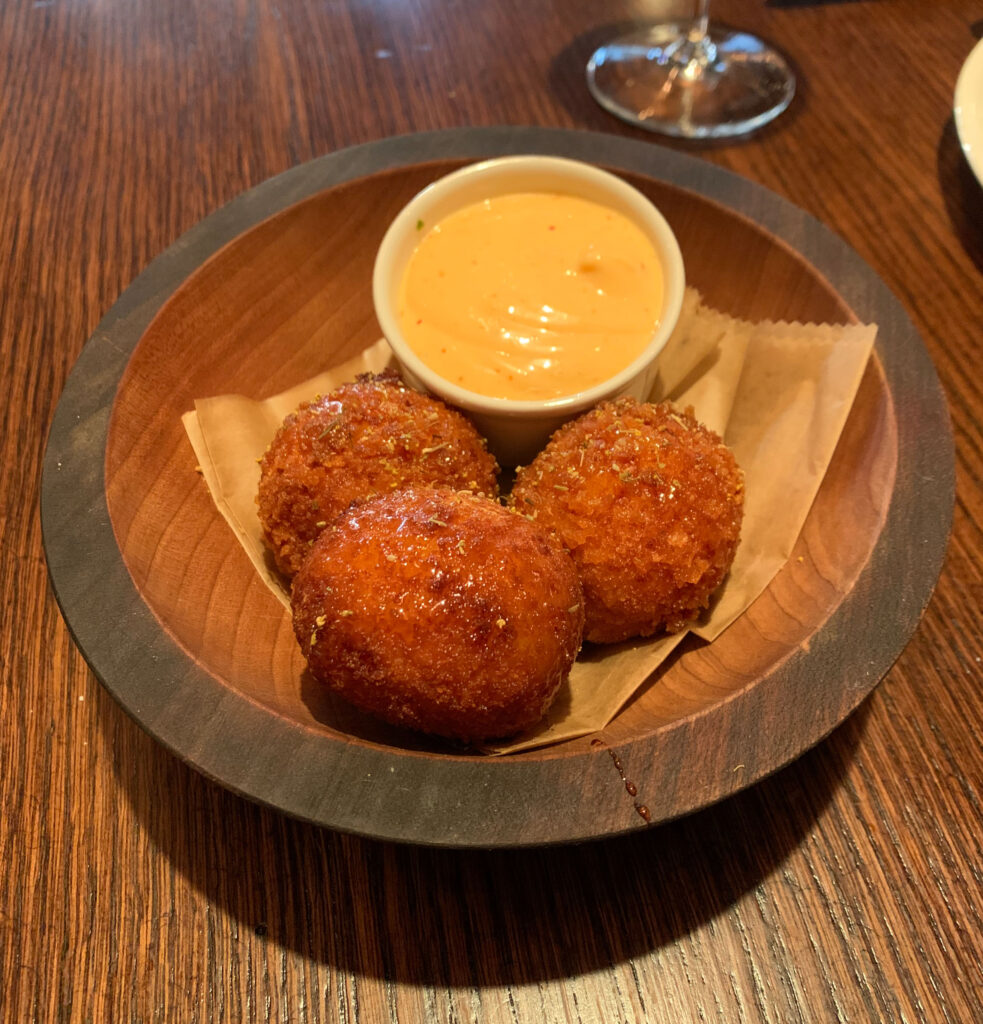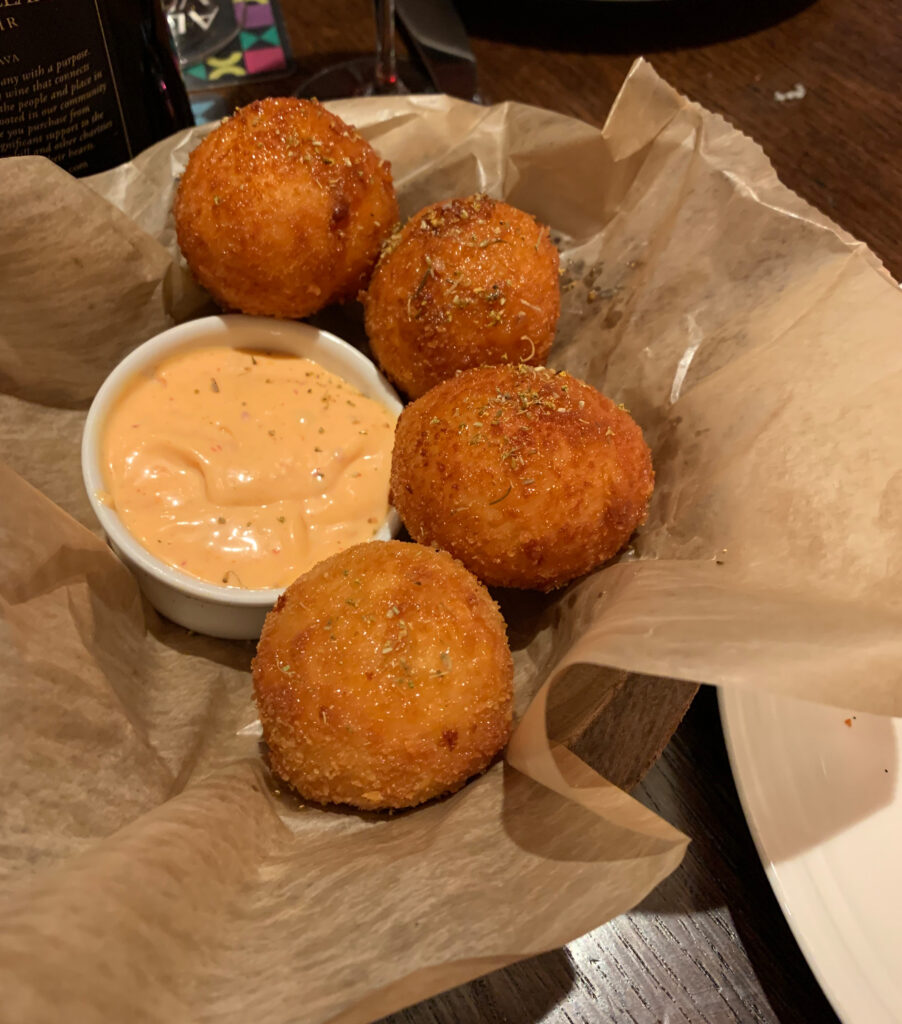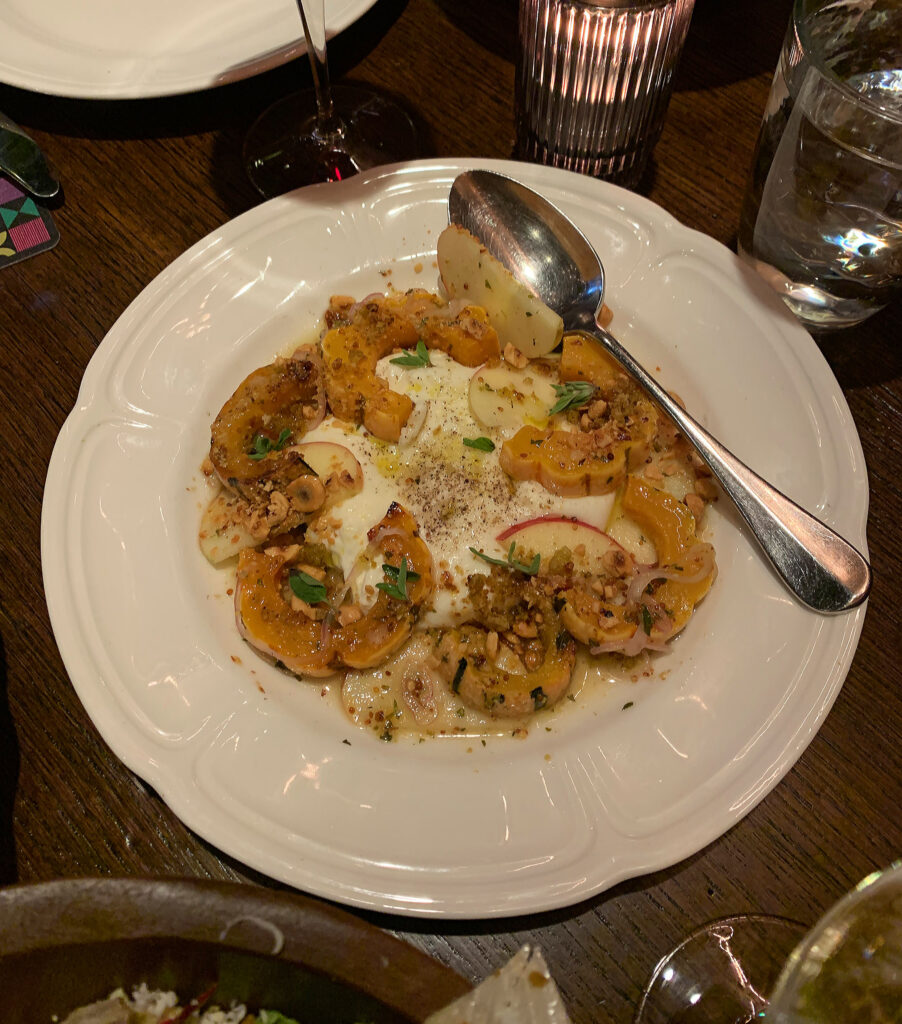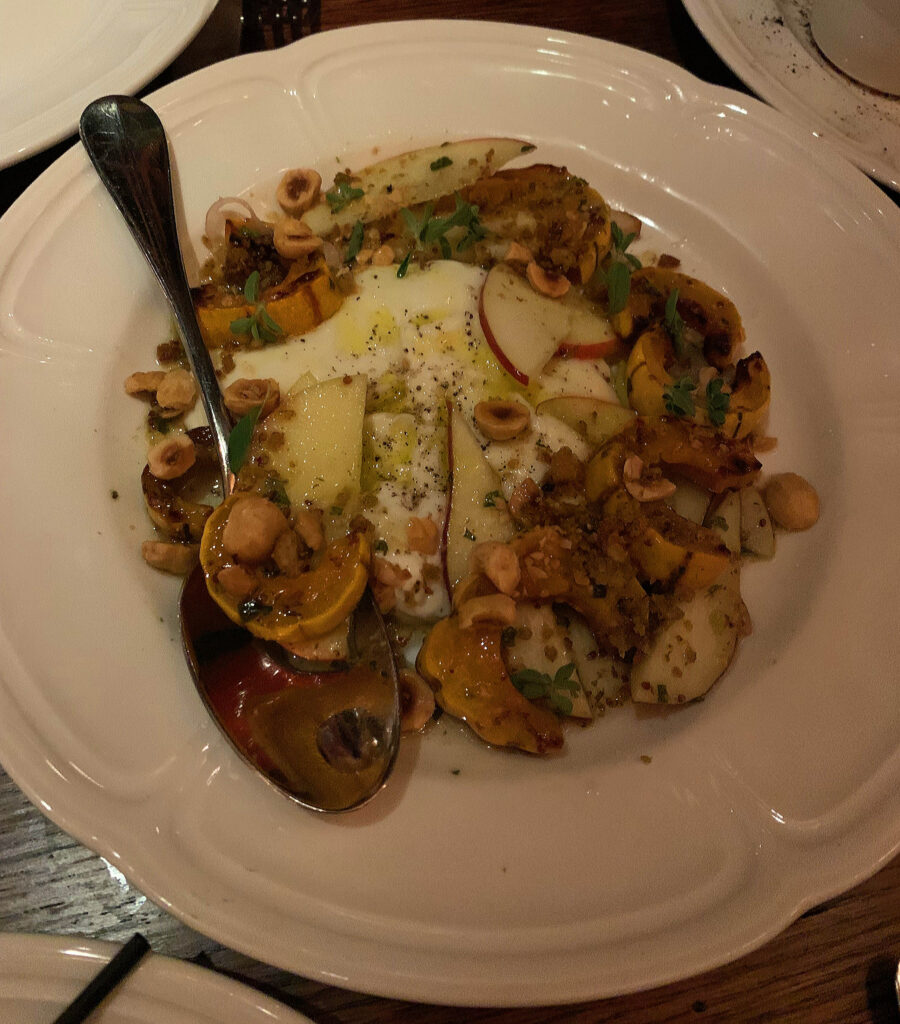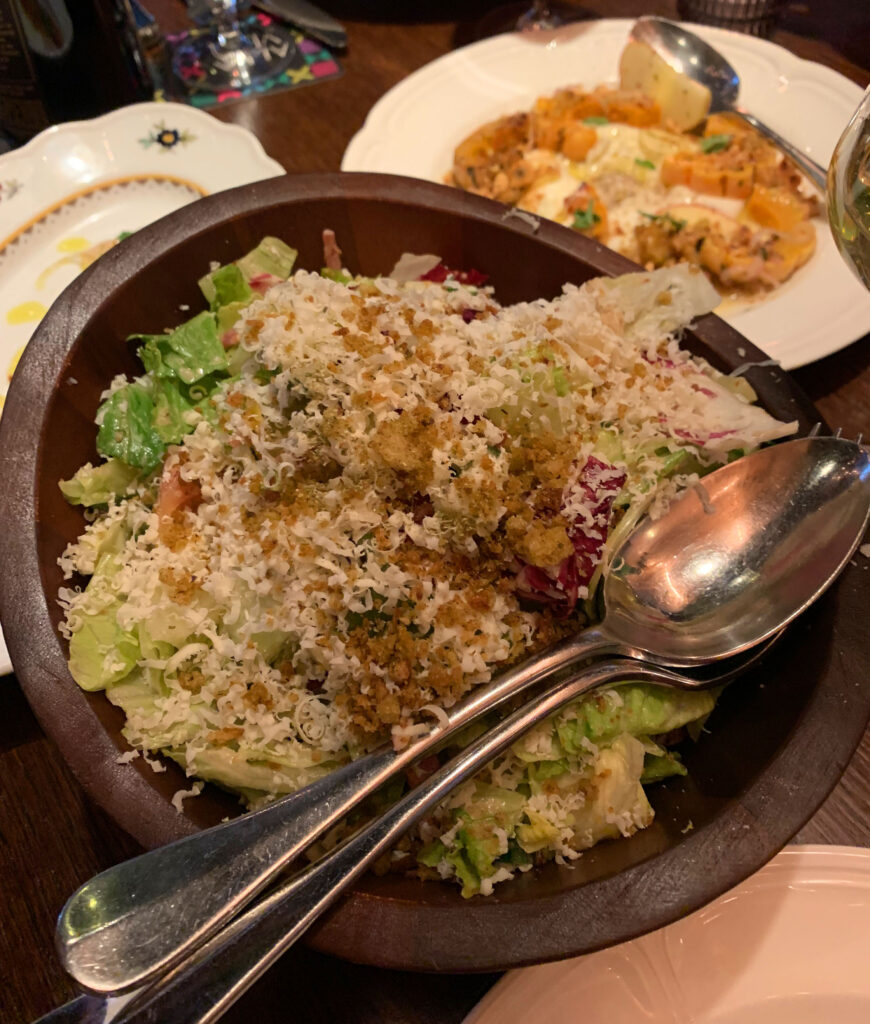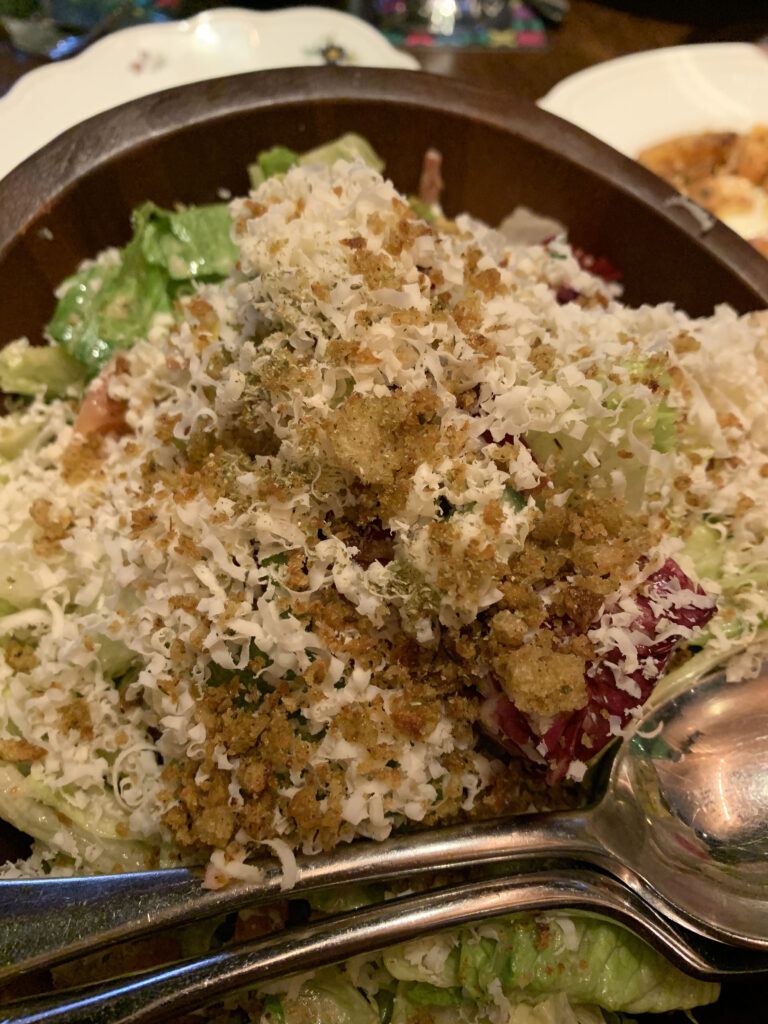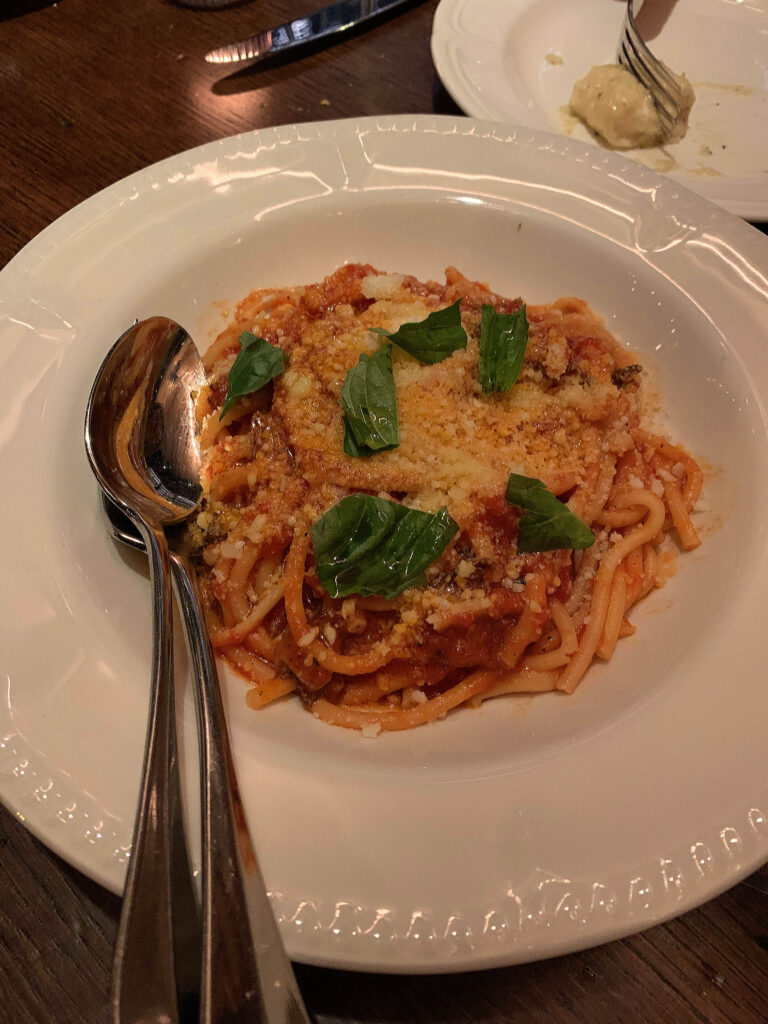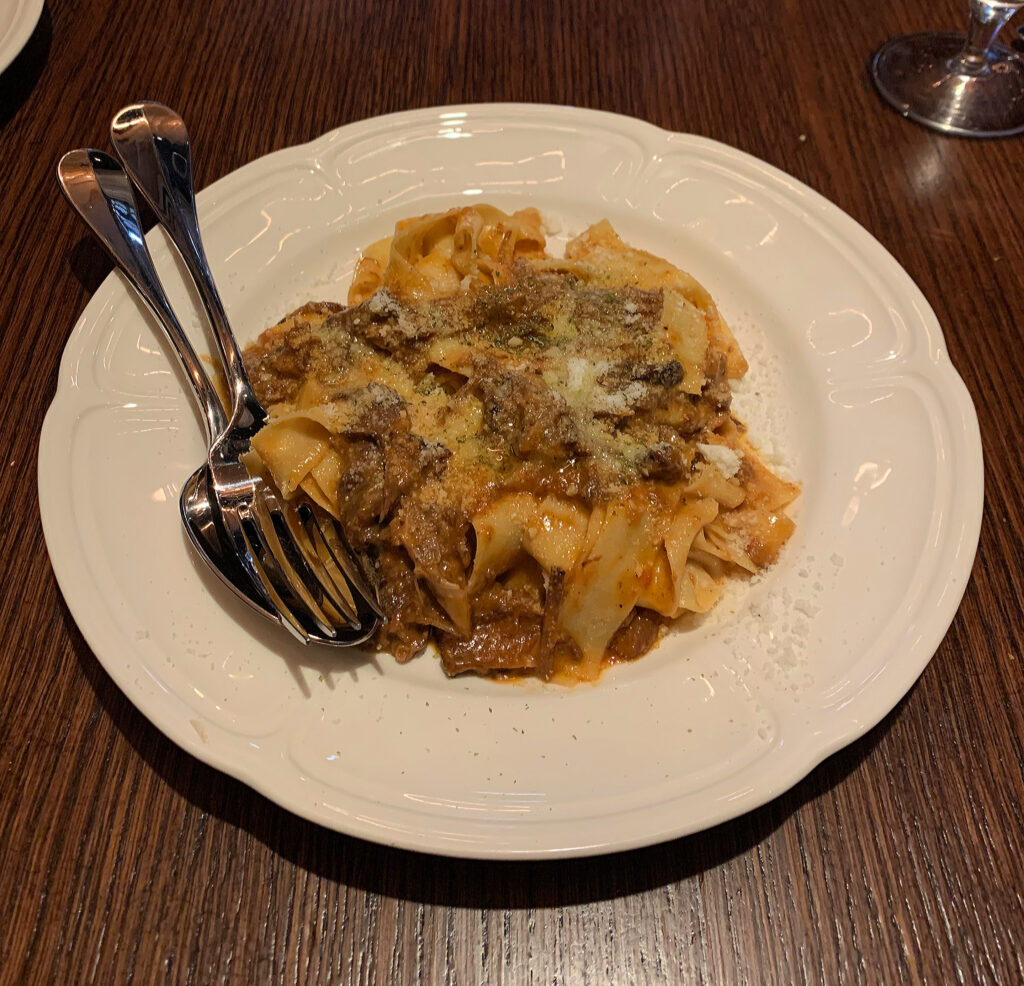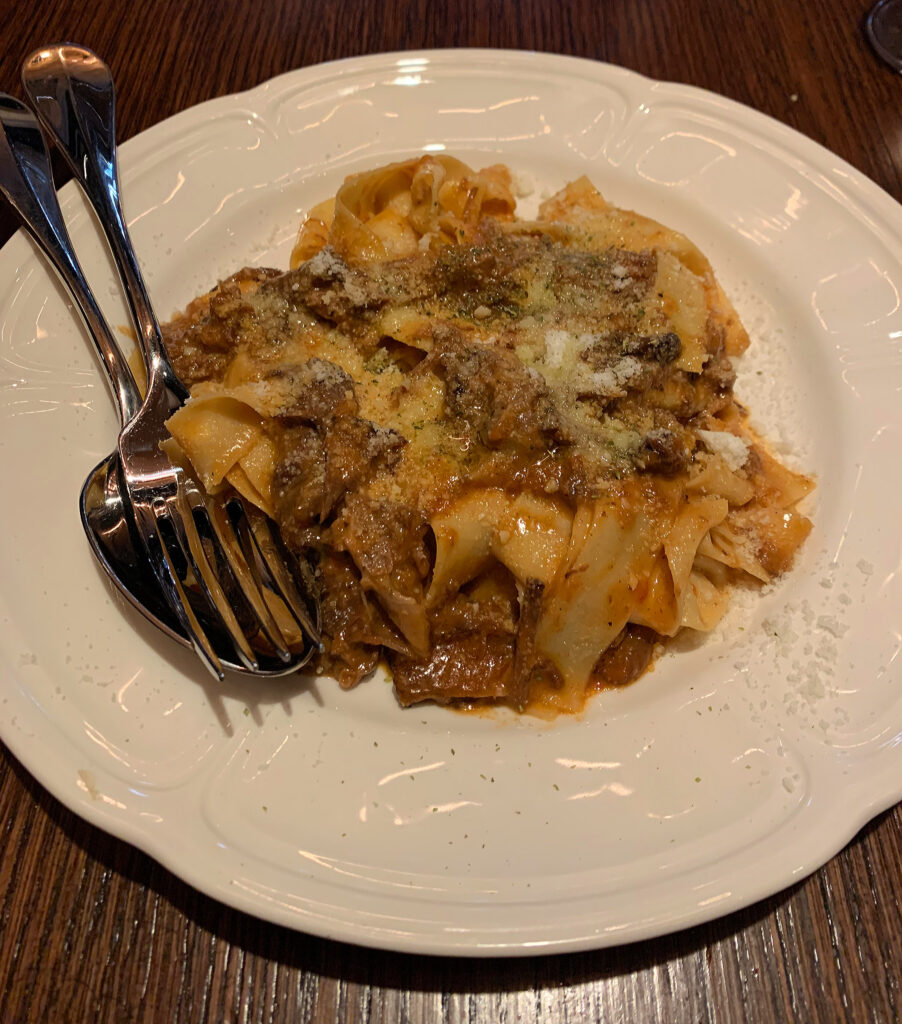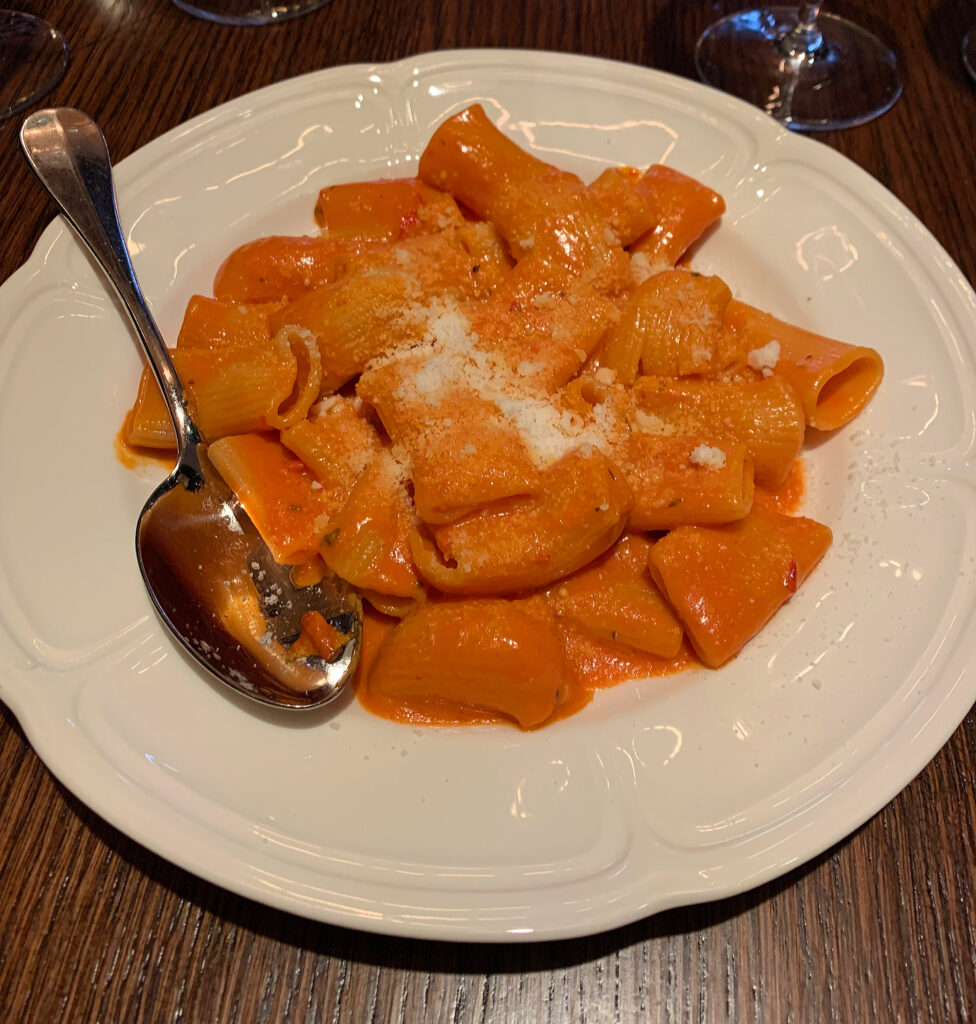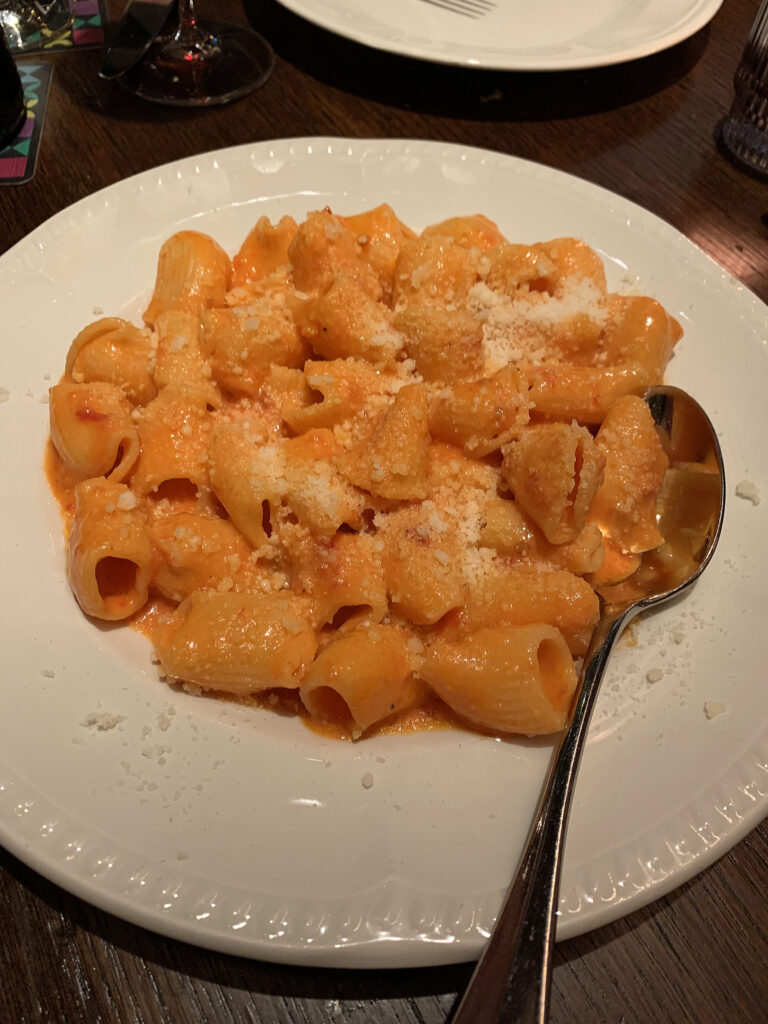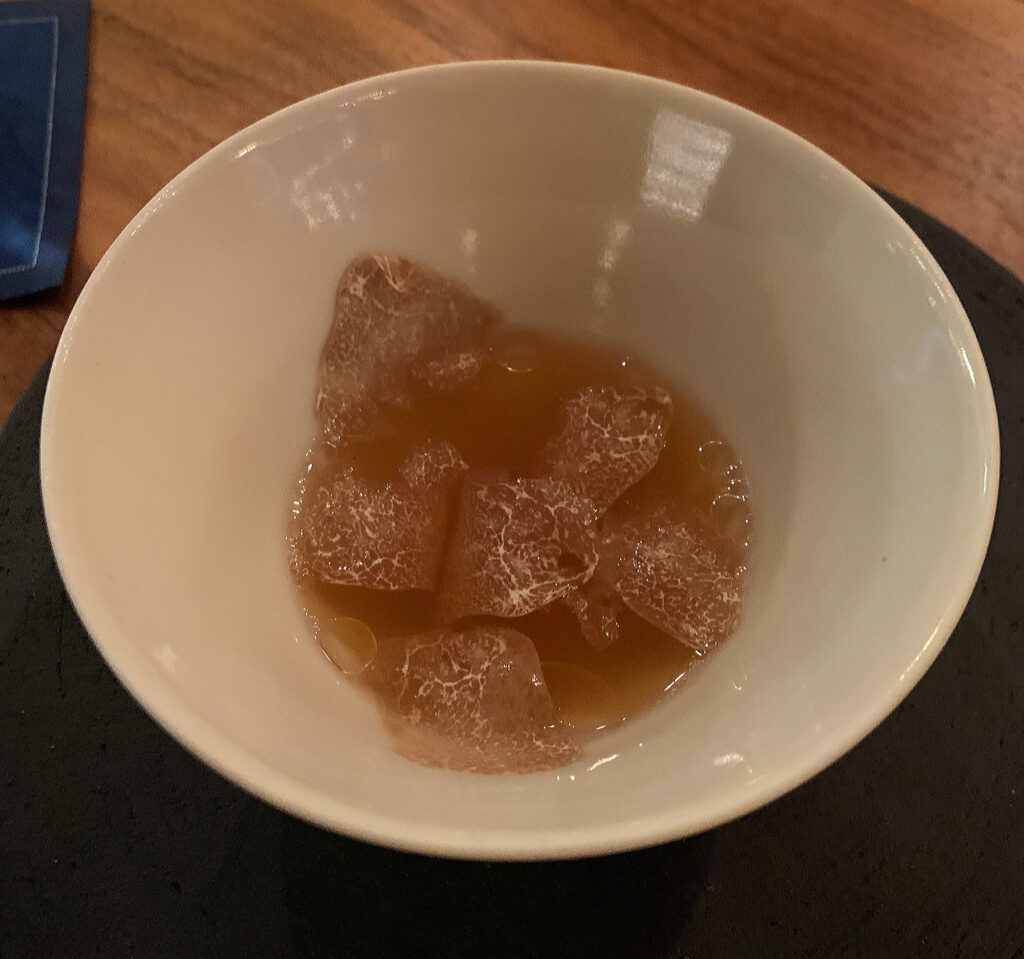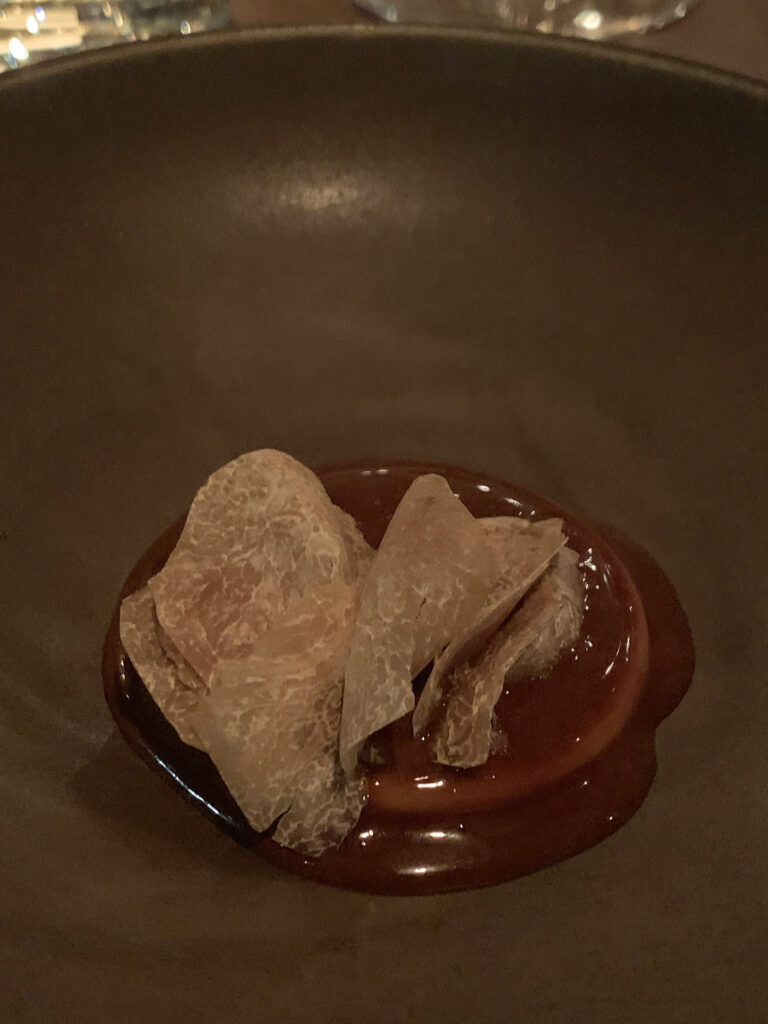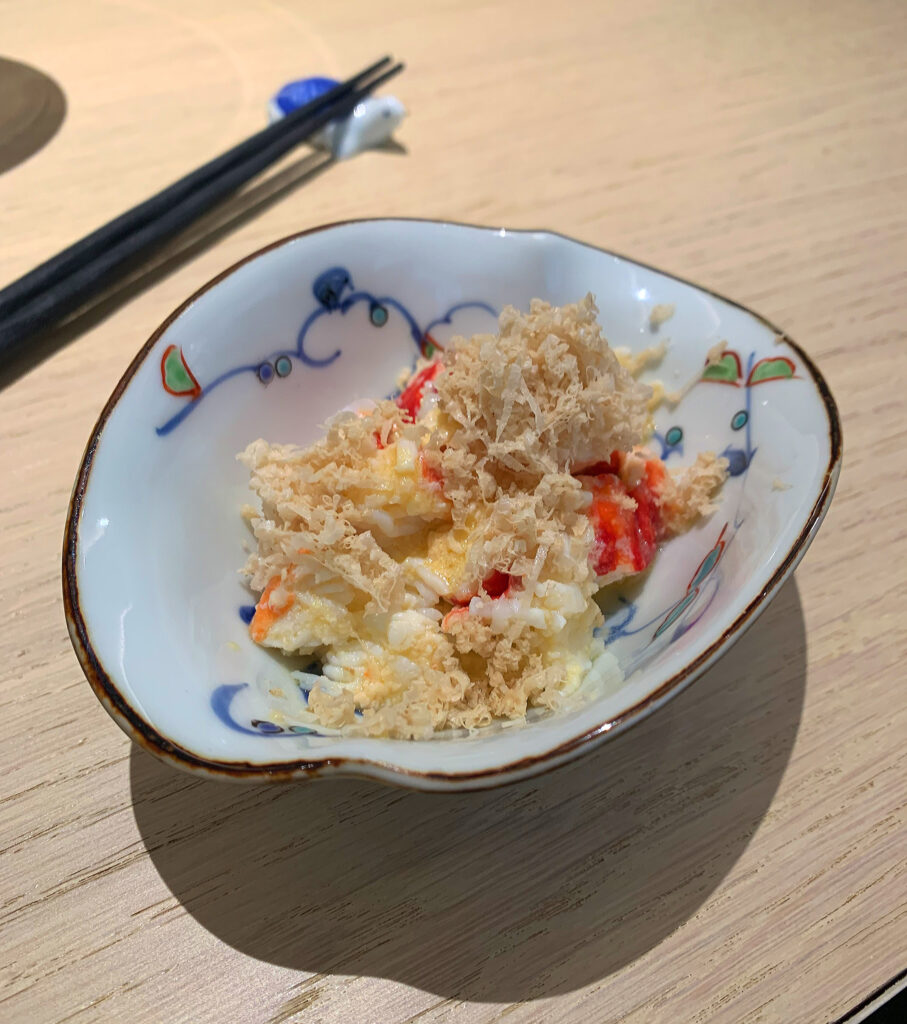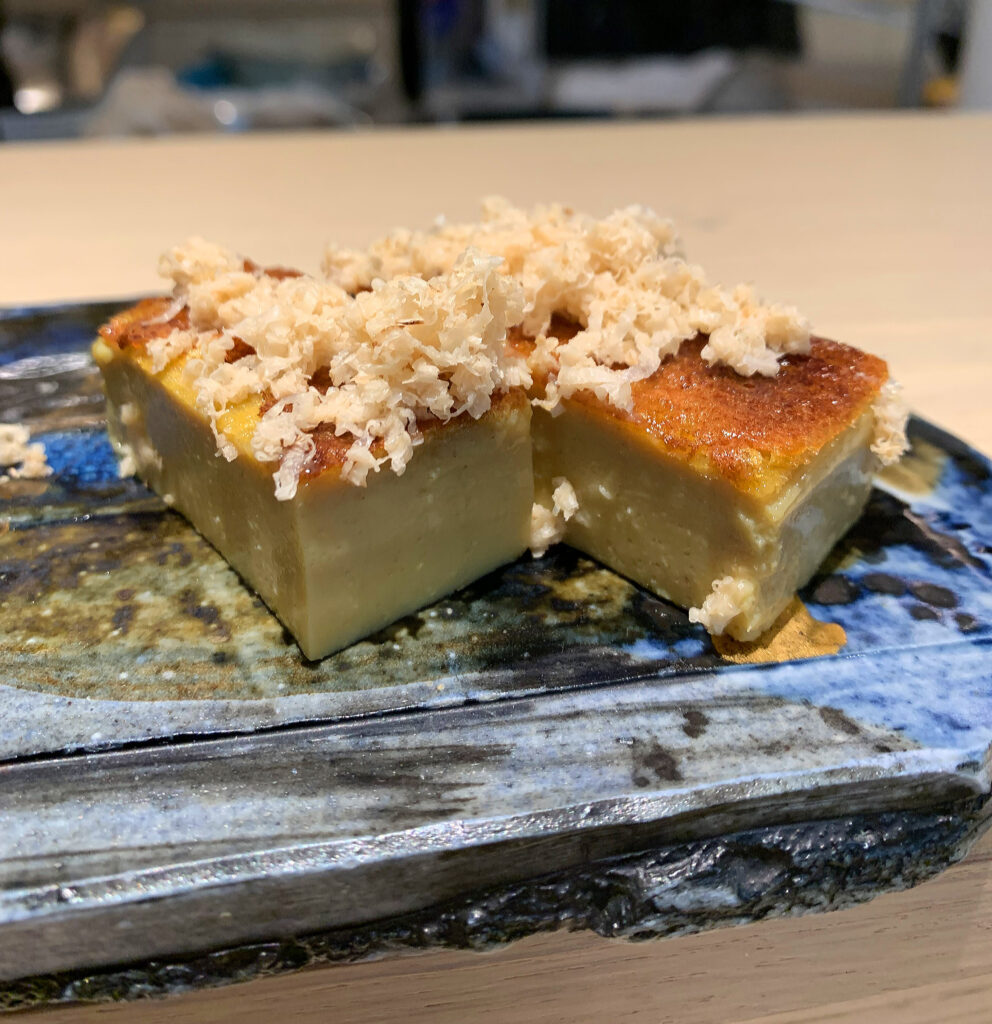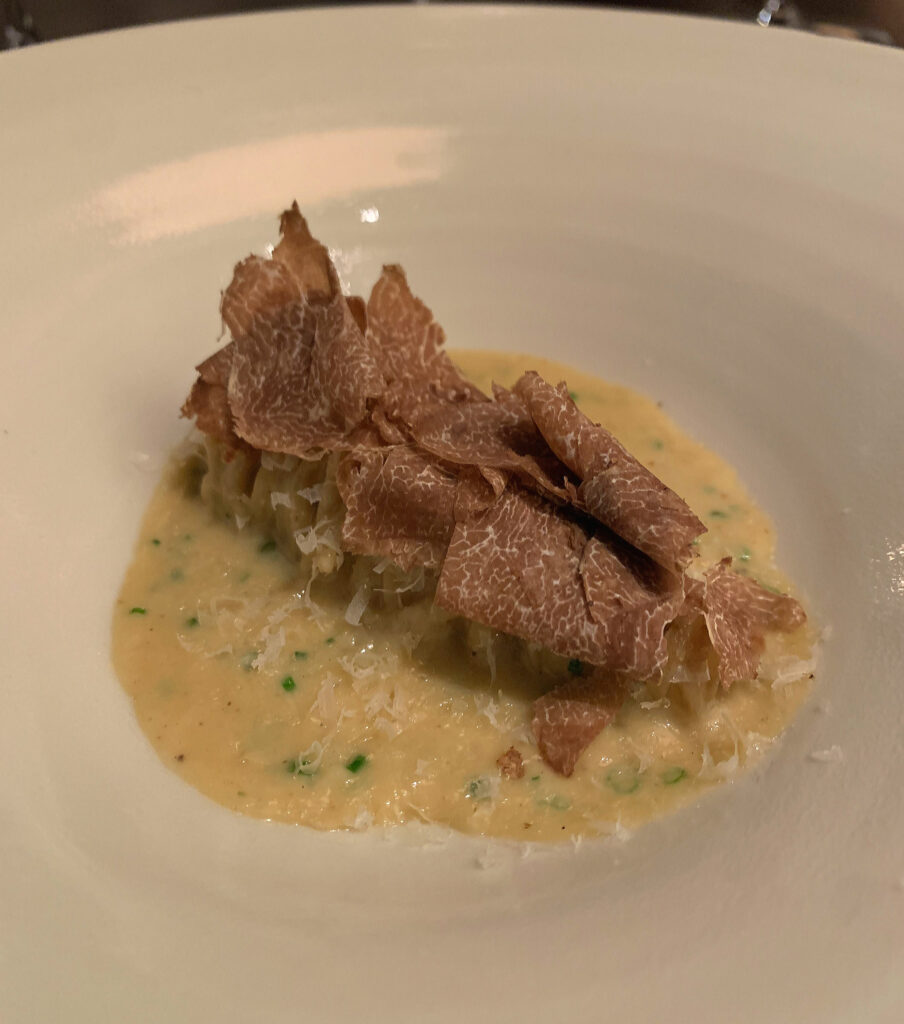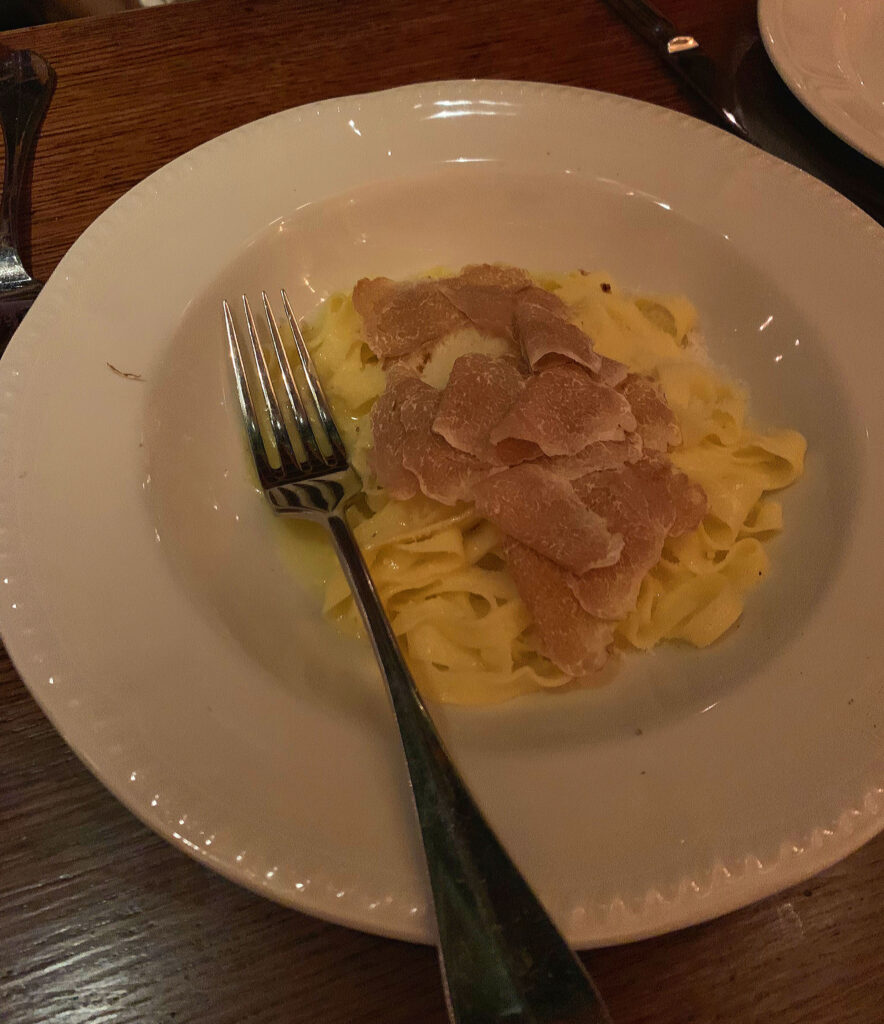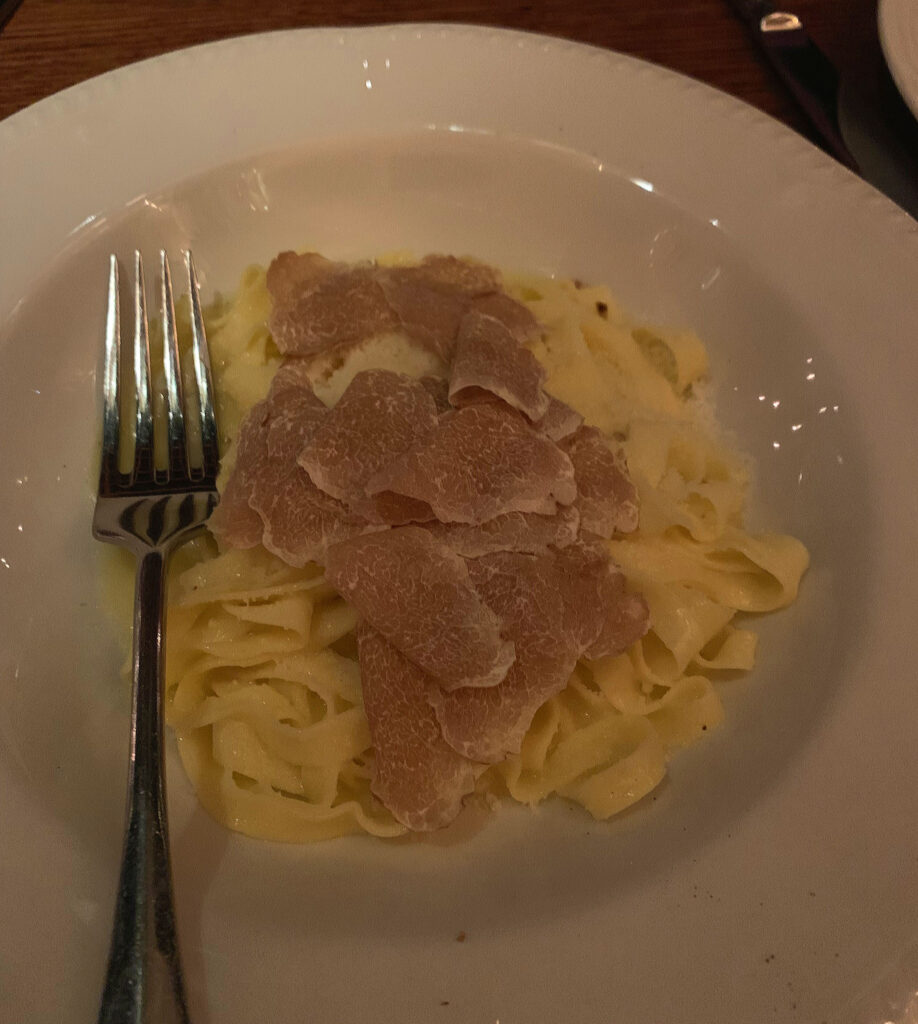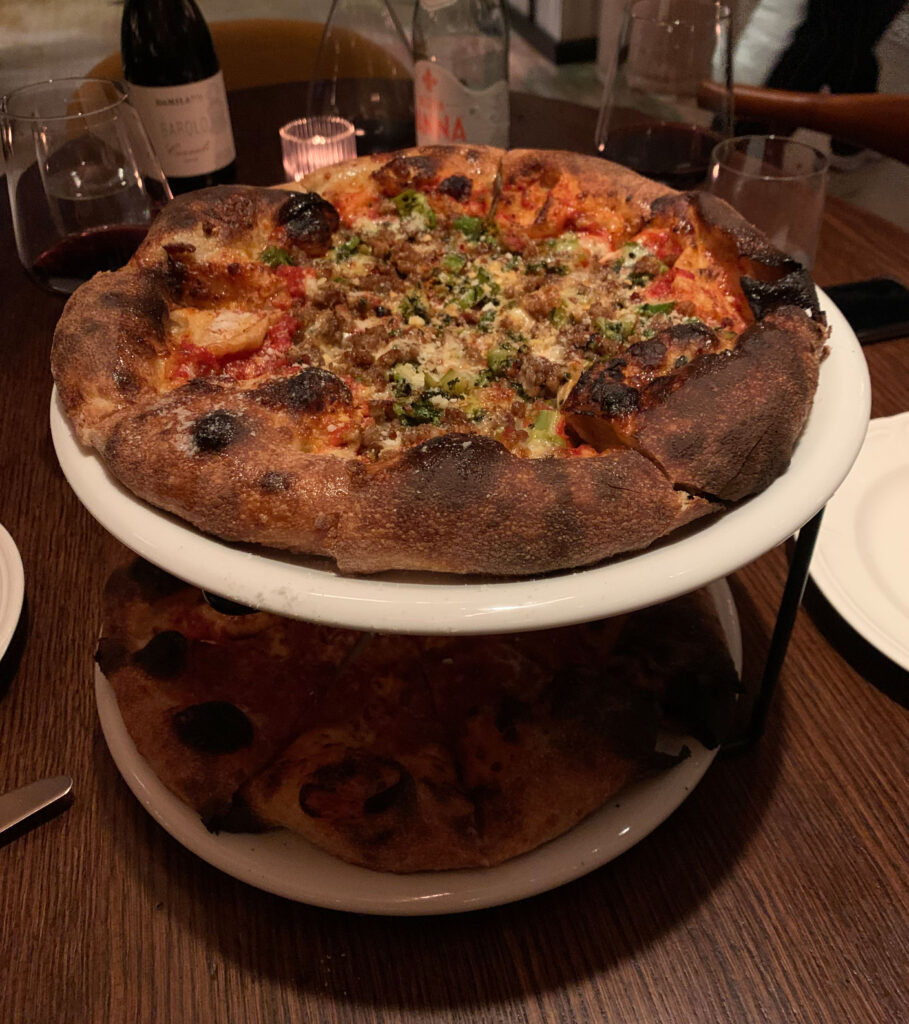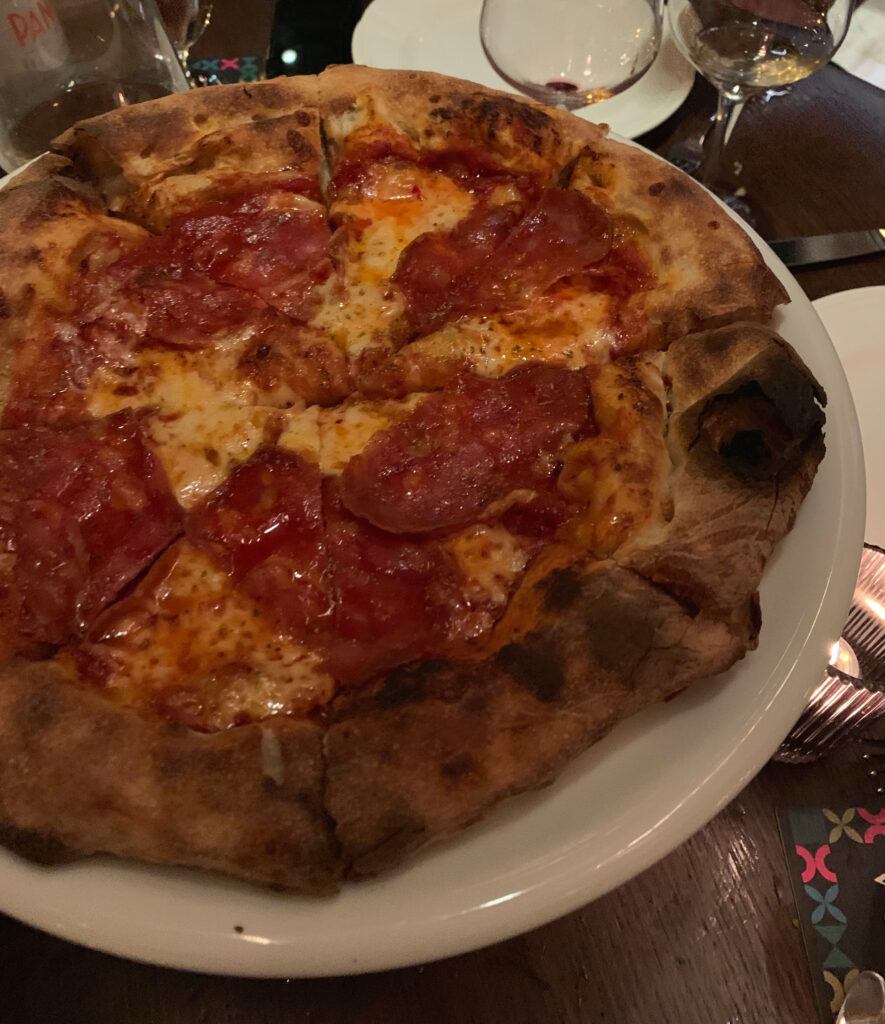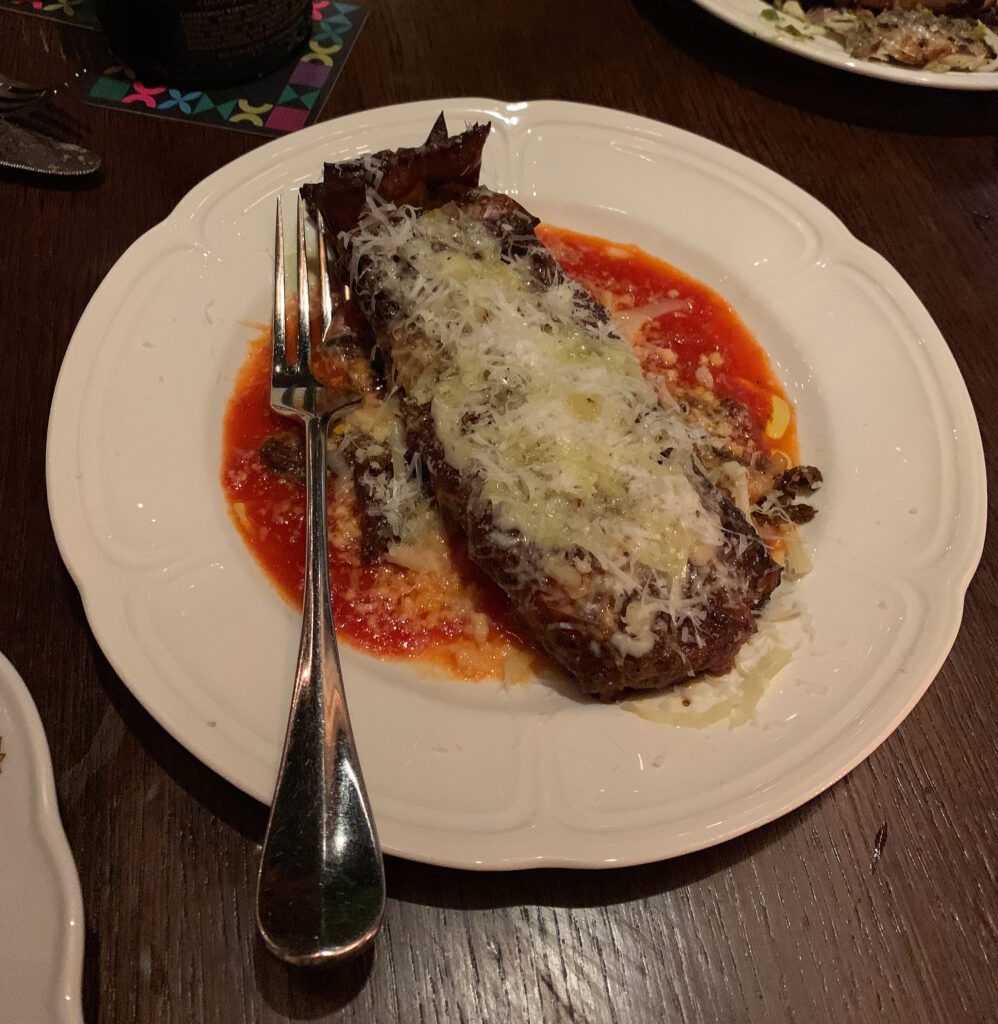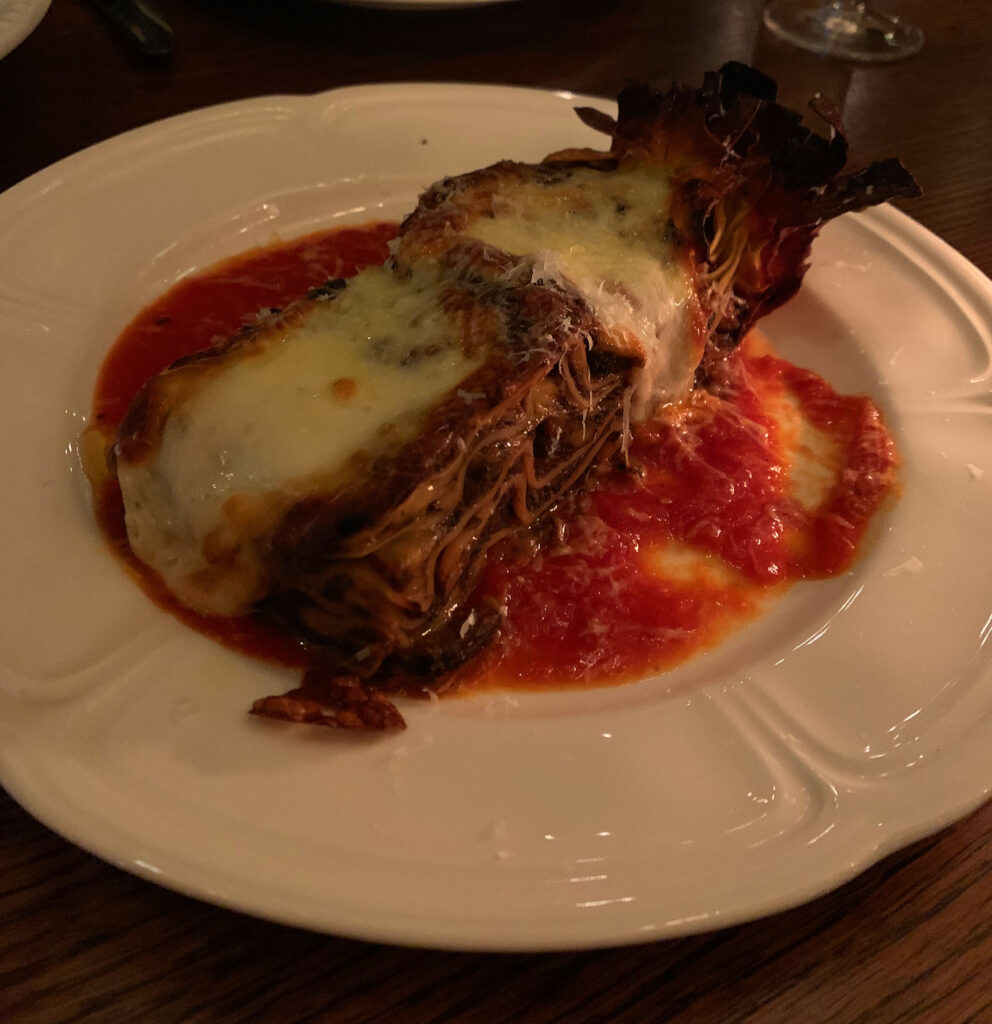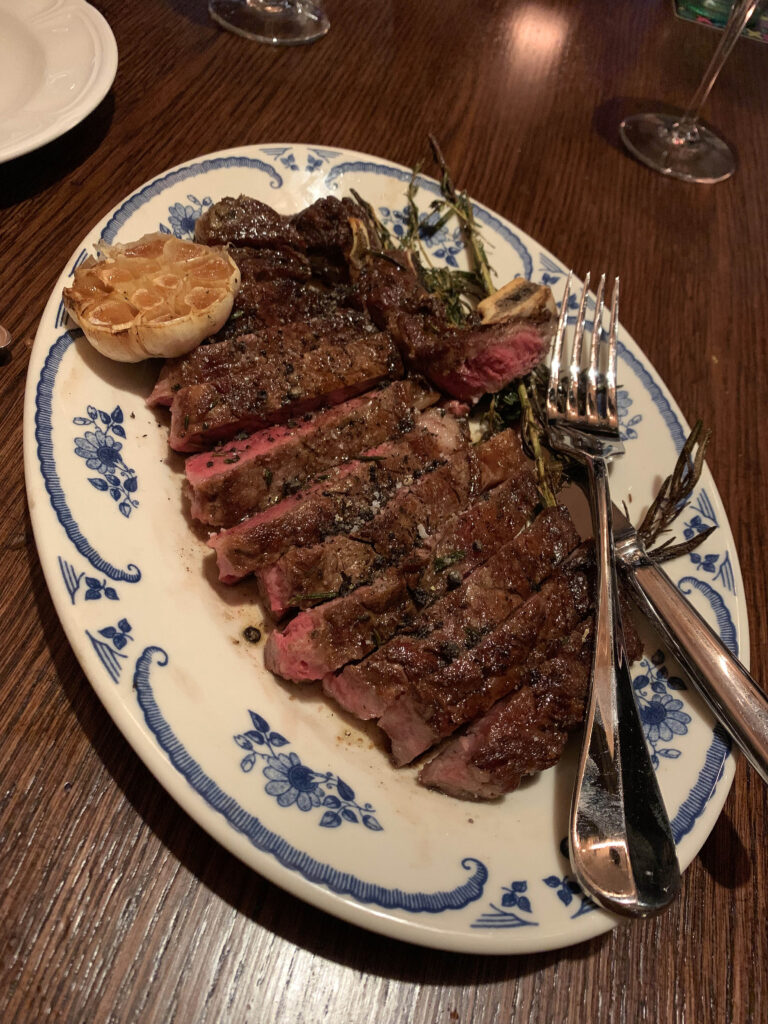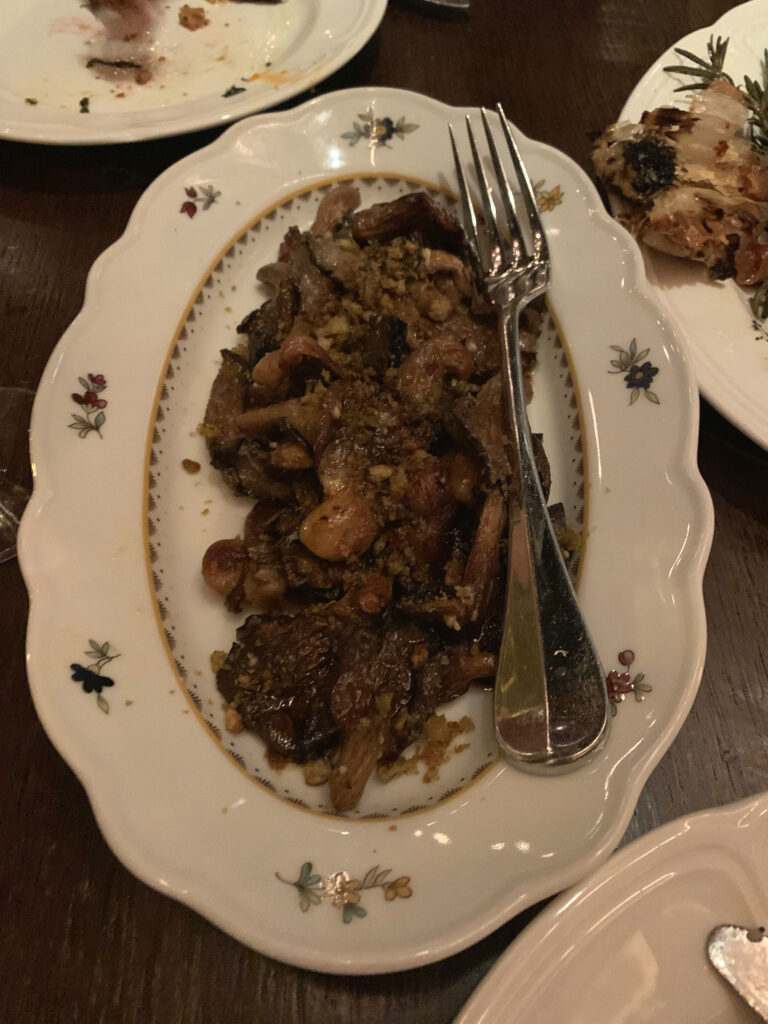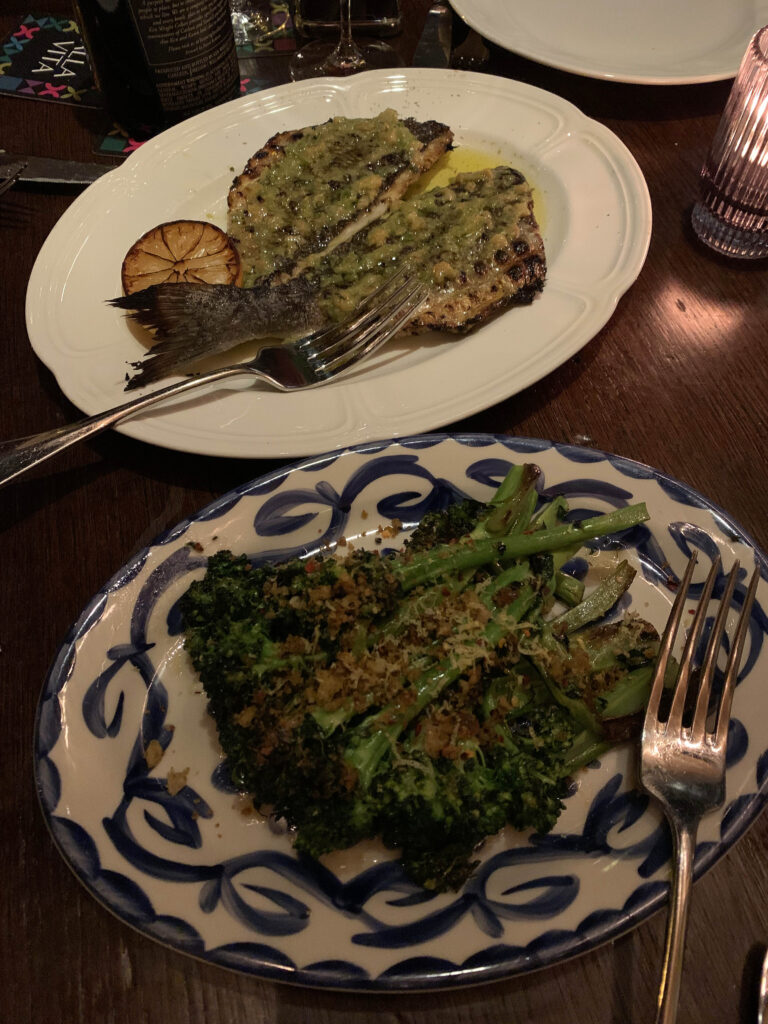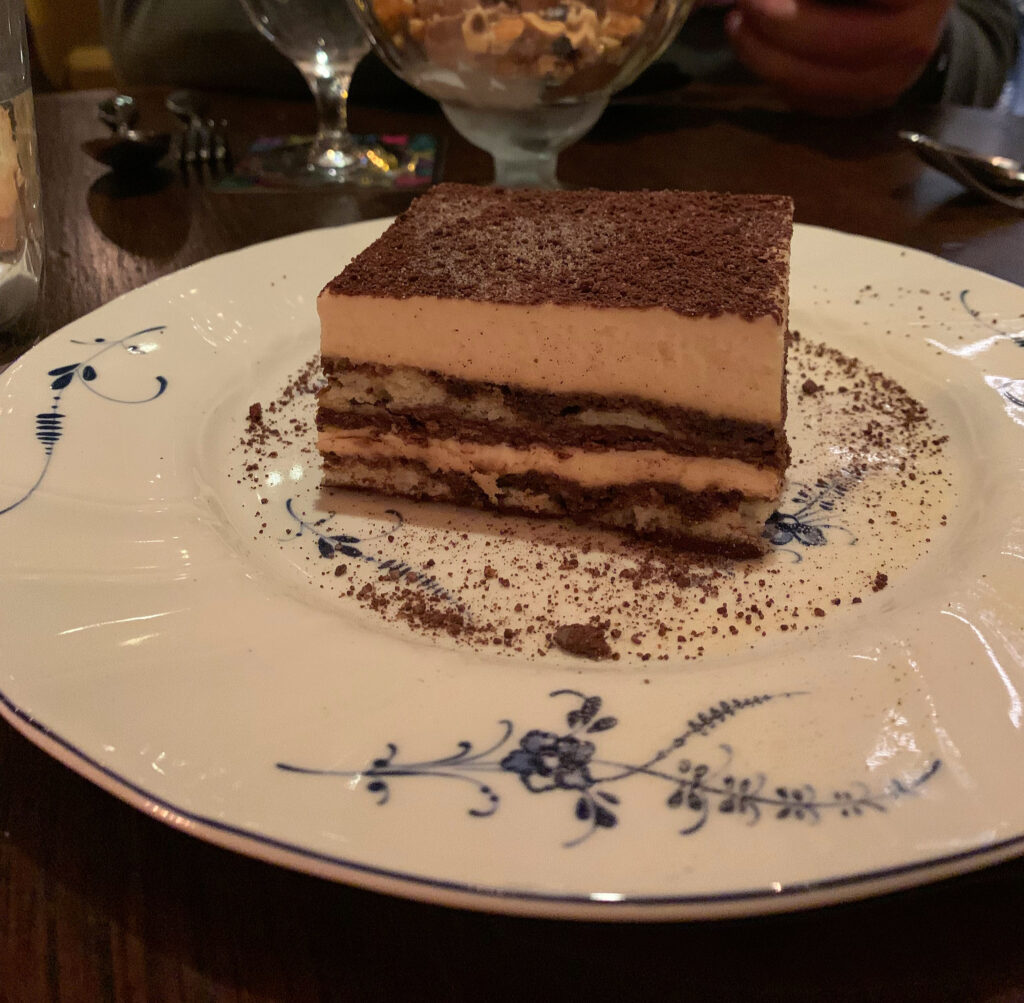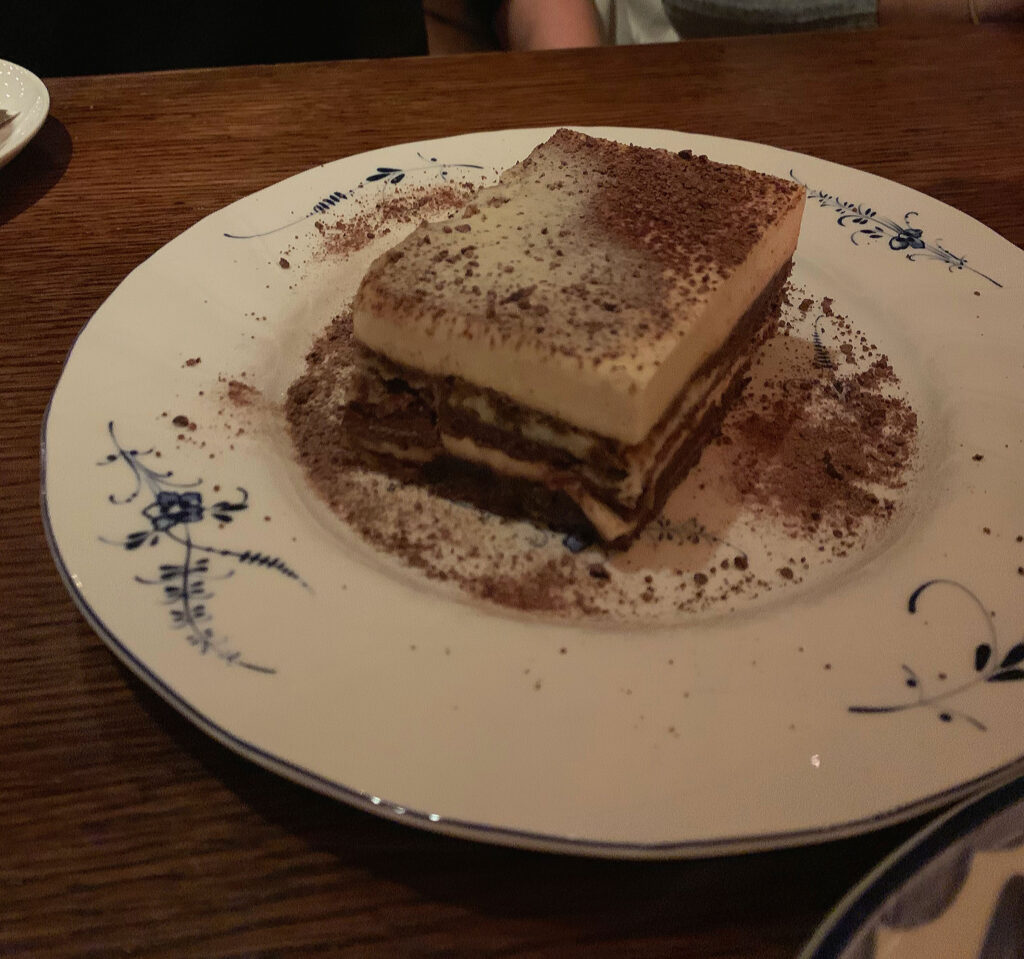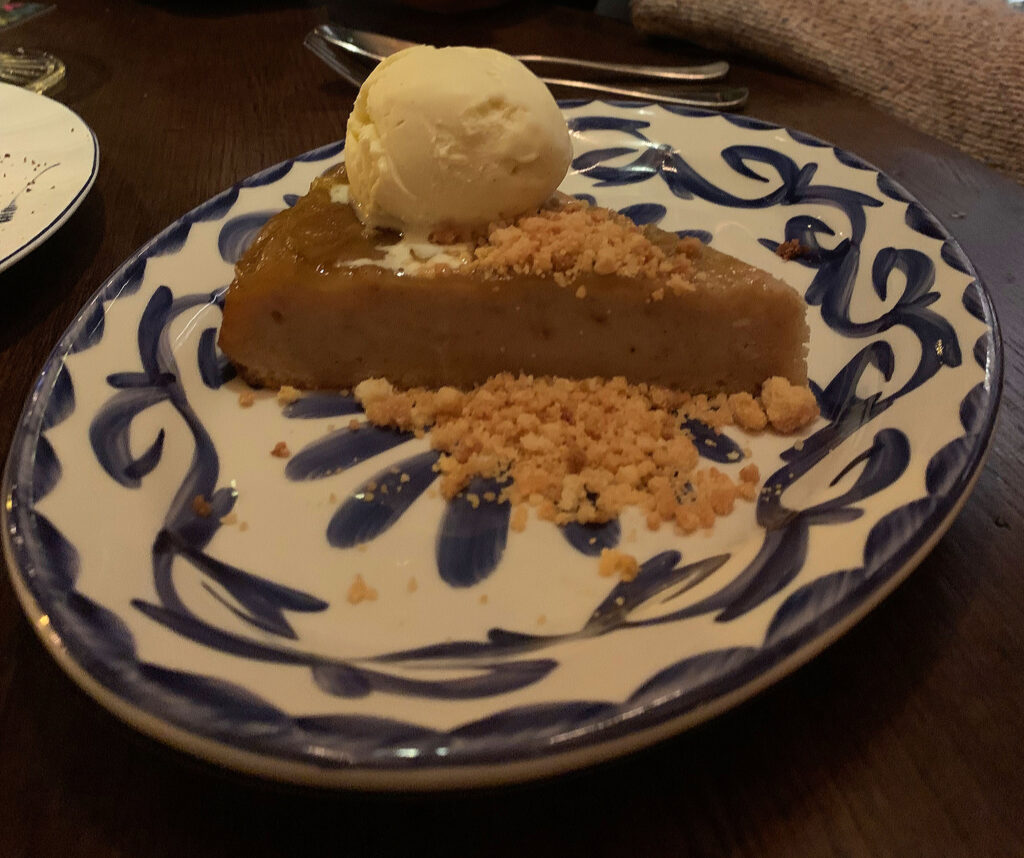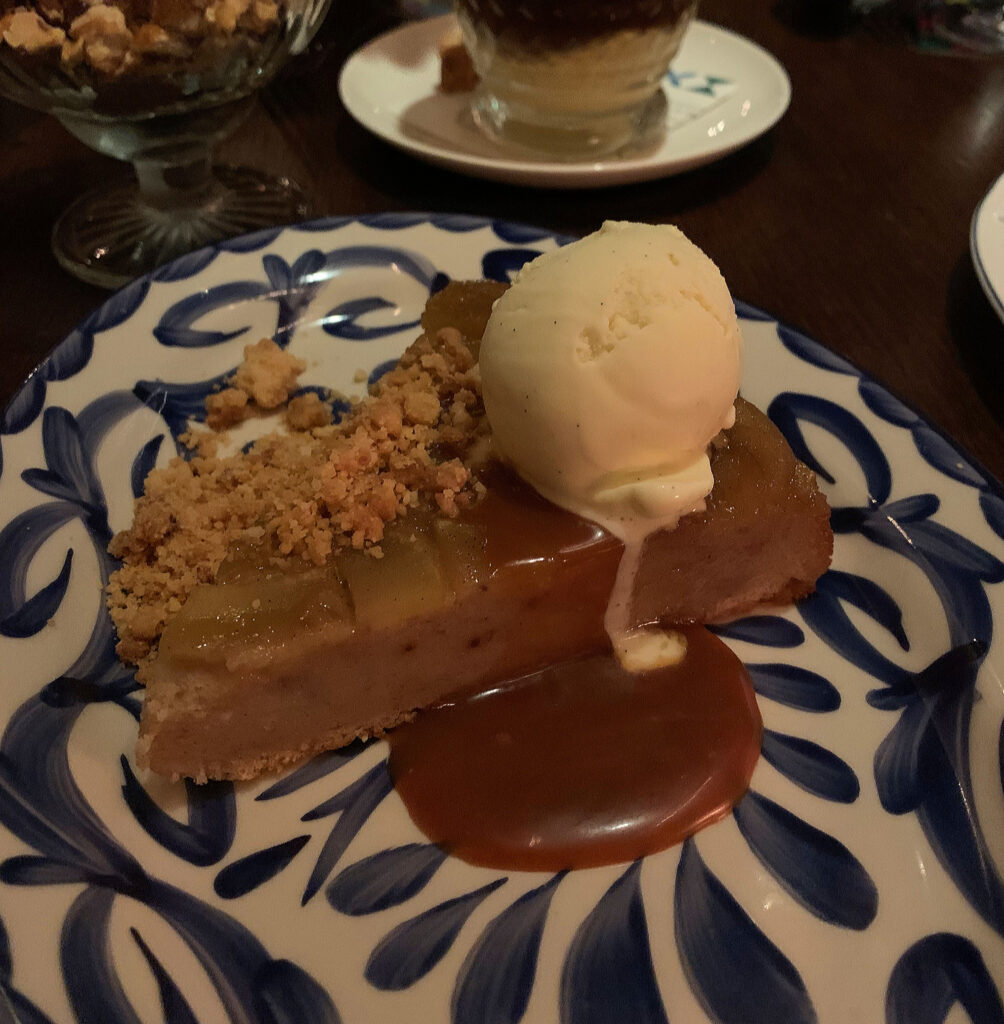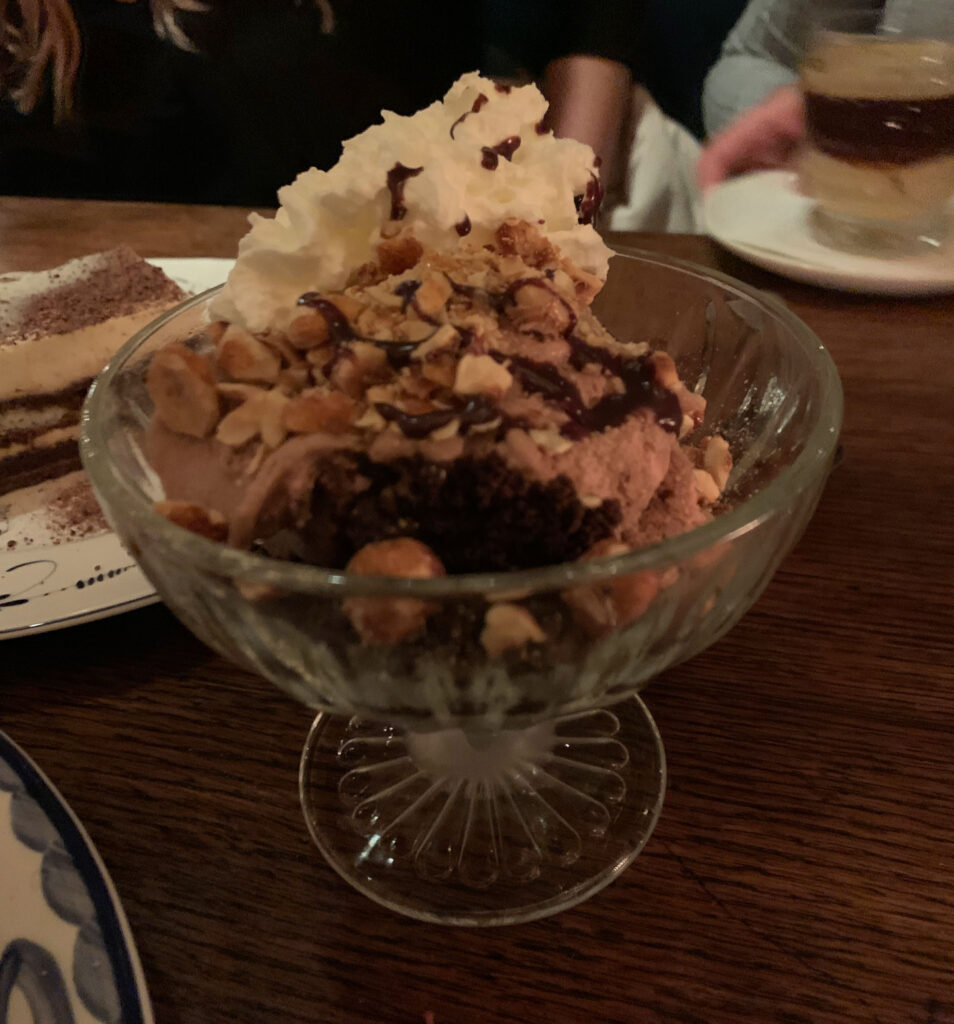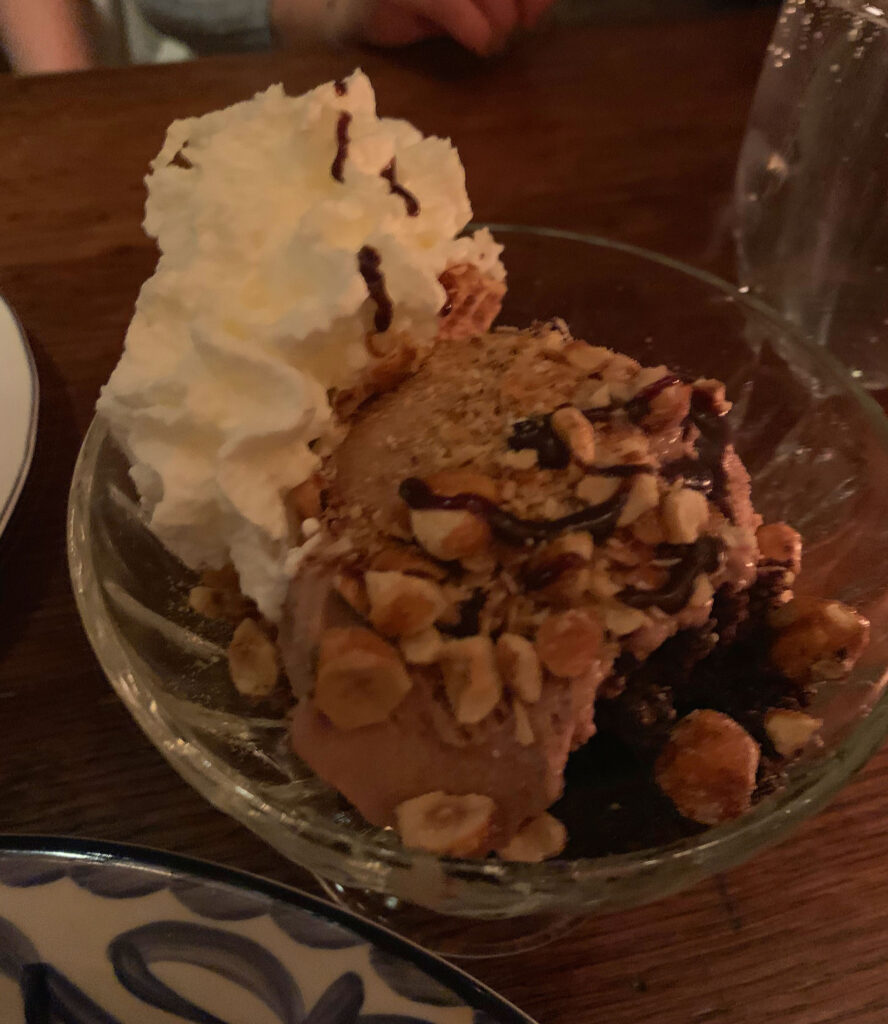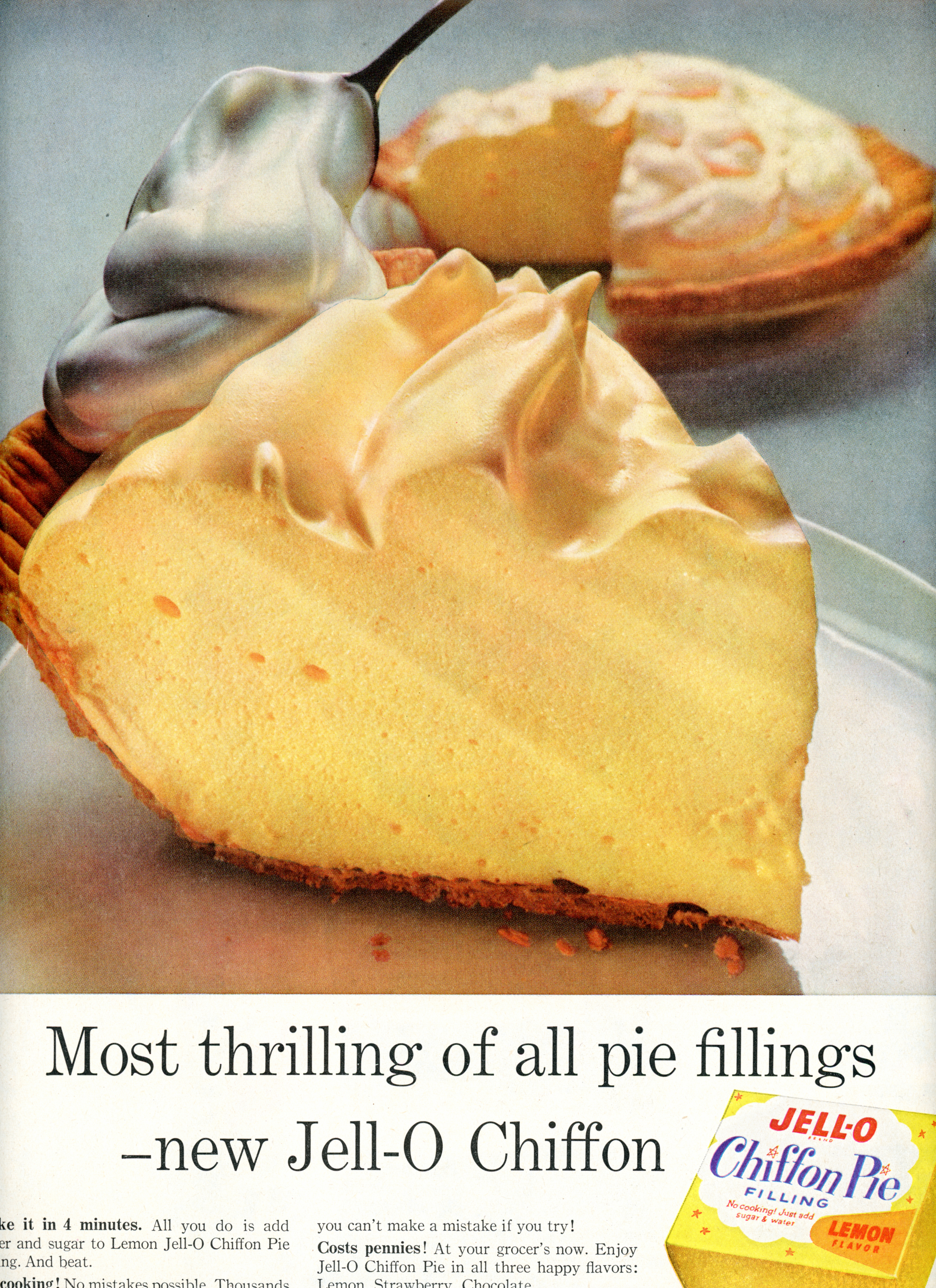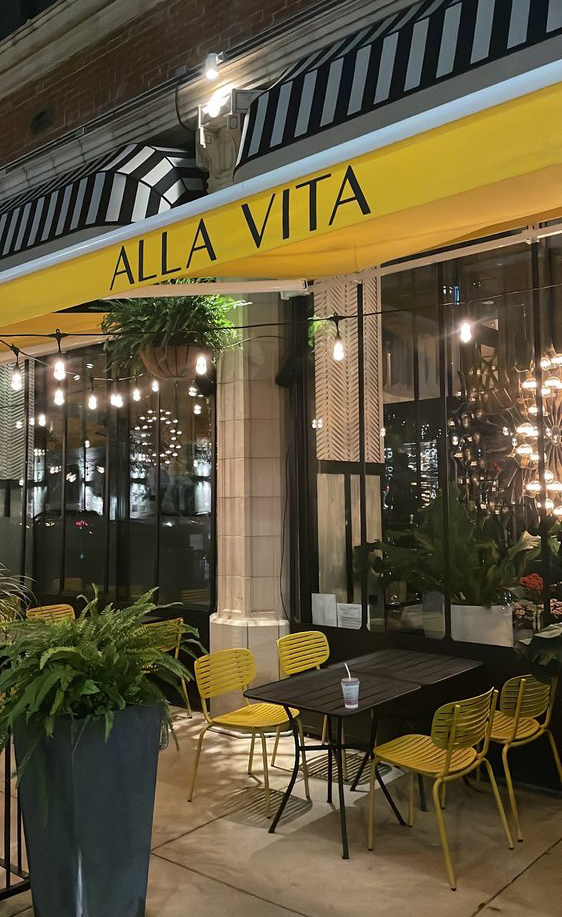
Alla Vita
Relative to Adalina and Elina’s, Boka Restaurant Group’s foray (once more) into Italian dining undoubtedly commanded the most media (and social media) attention this past year. Though Alla Vita comprises more than four times the number of tables as Rusnak and Safin’s joint on Grand, it is every bit as hard to secure a reservation there. Though Alla Vita is also open for dinner seven days a week, it more successfully fills its tables during the Monday, Tuesday, Wednesday doldrums than Adalina. You cannot deny or disparage the restaurant’s successful opening, for its immediate appeal is easily understood. Instead, Alla Vita’s long-term cultural value is best assessed, as always, through careful evaluation of its hospitality and food.
You will look to avoid retreading too much of the same ground as your previous screed, except to say that you marvel at the manner in which the BRG honchos have revived the Bellemore space using the same hackneyed sense of interior design and empty marketing platitudes. They have hooked the same influencers and “food writers” (in Chicago, merely an influencer in disguise) with the same playbook of prefabricated phrases, superficial luxury, and appealing backdrops. And it will take many more months for that glow to fade and for average customers, in aggregate, to decide if Alla Vita—stripped of this hollow halo—has done anything to distinguish itself from a litany of competitors further down Randolph and afar.
Readers who wish to see through this illusion can learn how to do so from your Bellemore post-mortem, but you will look to avoid that combative tone that now comes so naturally when faced with the same gambit. You are not prideful or masochistic enough to rue the opening of a new restaurant in your backyard or root for the demise of an enterprise that, however nauseating its figureheads are, employs plenty of fine professionals engaged in the earnest practice of hospitality. Only the most perverse soul would willingly poison their attitude (and, thus, their palate) against a restaurant before engaging its experience in good faith.
In fact, faced with the choice of going to Elina’s in its second week of business or Alla Vita in its very first week, you chose the latter. Given that you were hosting others, as you always do, it would have been detestable to lead them into a meal with the sole intention of bashing it. Rather, the party had no preconceived notion of what you had written about BRG or their new venture in particular. They provided an invaluable, wholly innocent perspective upon which it was possible to moderate any lingering bias you might have felt. They ensured, first and foremost, that you were going out to have a good time—the ground zero of good criticism—and that Alla Vita’s virtues and vices could be judged in accordance with a typical diner’s experience. With that established, it was easy to perceive the restaurant in isolation from the larger context of its group and your past work.
Back when you oriented Alla Vita relative to its “Italian-Italian” and Italian-American peers, the concept had not yet been quite clearly defined. In May, BRG had originally described it as a “neighborhood Italian-American restaurant.” However, some of the dishes they revealed at that time—vegetarian lasagna, squid-ink pasta, ricotta dumplings, and “neo-Neapolitan” pizzas—seemed more like contemporary “Italian-Italian” recipes. Nonetheless, the “giant bowls of chopped salads,” chicken parm (“don’t look for a veal variant”), and “an eggplant version” [rather, the original recipe upon which the chicken one is based] certainly spoke to Alla Vita’s supposed Italian-American character. Given this stylistic schizophrenia, you oriented the restaurant only slightly towards the traditional and Italian-American quadrants of your chart. Truth be told, it was rather close to the center.
By the time it opened, Alla Vita defined itself as a “casual, family-style” place for “diners of all ages” to “gather and enjoy comfortable Italian cuisine.” The restaurant, since being previewed, had done little to define its menu as particularly Italian-American and, wisely, backed away from using the term. (Though that didn’t stop a certain “critic” from thoughtlessly perpetuating that half baked identity while, simultaneously, denigrating the entire tradition. Does BRG really need that much help to sell their concept?)
Instead, Alla Vita opted for a simpler self-definition free from any particular label: “Lee Wolen shares his passion for fresh, delicious Italian food made simply with the best ingredients.” Such a description speaks more towards an overall philosophy than it does promise fidelity to a specific canon or faithfulness to an idealized tradition. It’s a permeable construction that can effectively be applied to both the “Italian-Italian” and Italian-American dishes on the menu that had already been revealed, sidestepping any nasty questions of coherence or “authenticity.” It also provides Wolen—a Michelin-starred chef strangely described as having “a particular affinity for chicken”—with plenty of freedom to interpret recipes on his own terms and craft some singular vision relative to other restaurants within the genre.
The most interesting element of Alla Vita’s marketing, by your measure, is the persistent focus on “family-style dishes designed to be shared amongst diners.” While this style of eating is certainly associated with the heaping portions served at red sauce joints, BRG and Wolen have situated the practice as “a rejection of the pandemic isolation that loomed over much of the past year.” This theme can even be traced to the restaurant’s nonsensical, metaphrase of a name. “Alla Vita” (“to life”) is not a native expression in the Italian language but has been engineered to underline that same sense of communal spirit.
The restaurant, as branded has little specifically to say about Italian cuisine. Rather, that genre merely forms the wrapper for a sprawling establishment that can cater to large groups, young and old, who will get to sample a wide variety of bites. Reading between the lines, this is a crowd-pleasing, casual concept driven by high volume and an emotional appeal. It is not a place to be judged on the intricacy of its food, but rather on pacing and execution. However, the hospitality and setting should conjure all the glory of those wondrous nights on the town that the pandemic deferred. Alla Vita is aiming to satisfy a feeling more than any intellectual engagement with the bread and butter of its menu. You find that to be an interesting prospect and one worth keeping in mind throughout your analysis.
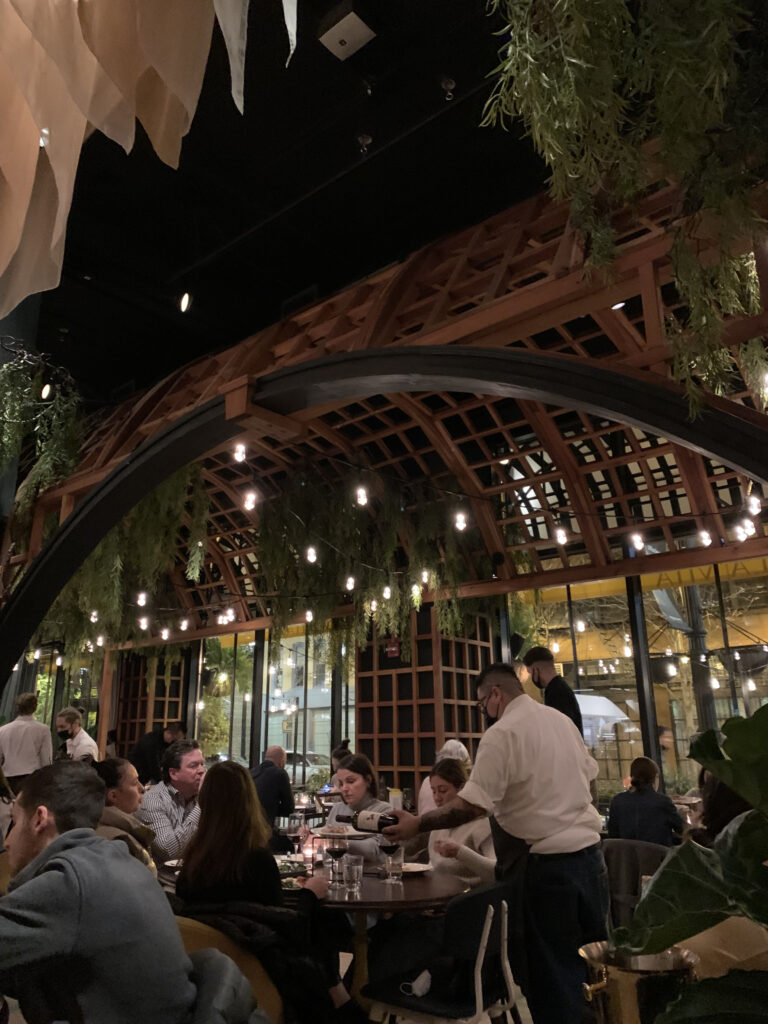
Tasked with shaping the sort of ambiance that would stoke that emotional fire was Kehoe Designs. They were charged with transforming the former “Mr. Bellemore’s manor,” as imagined by Studio K, into something flowing and functional. Kehoe would mark the third firm to put their stamp on the dining room since 555 International had first designed it for Embeya in 2011, but you do not think there was anything unceremonious about Studio K’s exit. For Karen Herold’s team has continued its longstanding partnership with BRG—most recently on the opening of Girl & the Goat’s L.A. location—and Alla Vita, perhaps, simply did not demand (or deserve) their special touch. (Bellemore, however superficially luxurious, never felt visually coherent or all that comfortable. You credit Boehm and Katz for not mindlessly dumping more money into the property).
Rather, with Kehoe Designs, the BRG honchos contracted a “full-service event design and décor company” to shoulder the creative burden. The Chicago-based company, which touts “more than 20 years” of experience, seeks to “create a reaction, generate an emotion, and stimulate untapped possibilities” through its work. In their own words, they “develop high style concepts that are authentic and captivating.” However, in practice, their experience has principally comprised weddings, corporate events, mitzvahs, social events, and galas.
Yet is visiting a restaurant not just a recurring event when you get down to it? Might there be something to the idea of grafting party-planning expertise onto a perpetual form of hospitality? Surely, the dawn and dominance of the “clubstaurant” has demonstrated that the lines between eating and entertainment are increasingly blurred. Certainly, Alinea and Rainforest Cafe have long subjected Chicagoans to a kind of fantasy that succeeds (sometimes) because it subverts the expectations and associations of a typical dinner. Barton G., though his Windy City outpost did not last very long, aimed right for that same nexus. So why couldn’t a dedicated event designer bring some interesting ideas to the table? Kehoe was a bold choice for BRG, and you respect that they took a chance on an unconventional firm with every motivation to excel when branching out into a somewhat new domain.
With the stage now set, your analysis can proceed. Alla Vita opened on September 13th, and you have visited the restaurant thrice since then. The dinners were spread across September, October, and November, ensuring you had a chance to sense the restaurant’s consistency and evolution since opening its doors. All of your visits were conducted in groups of three to four guests possessing reservations and receiving traditional table service. As usual, you will condense the sum of your experiences into a cohesive narrative form that will comprise the totality of your thoughts.
That being said, let us begin.
The corner of Jefferson and Randolph has seen better days.
Yes, Proxi and Sepia still shine for their combination of quality and value (while also possessing one of Chicago’s deepest wine lists). Jinsei Motto’s residency has breathed new life into CH Distillery, and Wishbone stands as one of the city’s busiest weekend brunch spots. But losing Blackbird was a bitter pill to swallow, and dearly departed Yūgen—though its owner remains mired in controversy—offered, under Mari Katsumura, one of the most creative and delicious tasting menus in town (along with some kickass burgers, fries, and canelé milkshakes to boot).
You’ve described Bellemore’s demise in great detail before, a sad loss given the glimpses of genius Jimmy Papadopoulos had shown during the pandemic (finally able to transcend the “bold, bright, and beautiful” moniker BRG had shackled him with). And you suppose it’s still worth ruing the loss of that concept’s predecessor, Embeya, which closed under ignominious circumstances. Imagine if Thai Dang still plied his trade right at the threshold of Randolph Restaurant Row!
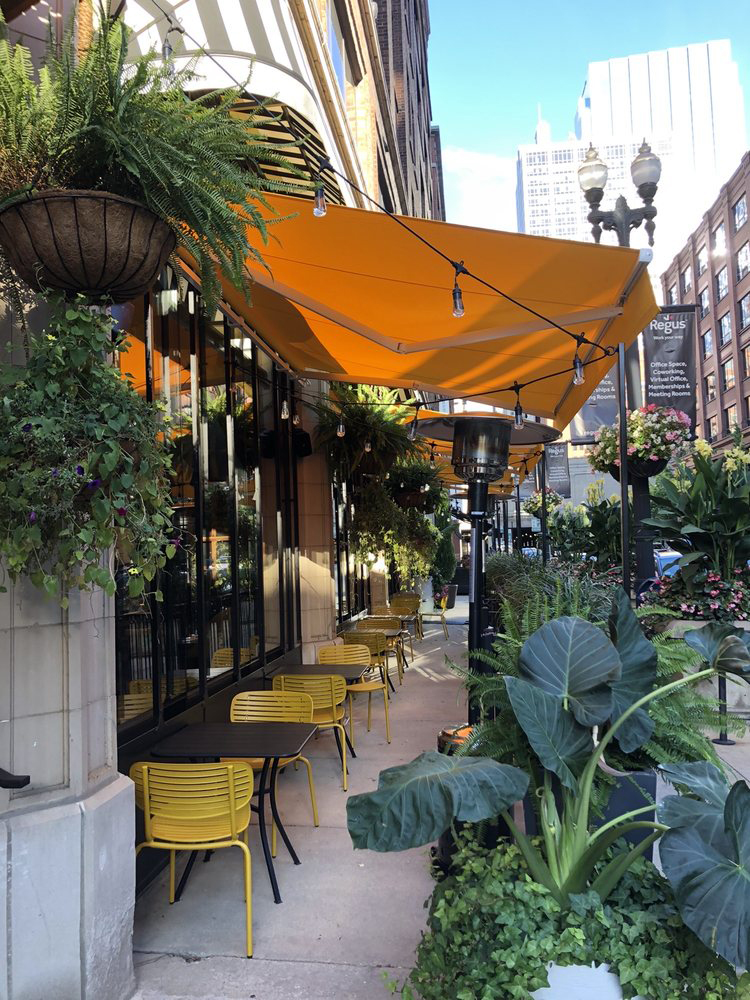
Alla Vita marks the third attempt to establish a lasting restaurant presence at this gateway into the heart of West Loop. Of course, being located just east of the Kennedy Expressway, the street sees its share of rush hour traffic. The ongoing construction of a fifteen-story office building at 609 West Randolph has only complicated things further, but it’s sure to be a boon in the long run. For its hungry tenants will be delivered right into BRG’s clutches on the opposite corner, and what overworked desk jockey doesn’t dream of smothering themselves in a chicken parm?
Even Bellemore, despite its conceptual flaws, might have succeeded had it been granted access to this teeming base of customers. Its lunch service was one of the restaurant’s few high points, and Alla Vita will no doubt follow suit when the time is right. The large space and ample seating will offer groups and walk-ins a “sure thing;” however, it will have to compete with the eclectic fare offered by Proxi and avec. Alla Vita seems sure to snare the neighborhood’s less adventurous diners, as well as the poor souls ordering take-out or delivery. But that time has yet to come. For now, the restaurant is focused only on satisfying its reputation as one of Chicago’s most difficult dinner reservations. Any latent potential must be ignored in consideration of how Alla Vita compares, in this very moment, to the city’s other hot new Italian concepts.
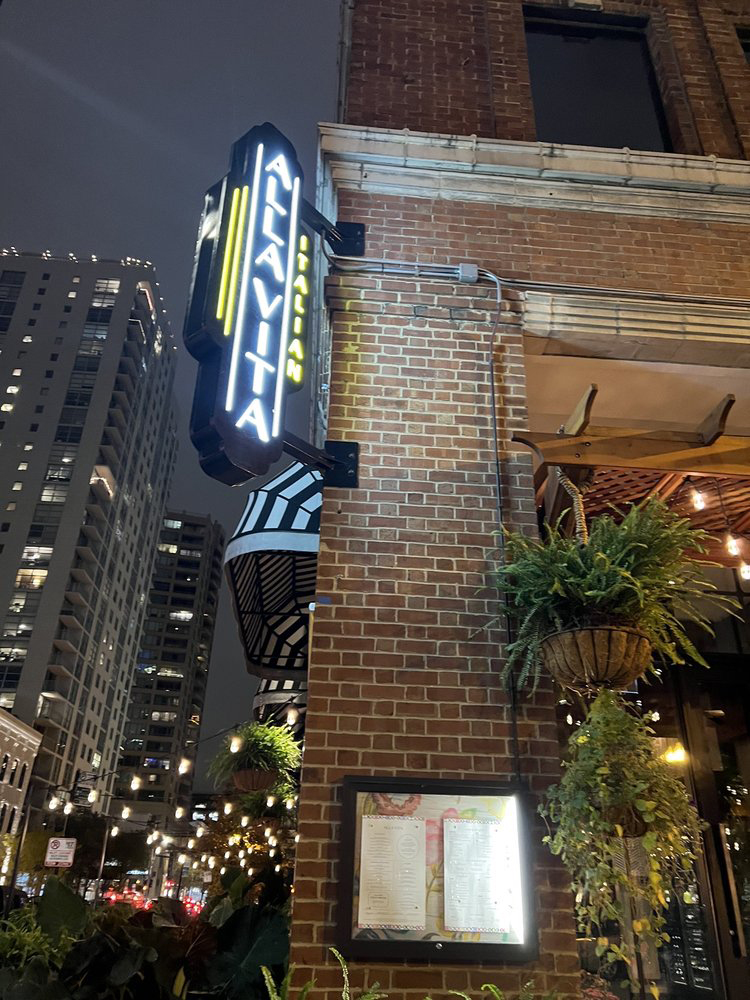
No matter from which direction you approach that northeast corner of Jefferson and Randolph, the yellow awnings, yellow chairs, piano key patterned canopies, dangling string lighting, glowing neon signage, and overflowing greenery signal you’ve arrived. It sounds like a bit much, but the visual density is captivating. The range of bright colors breathes life into the brown brick buildings that characterize the block. They distract from the unseemly parking lot and its billboards over on the other side of the street. The combined effect imparts the feeling of an urban oasis, and Kehoe deserves credit for crafting such an inviting façade. It makes Studio K’s former design seem serious and soulless. You appreciate Alla Vita’s outer design every time you pass by and, particularly, once the sun goes down.
Playing off of all the foliage, a jutting pergola structure frames the restaurant’s doorway and guides you inside. The small vestibule is loaded with a half dozen flowerpots and a hanging light fixture in the shape of an estoile. The dozens of exposed bulbs shine out at the street while casting a warm glow throughout the small chamber. You continue through the next door and enter the restaurant proper. A small wooden host stand lies to your immediate left, but your eyes are drawn forward. The dining room remains obscured, but you can perceive a sliver of Alla Vita’s bar, as well as the lounge seating that hugs the windows looking out at Jefferson.
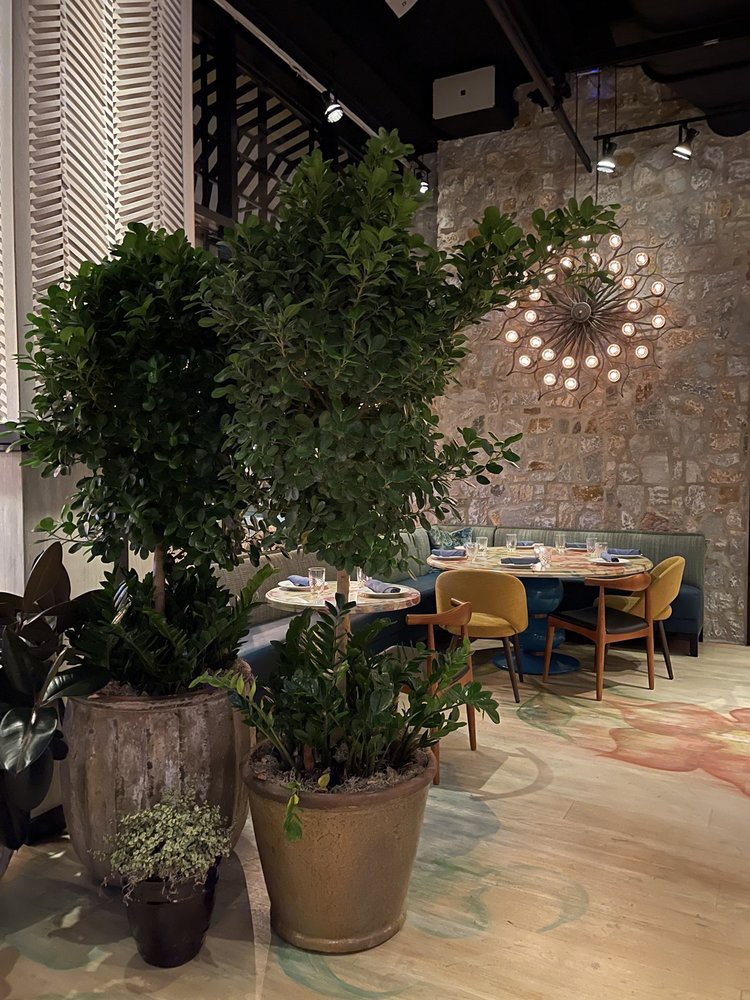
The floors are rendered in pale, weathered wood onto which have been painted a faint floral pattern in red, green, and blue. This is juxtaposed by a zagging black and white tile pattern that marks the threshold of the bar. The walls are finished with stone cladding, its textured browns and grays lending the space some feeling of an old-world cellar. The estoile light fixture appears again, with several of them hung on surfaces throughout the space. The assemblage of bulbs is as eye-catching as it was in the vestibule yet sees itself moderated by ample overhead lighting throughout the space. The fixtures’ worn metal construction also complements the shelving located behind the bar, appropriately so given that two of them bookend the counter.
A marble service station forms a barrier between the bar and the lounge seating located behind the host stand. It features a double-decker stack of glassware in a polished metal housing that matches a set of seven hanging bell-shaped glass light fixtures positioned directly above the bar’s marble counter. The lounge’s corner table displays a similar marbled pattern. The banquette is a mix of blue and gray. The chairs are upholstered in a burnished yellow tone that matches the restaurant’s outer awning. So many details, and you haven’t even caught sight of the dining room itself yet!
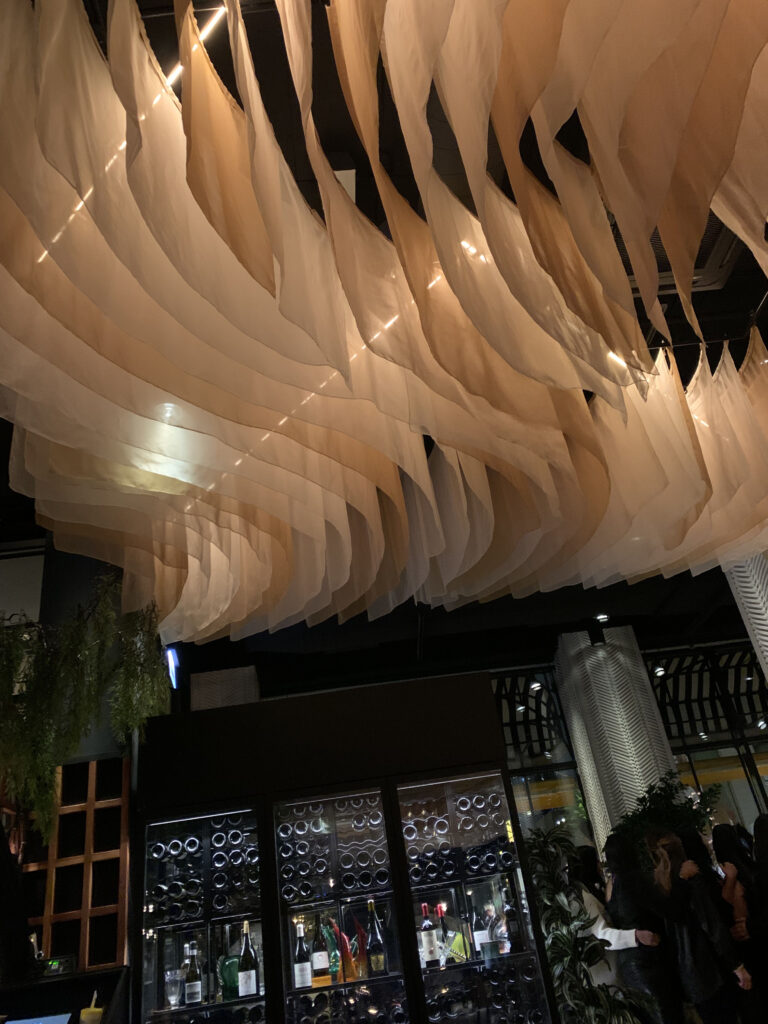
You approach the host stand and are met by a spritely trio of masked faces. They welcome you, check off your name, and whisk you onward in short order. Trailing them towards the table, you finally round the corner, passing a standing wine storage display that doubles as a wall, and perceive the heart of the restaurant. The central space, abutting a series of high-top tables opposite the bar, comprises two rows of standing four-top and six-top tables stretching back towards the kitchen with the odd two-top and banquette thrown in here and there. This section is dominated by flowing ribbons of fluttering fabric that hang down from the ceiling. This centerpiece’s many layers are illuminated by diagonal strips of lighting stretched across the ceiling and range in color from off-white to burnished beige. They work to bathe this section of the dining room in a soft glow while reducing your perception of the room’s height, lending a greater sense of intimacy.
The adjacent space, whose windows peer out onto Randolph, expands upon the pergola element located at the restaurant’s entryway. The room’s tables—once more, a mix of two-, four-, and six-tops—all sit under a towering wooden structure that raises up from the floor and curves along the ceiling. Other than a trio of semicircular beams—which frame the passageways between the two spaces—and the windows themselves, diners feel totally enclosed. However, the gridded wood of the pergola stretches up to the total height of the room, increasing your impression of its scale (in contrast to the contracting effect of the fabric ribbons).
String lighting and strands of faux greenery dangle towards the floor in a manner reminiscent of Alla Vita’s outer design. A few more flowerpots placed here and there in the room’s corners help complete the illusion. The pergola, abutting the windows facing the larger of the restaurant’s two patio sections, is meant to impart the feeling of a liminal space between indoor and out. It is meant to satisfy the fantasy of al fresco dining all year long.
Trapped in the doldrums of winter, Chicagoans need only turn their eyes upwards (towards the glowing assemblage of “plants”) and across (towards the teeming tables of patrons) to escape their looming seasonal affective disorders. They can even turn to face the adjacent room (with its illuminated fabric ribbons) and the bar beyond it. It strains your imagination to say what that centerpiece might symbolize—wind ripples?—but the overall image is one of energy and bustle (due in part to a lower perception of the “ceiling”). The two principle dining rooms, thus, play off of each other, offering varying degrees of nested faux outdoor aesthetics. At the same time, the gleaming materials that define Alla Vita’s lounge, bar, and kitchen areas assert some sense of being “inside.”
This flowing effect as you move between distinct metaspaces reminds you of touring a movie set. Fittingly, the restaurant’s ceilings have been painted black to ensure that each room’s respective structure can shine without any reference to the boundaries of the building. But any sense of immersion Kehoe can be said to have achieved is strictly “B movie” level. Dressings that look captivating from afar, that form the perfect scenery for social media posts, fall apart over the course of an evening. You begin to wonder why such a large indoor space has been intentionally cloistered, why a restaurant serving reliable Italian cuisine hitched its wagon to two bold spatial conceits.
Tracing a path from outside through the vestibule, past the host stand, and along the lounge, bathrooms, bar, and kitchen, Alla Vita improves upon Bellemore’s design. The latter restaurant’s dainty manor aesthetic, with its perplexing artwork and utterly demented bird cages (complete with taxidermied fowl), has yielded to a warmer set of tones. Any sense of luxury lost in the process has been gained in legibility. This is not an impenetrable, pretentious “contemporary American” space, but a stone and marble expression of “old world” charm. The execution is certainly not perfect—you particularly hate the repeated estoile light fixtures—but the form follows Alla Vita’s function as a comfortable, family-style establishment free from needless ornamentation or pretension.
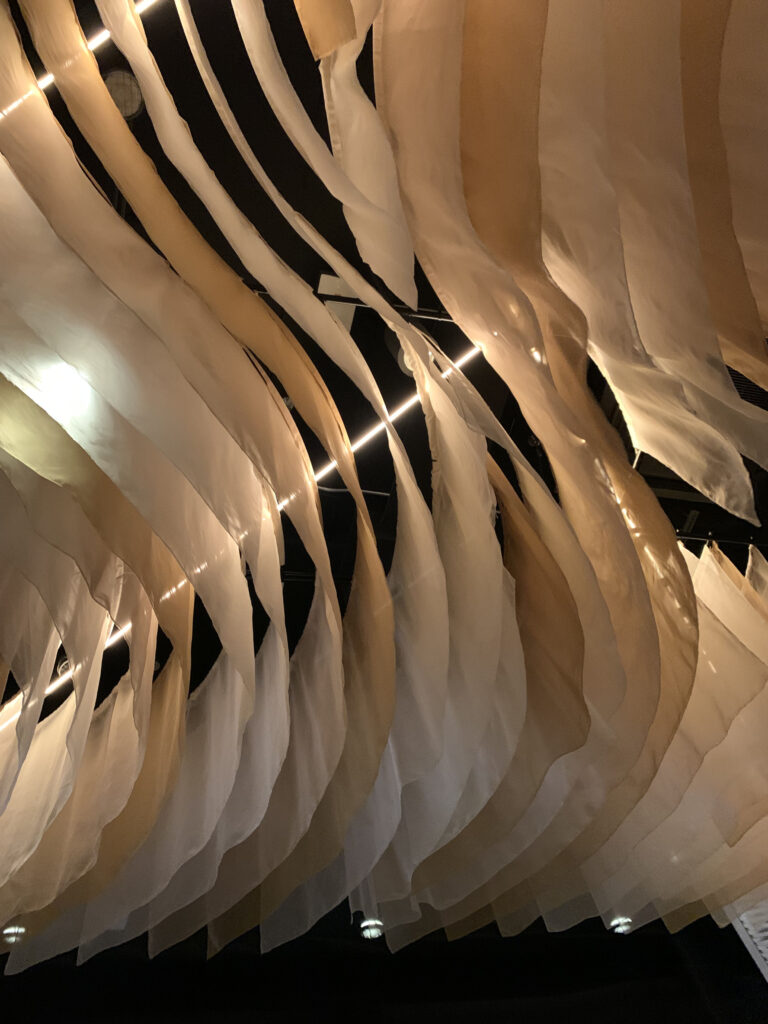
However, when it comes to the dining room(s) proper, Alla Vita’s indoor-outdoor gambit represents a clear step backwards from Bellemore’s design. Structurally, with regards to the former’s desire for increased volume, you can understand why Studio K’s assortment of horseshoe booths and banquettes had to make way for a greater number of freestanding tables. But you do not understand why Bellemore’s natural cohesiveness and centrality was totally overwritten. Why was the towering scale of its dining room cut in half and then further obscured by dangling set pieces of cheap wood and fabric?
Kehoe, as an event designer, is no doubt used to transforming rented venues, corporate conference rooms, and outdoor tents into something dazzling. Typically, the fleeting nature of their work demands they must labor to distract from a space’s natural plainness at the same time they augment it with some particular vision for its design. Thus, the kind of contrived visual density you noted in Alla Vita’s façade must form a familiar trick. The plain tent or banquet hall, by sheer force of seemingly endless detail (like plants, light fixtures, and mixed materials), becomes an emporium overflowing with wonder. BRG’s new Italian restaurant, set against the brick and dust of Randolph, seems like a Garden of Eden. The street and surrounding city provide such a contrasting sense of scale that it is almost impossible for the eye to be overwhelmed so long as colors remain complementary and symmetry is broadly respected.
Nonetheless, by applying this same formula to Alla Vita’s interior, Kehoe made a grave mistake. Within a temporary venue, a sense of visual density may succeed in overcoming structural limitations. The designer chooses to run the risk of overwhelming its audience rather than guarantee they be underwhelmed by a lack of ornamentation in some bare area that might shatter the total illusion. Guests, approaching the sort of event setting they’ve been in countless times, are easily awed by a kitchen sink of flourishes arranged with the most minimal care. The bar is set rather low for such passing occasions but not so for a restaurant.
Alla Vita, as a brick and mortar establishment, emits a certain sense of permanence. It’s not a “pop-up” like Momotaro Italia or Joomak, where any thematic visual appeal was merely a bonus. Rather, Wolen’s Italian concept was given all the bells and whistles (marketing-wise) of a splashy new BRG property, and Kehoe was brought in to realize those ideas at a visual level. Expectations were set, at the very least, that Alla Vita’s environment would match the caliber (largely defined by Studio K) of the group’s other venues. Yet Kehoe’s experience with transitory event design ultimately bleeds through. It appears they were chosen to do little more than a cut-rate rebranding while maximizing seating so that Boehm and Katz could begin to recoup Bellemore’s losses.
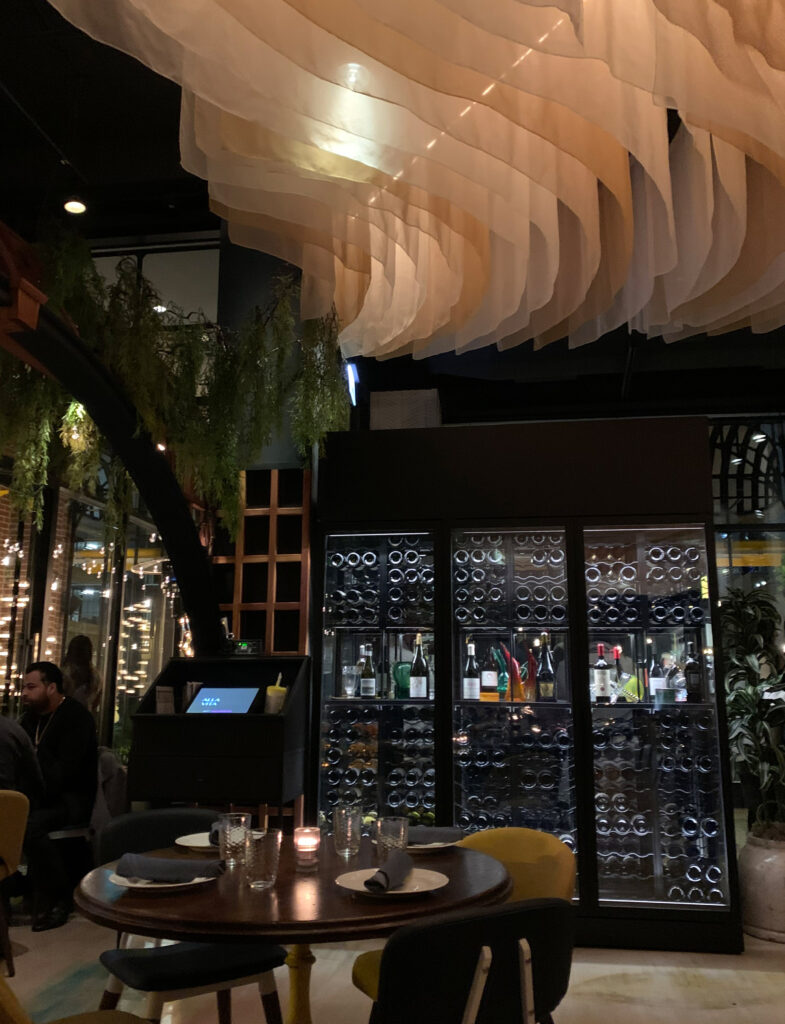
The novelty of the hanging fabric centerpiece and indoor pergola lasts just long enough to satisfy a first-time photo-op. At the end of a two-hour meal (let alone three of them), the low quality of the materials and their construction becomes patently obvious. The fake greenery, which has increasingly been strewn about every new opening in town, immediately reads as a discount version of the kind displayed at Aba, Rose Mary, and Andros Taverna (to name but a few examples). The string lighting is ordinary, dorm room tripe when ported indoors. The floral pattern painted onto the wood flooring reads as a desperate attempt to change each element for the sake of change. And that shoehorned standing wine display, a hulking black monstrosity that should never be used as a divider, seems to draw the tritest of associations between Italian food and the enjoyment of wine.
Yes, by removing Bellemore’s taxidermied birds, Kehoe was sure to succeed on some level. Yet the guest, seated under the indoor pergola, now feels themself to be the caged one. The firm’s sense for disposable design alone is exposed upon closer inspection. The dining room comprises four largely uninterrupted rows of workaday tables and chairs shrouded by a schizophrenic division of “indoor-outdoor” zones. To say the space has been transformed into a “breezy and modern garden” is absolutely laughable. It’s press junket reporting that carries water for BRG’s latent disdain of its customers.
Wolen and Boka, surely, had little explicit vision for Alla Vita. With regards to the cuisine, they were right not to pigeonhole themselves with too much talk of “Italian” this or that. The menu need only provide a sense of comfort rather than fit some preconceived image of “authenticity.” Kehoe’s design should have followed suit with pleasant, attractive digs that instill the sense of ease for which well-cooked comfort food forms a fitting partner. Yet, rather than confidently interpreting the space with a sense of unity and restraint, the firm—lacking any sense of direction—threw everything at the wall (and floors, and ceilings) and let it stick.
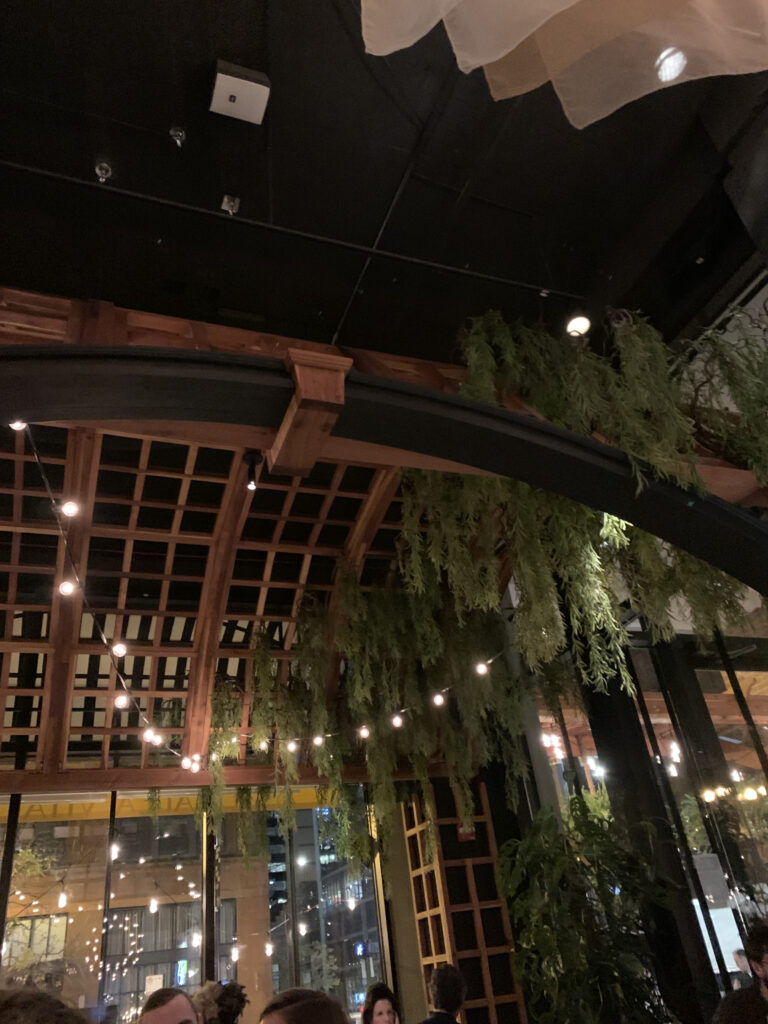
Alla Vita’s décor is nothing more than an overbearing hodgepodge of Kehoe’s party tricks. It stuns the untrained eye for just a moment but, ultimately, exposes the firm’s naïveté when grappling with a permanent space. Though a “garden” theme might enliven a plain ballroom or tent, it quickly becomes overgrown when used as a one-size-fits-all, lasting solution. Unlike a fleeting social event, a restaurant’s reason for being is rooted in the enjoyment of food. The setting may complement—but should never form a distraction from—the cuisine. For it’s not the kind of on-site catered crap that Kehoe, no doubt, is used to accompanying.
Wolen’s family-style, family-friendly Italian restaurant masquerades as a clubstaurant yet amounts to little more than a discount Rainforest Cafe. It should have been a cozy place, the kind you could see yourself returning to week after week. But BRG has harnessed the prestidigitation of pretty scenery to charm old media photographers and new media influencers. From far enough away, that thin fabric sculpture is mysterious and enchanting. From the right angle, that pergola actually makes it looks as though you are seated outside. And, inevitably, pizza, pasta, and chicken parm are sure to look enticing no matter how well or poorly they were prepared.
The unsuspecting public is snookered into believing Alla Vita is a hot spot on account of its best-dressed ambassadors. They will find the menu accessible then make their reservation for a couple months later (or, perhaps, try their luck walking in). When they finally arrive, that wonderful illusion quickly fades. The décor looked its best in the photographs, and now they can only notice the gaps and jagged edges that got left out. But will that stop them from taking their own shots, bragging to their own friends, and perpetuating the same farce for just a bit longer? Will the food that, curiously, took a backseat to the backdrop fulfill the weight of the expectations drawn from that compromised aesthetic fantasy?
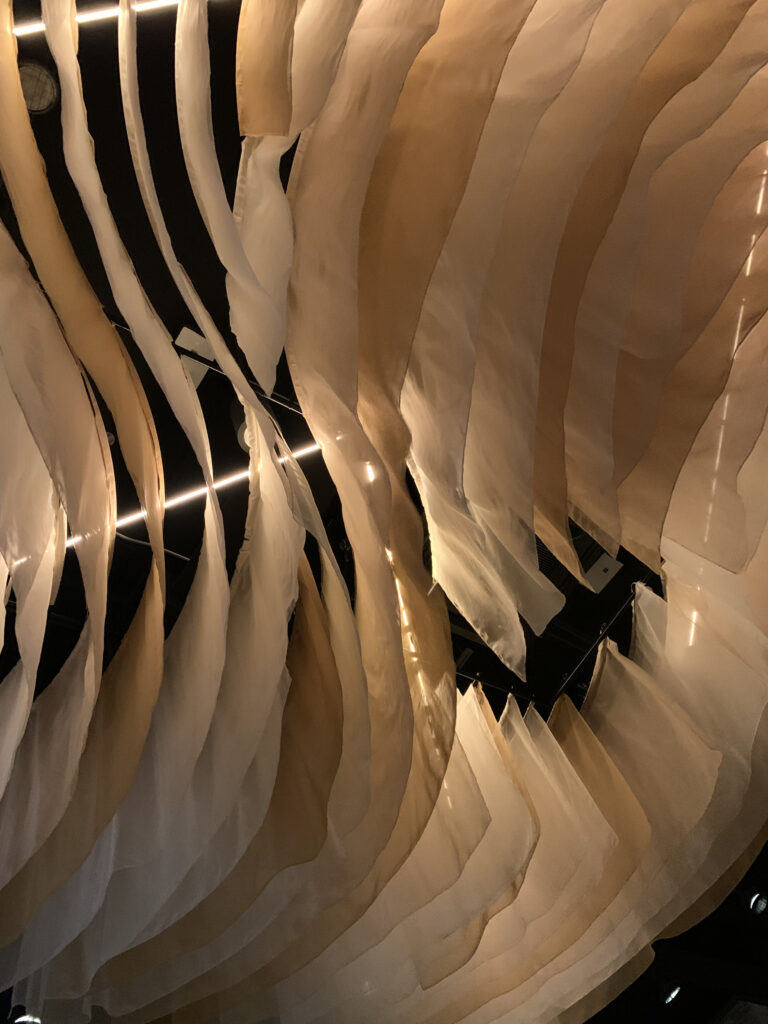
Alla Vita’s interior design, to its credit, is novel. Other than the ugly wine display, it avoids the many tired tropes of a retrograde red sauce joint. It puts forth some vision of how Italian food might be enjoyed if freed from nostalgia, yet Kehoe’s work lacks the refinement of Adalina and the honesty of Elina’s. The firm wraps simple, timeless fare in surroundings that are tacky and contrived to please the lowest common denominator. They juxtapose recipes defined by their perfect, consistent execution with amateur construction. They denigrate the nostalgia customers feel for Italian cuisine by attaching it to a passing fad, a cheap set for a wannabe jet set’s silly photos that doesn’t look as though it will last for more than a year. The “stylish” surroundings feel particularly inane when the “family-friendly” restaurant echoes with the sound of screaming children.
Bellemore contained some confusing elements, but Studio K’s dining room was both gorgeous and functional. Kehoe, however, has brought the space to its absolute nadir. You cry for what BRG has done to Embeya (which, it must be noted, offered more seating, more comfortably than Alla Vita does). Save for the slick branding, you’d struggle identifying the restaurant as a Boka property. It looks like someone’s first project, and it strikes you that Boehm and Katz either chose to do Kehoe a big favor or benefitted from incredible savings. Whatever the reasoning, the end result reads as lazy and cynical. It signals that Alla Vita lacks confidence in its identity or, like Bellemore, lacks one altogether. (Yet that cohesion means little if the kitchen delivers on the comfortable fare that’s been promised).
But first, a drink. That always helps Kehoe’s work shine a bit more brightly (just as the open bars at the firm’s events do).
After being deposited at your table by the hostess, you are pleased to find that the full wine list awaits you. One of the bussers, likewise, is quick to get your party’s water glasses filled. It’s a smooth start to proceedings, and you know there are just a couple minutes before your server’s formal introduction to make a decision.
Though Bellemore occasionally offered some exceptional bottles—you still remember a 2006 Egly-Ouriet Grand Cru Millésime enjoyed two years ago and a youthful Arnaud Ente Volnay specially offered by the sommelier a year prior—the restaurant’s list suffered on account of the overall concept. It was more “contemporary” American than Boka itself but less refined. It offered one or two steaks without stepping on the toes of GT Prime or Swift & Sons. So Bellemore, though its list was rather imaginatively designed, struggled to get its hands on BRG’s more allocated bottles. In fact, once Jamel Freeman left as wine director, the restaurant seemed like little more than a dumping ground for the other properties’ leftovers.
You hoped that Alla Vita, thematically, might avoid this problem since BRG does not really have an Italian restaurant in its stable. Cira, perhaps, touches upon Mediterranean flavors, but it’s not quite a wine destination. Their list is headlined by a 2017 Kosta Browne ($225) and 2010 Jordan ($190) with hardly any Italian varietals in sight (outside of glass and Coravin pours). Surely, Wolen’s newest venture could benefit from securing great bottles that were not already spoken for by the group’s steakhouse and fine dining concepts.
But even Boka’s wine list, it must be said, is in absolutely dire shape. Its once-great selection has been picked clean and is now dominated by overpriced, current release offerings. Yes, there are a couple bright spots: remnants of Dagueneau, Domaine du Collier, Guiberteau, and Matthiasson from days past. Yet, as the crown jewel of BRG’s empire, Boka could never be mistaken for a wine destination. The Burgundy selection is pitiful, and that the restaurant allows corkage is a saving grace.
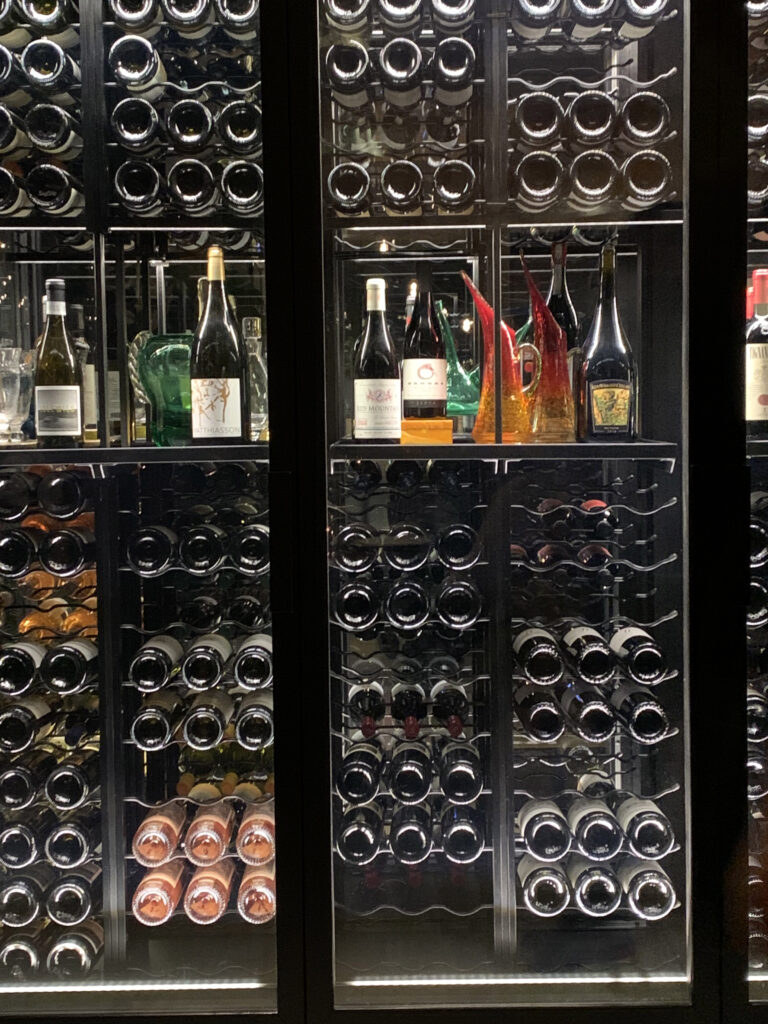
Alla Vita’s wine program is under the care of Kimberlee Beeler, beverage director of Boka who, like Wolen, grafted her talents over to the new concept. Beeler’s prior experience at Somerset, back when BRG was still involved with Viceroy, makes her well-suited to tackling a more casual program while retaining some fine dining flair. Likewise, it means she knows Wolen’s cooking—which included several pastas at the former hotel space—quite well. In this manner, coordinating Alla Vita’s selection alongside Boka’s could help prevent it being thrown to the wolves like Bellemore’s was.
Ultimately, you must say that you were pleasantly surprised by Alla Vita’s wine list. It cannot compare to the depth offered, at opening, by Adalina or Rose Mary. It’s not a tight, value-driven list of eclectic and allocated Italian wines as seen at Monteverde. But it certainly beats, just as one egregious example, the selection offered at Esmé during its first few months of service (in which The Prisoner, shudder, ranked as one of the establishment’s priciest offerings). You think the list even compares favorably to a place like Gioia, which has positioned itself as slightly more classic and premium of a concept among all the new Italian openings.
For the casual imbiber, Beeler’s list delivers shining values like by-the-glass Chardonnay from Calera and Barbera from G.D. Vajra. Those looking at the bottle list will find an approachable selection spanning familiar domestic regions and the breadth of the Italian peninsula. Options generally span the $60-$120 with particular value to be found in obscure varietals like Friulano, Malvasia, and Vernaccia. However, wines from Lingua Franca and Ar. Pe. Pe. provide some of the best in class values for more familiar grapes like Chardonnay and Nebbiolo.
Surprisingly, the back of Alla Vita’s wine list boasts both a large format and a reserve selection. While recent vintages of Tignanello and Hillside Select call to mind a stereotypical Italian steakhouse, you have enjoyed well-priced magnums of Matthiasson’s Linda Vista Chardonnay and Ken Wright’s Savoya Vineyard Pinot Noir. As far as Barolo goes, a 2013 Damiliano Cannubi proved accessible and pleasurable at a fair price. Generally, the wine list is free of needless ostentation or totally unyielding bottles. Alla Vita might not intend to be a top destination for snobs, but it does reward those who go looking for a fitting accompaniment to its food.
Also, though you neglected Adalina’s cocktail selection (largely due to excitement regarding the wine list), you must praise bar manager Anna Thorn’s work at Alla Vita. In particular, you must single out one of the seasonal spritzes titled “Sailor’s Delight.” It comprises Cappelletti, a bittersweet aperitivo made from a wine base, and Vecchio del Capo, a Calabrian digestivo made from sugar beets macerated with 29 other ingredients sourced from estate farms, that are mixed with soda water, prosecco, and orange.The spritz’s principle components might not carry the name recognition of the vodka, gin, tequila, rum, bourbon, and rye cocktails that make up the rest of the selection. However, you found the “Sailor’s Delight” to strike a perfect balance between the endlessly complex mélange of fruity, floral, bitter, and aniseed notes and the sheer refreshment of the soda and sparkling wine. Truly, it’s the kind of drink that almost makes Kehoe’s indoor-outdoor garden artifice go over. However, even after downing four of them, you can report that the cheap, muddled materials looked no better.
With the drinks decided upon, you are ready to meet your server. They touch the table only a couple minutes later without much pomp or circumstance. In fact, if you’re being honest, you had trouble telling the servers, food runners, and bussers apart on your first visit. That’s not a bad thing for a restaurant of Alla Vita’s scale. Perhaps it even, to some degree, reflects the extent to which the entire team labors in unison to please its guests. To you, it only meant being unsure of whether the staff member you were speaking to was ready to receive an order for a few bottles of wine. Thanks to the convenience provided by the list’s bin numbers, they accurately conveyed your selection to a manger who extricated the chosen magnum of Chardonnay and two Barolos from the hulking display case. After receiving the bottles, your server conducted the wine service attentively for the rest of the evening.
You cannot find much fault with service as it relates to the rest of the meal either. No elaborate spiel is really necessary to frame family-style Italian dining, but the staff shares the suggested number of dishes per person and some of their favorite items. Importantly, they offer no resistance when faced with orders that far surpass the recommended amount of plates. Otherwise, glasses are refilled and plates are cleared in short order. A sense of energy abounds as food flies out of the kitchen at an admirable pace. Everyone at Alla Vita is friendly, but the concept is not structured to deliver any exceptional human element. There is none of the friendly banter that struck you at Adalina, no trace of that charmingly earnest quality you noted at Elina’s. Fewer traces of personality shine through than sensed at Formento’s, Monteverde, or Rose Mary. And even Lettuce Entertain You, at its most casual concepts, manages to make a more lasting impression.
Alla Vita’s service is highly competent and well-suited to a restaurant geared towards satisfying a fast casual crowd. Its décor, surely, will overshadow any subdued sense of warmth or emotion for certain diners. But those drawn to Kehoe’s pathetic, postcard representation of “Italy” are likely the sort who prefer servers remain neither seen nor heard anyway. Hospitality is woven just as deeply into Italian (and Italian-American) culture as any monument or scenic vista. To strip the cuisine of its human element, to deny the personal touch that defines “grandma cooking,” is to dilute its power. BRG’s gambit, while not quite misappropriation, demonstrates a misunderstanding of the genre’s longstanding appeal. It heaps pressure on Wolen’s recipes to deliver a sense of emotion that the environment and the restaurant’s staff fall short at establishing.
Because, likewise, the chef is nowhere to be seen in the dining room. While Ahn, Rusnak, and Safin provide their guests with an enchanting personal touch (even something so simple as a smile or a wave), Wolen—who, of course, has a Michelin-starred restaurant to attend to—has deputized control of Alla Vita’s kitchen. That’s understandable, and you respect that Boka should remain his priority. However, on the occasions you have seen the chef-partner at the restaurant, he has sheepishly hidden at the periphery rather than drop the occasional dish or demonstrate that all-important pride in his work. It’s a personal choice—and you resent no chef’s shyness nor do you, personally, solicit their special attention—yet it stands as a further dilution of the spirit that characterizes the Italian genre at its best. (But hey, it sure beats seeing him strut around Somerset in his running shorts. That stands, perhaps, as your most nauseating encounter with a chef ever).
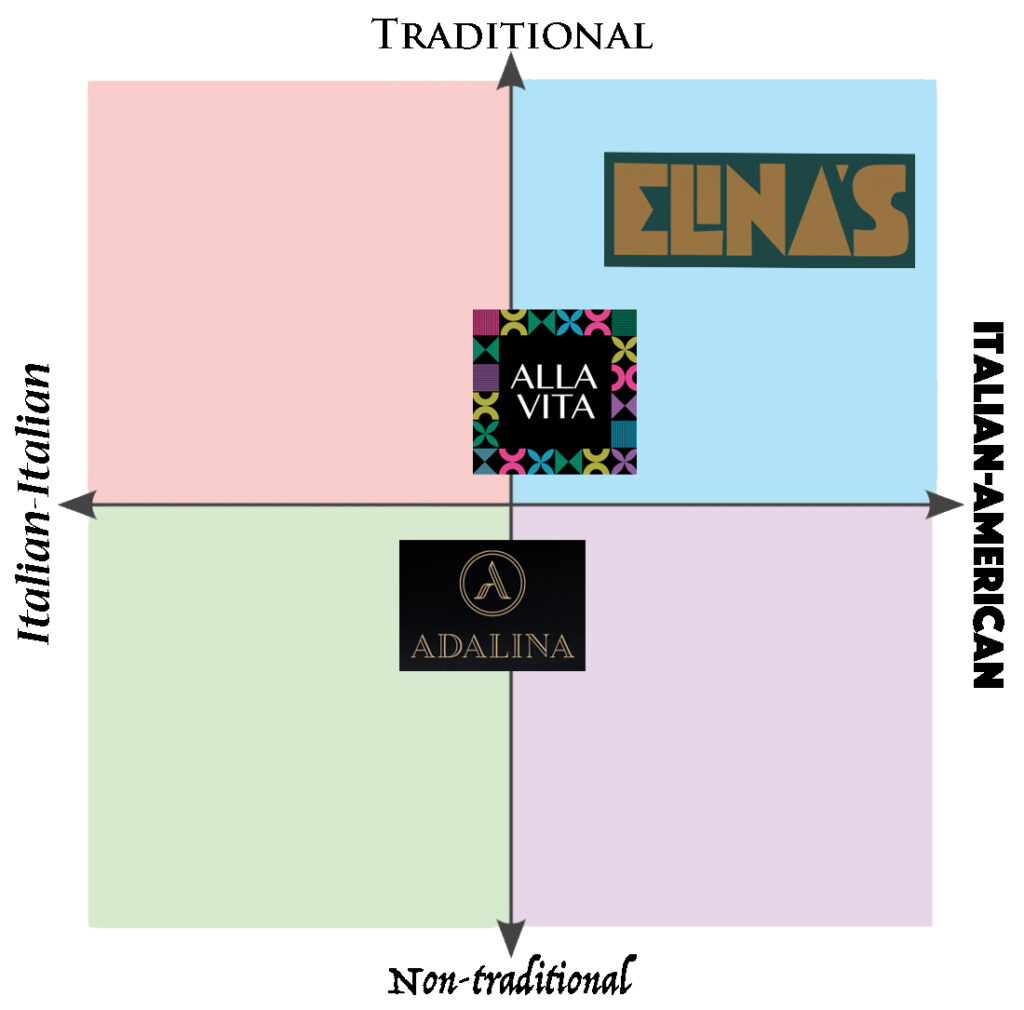
Turning towards the menu, you think your original orientation of Alla Vita remains sound. Broadly, Wolen’s recipes show respect for traditional techniques and ingredient combinations. His most dramatic creative flourishes, like the wood-fired table bread or wild mushroom lasagna, really do not subvert the balance of flavors diners have come to expect from Italian cookery. The restaurant does not make any conscious claim to tradition, nor does it noticeably look to buck it. Likewise, ascending the scale towards being more traditional would mean, in your opinion, adopting a more distinctly “Italian-Italian” or Italian-American approach and pursuing it from top the bottom. Alla Vita’s menu offers a collection of both cuisines’ staples with a slight tendency towards the latter. However, rather than bowing before either canon explicitly, Wolen applies his own touch—and some local ingredients—across the board. This provides a leveling effect that, all the more, suits the restaurant’s amorphous branding as “comfortable” Italian that transcends any more particular label.
The “Antipasti” section begins with the “Wood Fired Table Bread” you just mentioned. At $12, it’s something of a corollary to the cheese-stuffed garlic bread at Adalina ($10) or, even more closely, to the “Black Truffle Puff Bread” ($16) served at Apolonia since opening. Also, it’s quite a clever way for Alla Vita to make extra use of its pizza oven by putting it in service of an appetizer that most diners are destined to order. The dough, which seems similar to that used for the restaurant’s neo-Neapolitan pies, rises beautifully upon being baked. Its craggy, very lightly charred crust is topped with Taleggio, a tangy washed rind cheese, then finished with orange blossom honey, black pepper, and a dusting of parmigiano.
Tearing the bread causes an impressive deflation and yields thin chunks akin to pizza crust. This forms a better textural balance with the relatively light coating of melted cheese. However, the Taleggio offers plenty depth of flavor. Its latent fruity notes meld well with the orange blossom honey while an undercurrent of nuttiness forms a fitting partner for the parm. The sharpness of the black pepper and sweetness, also from the honey, moderate those pleasing savory notes. Really, you cannot deny that this dish is sure to win guests over, but you have noted some inconsistency to its preparation that must be considered. In one instance, the crisp, cohesive puff of pizza crust you had come to enjoy came out looking more like a greasy pita. The bread’s delicate dimples were missing—a sign it had not been cooked long or hot enough—and it felt like a goopy, oily mess. It was a grave oversight considering the pride of place this dish is given on the menu. What proportion of orders are being botched in such a fashion?
Wolen’s “Kanpachi Crudo” preparation, by comparison, has been far more consistent. Consistently poor that is. Kanpachi, of course, refers to a species of almaco jack similar to popular “yellowtail” amberjack species like hamachi and hiramasa. Like other members of the Seriola genus, the fish possesses a high fat content that yields succulent white flesh well-suited for sushi. $21 gets you five glistening slices of raw kanpachi that, in the classic crudo style, have been dressed in a high quality extra virgin olive oil. The dish is then garnished with shallots, halved kumquats, Calabrian chili, and mint leaves.
Conceptually, the crudo’s combination of flavors is sound. The fatty fish, made all the more luscious by its coating of olive oil, forms a perfect canvas for the sharp, sweet, spicy, and cooling notes to butt heads (but ultimately balance each other). It’s a beautiful, elegant presentation too. But you have found the kanpachi to be sliced too thickly on each occasion you have tried it. It has displayed a chewy, gummy consistency that defeats the dish’s sole purpose: offering a pristine mouthful of melting fish that dances across the tongue. Alla Vita’s “Kanpachi Crudo” is a far cry from the shima aji and scallop crudos that Wolen has served at Boka. Its presence on the restaurant’s menu, executed in this manner, reads as a halfhearted attempt to elevate the kind of cuisine being offered. It’s hard to stomach wasting a sum you could spend on an entire pizza or bowl of pasta on a dish that is so technically flawed.
The “Fritto Misto” steers you back towards familiar terrain. At $22, it’s priced a bit higher than the version offered at Elina’s ($18) but comprises a slightly larger portion of shrimp and squid. Alla Vita’s batter yields a crust that is a bit finer and crisper than its competitor (whose lighter, airier breading better showcases the interior texture of the seafood). You particularly appreciate the style of the former when biting into the tentacle pieces of calamari, which yields a highly pleasing crunch.
As far as dipping the fried delights goes, Alla Vita initially paired them with a roasted tomato sauce but later opted for a lemon-Calabrian chili aioli. Elina’s, of course, offers both options to guests, but you don’t think either restaurant noticeably excels in this department. (Perhaps you still lust for pungent cocktail sauce or at least a few fried banana peppers thrown into the mix). Overall, Alla Vita’s “Fritto Misto” is a fine example of the form. However, as with the table bread, you have noted some inconsistency in the degree of browning the kitchen achieves. It’s the kind of lapse that paints the restaurant’s ability to offer certain parties a more fast casual experience as a temptation to cut corners.
Wolen’s “Arancini” ($14) takes a more traditional route than Ahn’s “Cacio e Pepe Arancini” ($15) from Adalina. While the latter version drew upon Forbidden Rice and Manchego to gussy things up, Alla Vita’s opts for classic risotto rice stuffed with Scamorza (a more piquant, creamier mozzarella with a light caramel note). The balls, like many modern examples, are quite smaller than the “oranges” from which they take their name. They are coated in breadcrumbs and fried to a deep golden brown before being dusted with fennel pollen and paired with an aioli made from ‘nduja (a spreadable pork sausage flavored with roasted Calabrian chilis). One order originally comprised three pieces, but this was later increased to four (a sensible decision).
Alla Vita’s “Arancini” is a good example of the recipe that will satisfy fans of the form. The balls’ outer texture possesses a pleasing crispness that ensures you can take a clean bite. This exposes their molten Scamorza without the rice falling apart. That ratio—between cheese and rice—is conceived so that the grains receive an ample coating of the melted goodness. The fennel pollen and aioli provide tinges of sweetness and spice respectively. But you have not found that these flavors make a big impression. Whereas Adalina’s rendition offers a full throttle reinterpretation charged with intensity, Alla Vita’s—despite touting a couple interesting ingredients—does little to surpass expectations. However, it doesn’t necessarily need to so long as the arancini remain consistently fried.
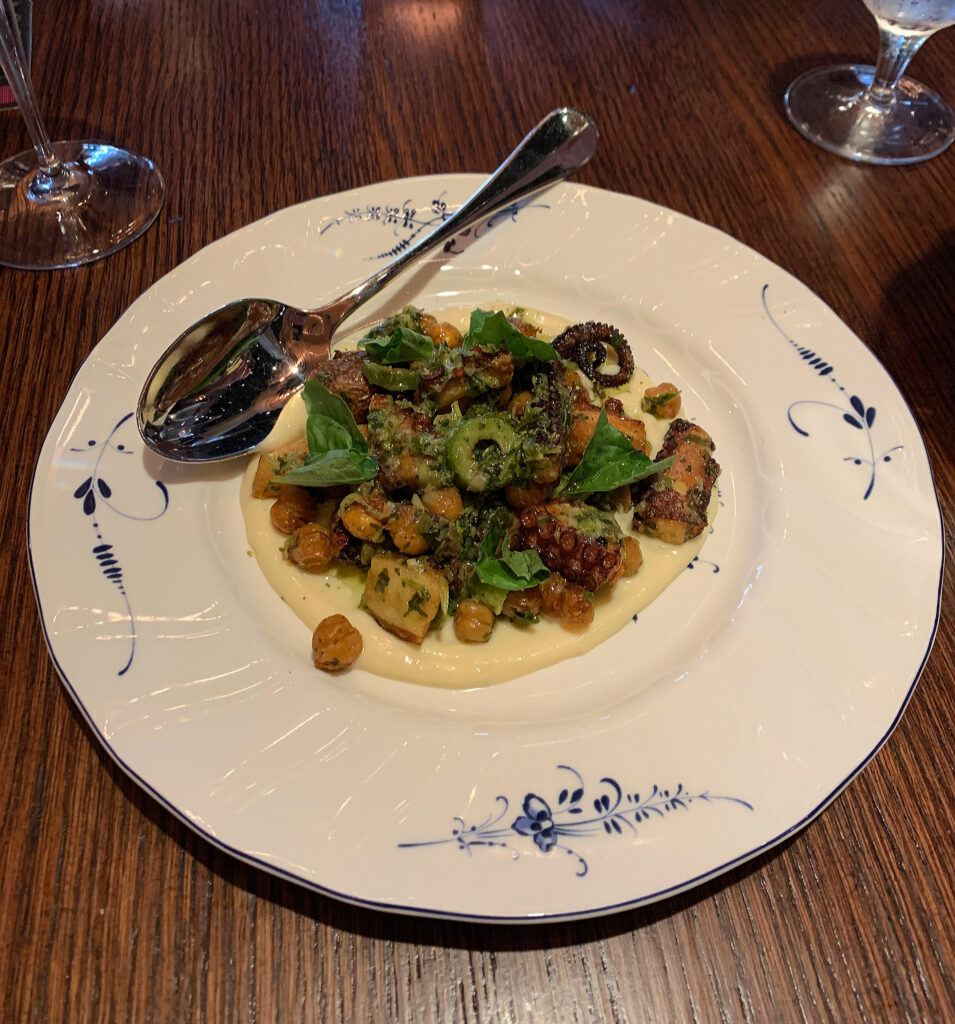
A parallel can, once more, be drawn between Wolen’s “Roasted Octopus” ($22) and Ahn’s “Charred Octopus” ($23). When it comes to the titular cephalopod, the two portion sizes are more or less the same. However, Adalina’s preparation successfully executed a bold array of supporting flavors like horseradish goat cheese, fennel, cherry peppers, and pistachio to go along with a smattering of potatoes. Alla Vita’s version pairs the octopus with more classic flavors drawn from Castelvetrano olives, crispy chickpeas, salsa verde, a garlic aioli, and some crispy potatoes as well.
Texturally, Wolen’s rendition comes off well. The octopus displays a bit of char on its cups alongside the subtle chew you desire while, ultimately, being tender. The contrasting crunch of the potatoes and chickpeas, as well as the softer mouthfeel of the olive chunks, amplify the tendrils’ texture. The garlic aioli, which coats the bottom of the plate, also provides an enveloping mouthfeel that helps accentuate the other components. With regards to flavor, the dish contains all the buttery, salty, and citric notes you come to expect paired with the cephalopod. There’s also a pleasant undercurrent of umami (drawn from the salsa verde and aioli) that serves to enrich the meat. Nonetheless, while good, the “Roasted Octopus” does nothing new. It lacks the spark of creativity and ultimate complexity of Adalina’s dish. Likewise, it’s strange to see Wolen resort to using flavored aiolis across so much of the menu. Surely the chef has some other tricks up his sleeve.
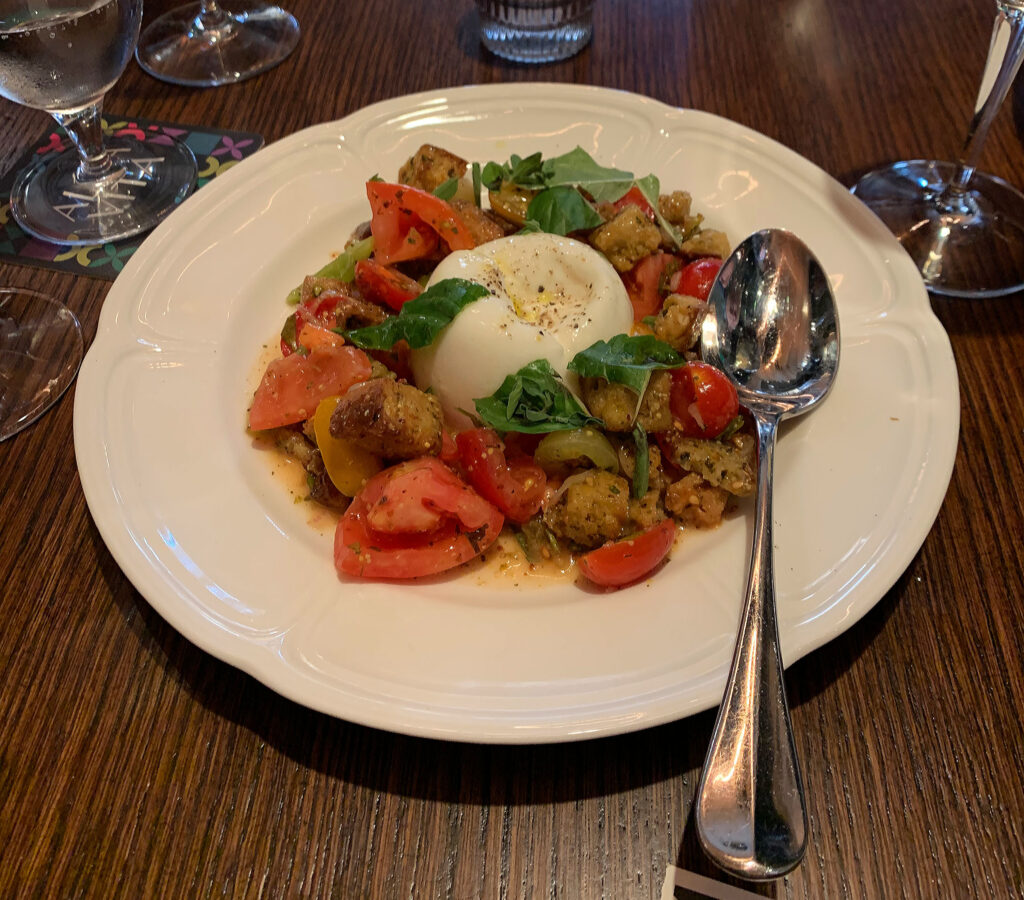
Alla Vita originally served a “Burrata Panzanella” ($19) loaded with heirloom tomatoes and sourdough croutons in a manner reminiscent of (but inferior to) Aba’s “House-made Stracciatella” ($16.95). The preparation, perhaps, clashed with a couple other salads offered, in a special section, as two of the menu’s hallmarks. Eventually, the dish wash changed to “Burrata” ($20), a reconfiguration that is less like a salad and more like a composed small plate. It comprises a central layer of the namesake cheese (shaped more like a spread than the original ball form) surrounded by cross-sections of delicata squash and slices of Honeycrisp apple. The plate is dressed with a mustard vinaigrette then garnished with ground hazelnuts and black pepper.
By your measure, the “Burrata” might be the best of all the restaurant’s “Antipasti.” While Wolen has struggled to put much of a stamp on his more classically-conceived items, the creamy cheese has provided the chef with a beautiful canvas on which to arrange fresh produce. The juicy crunch of the apple and smooth consistency of the squash meld nicely with the thick coating of dairy. The two also provide a measured sweetness that helps accentuate the burrata’s buttery quality. The hazelnuts, of course, provide a wonderful crunch. However, they also impart a toasted quality that especially enhances the flavor of the squash. The mustard vinaigrette does much of the heavy lifting, ensuring each component is amply seasoned. It succeeds in uniting the ingredients with a tart, slightly pungent quality that helps each of the other notes sing.
This dish is a triumph of intense flavor and intricate texture that should serve as a model for the reimagined Italian fare Alla Vita might serve. However, as has been the case with other items, you have received at least one order of “Burrata” that arrived looking like a muddled mess. This is quite a shame considering how pretty the plate usually looks.
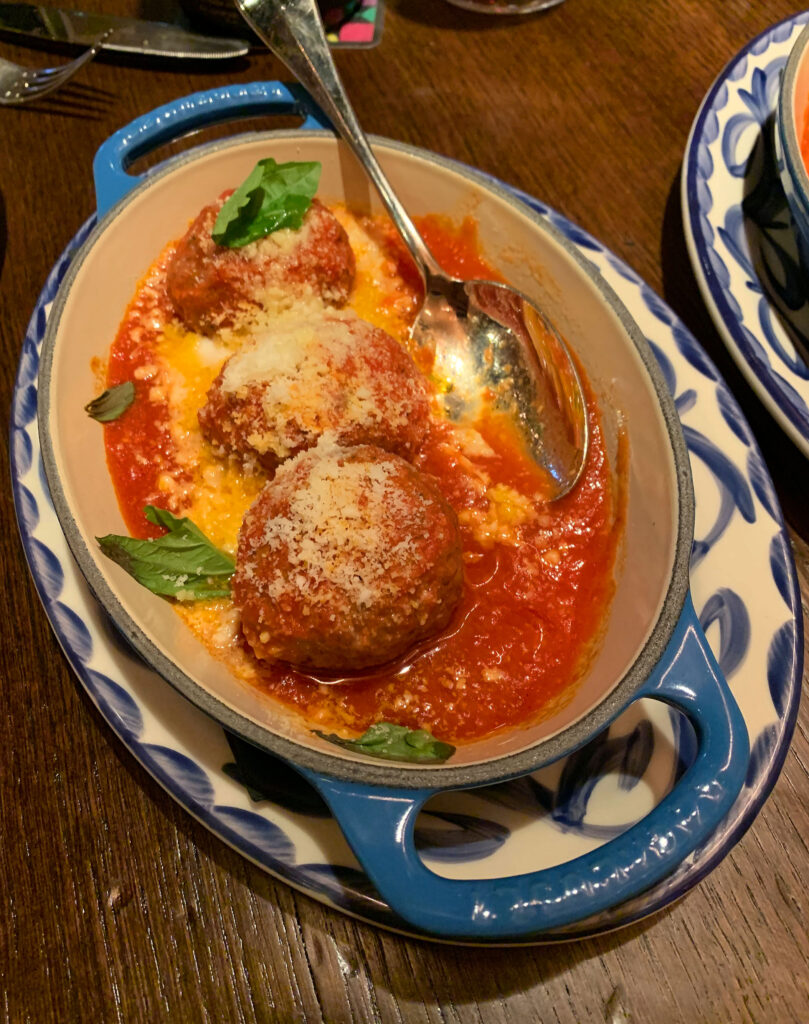
“Wood Fired Meatballs” ($15) mark the last of Alla Vita’s “Antipasti” offerings. The three-piece serving is the same portion size as those seen at Adalina ($16) and Elina’s ($18). All three examples are served in a tomato sauce with basil and grated parmigiano. However, while Adalina’s balls possessed a hearty, meaty chew, Elina’s were on the smoother, softer side. Alla Vita’s are more like the former, displaying a firmer texture that yields a more substantial feeling of satiation. You are unsure as to the blend of meats each restaurant uses, but you would guess that Elina’s makes use of beef, pork, and veal while Adalina and Alla Vita might only draw on two of those three.
Though the firmer style of meatball can provide a greater perception of value, you think such a preparation should be pan-fried. This imparts an additional layer of crust, as well as caramelized and charred flavors, that play well off of the increased sense of chew. On the other hand, meatballs that are cooked or finished in sauce should form a vehicle for that very sauce. A finer, smoother texture absorbs more of the tomato flavor on the palate while providing it with an additional savory undercurrent drawn from the particular blend. This relative lack of chew distinguishes the meatball from other items like sausage or pork neck bones that typically join it in the simmering ragù.
Alla Vita’s meatballs, like Adalina’s, struggle a bit for their lack of a contrasting texture to buffer their chew. Missing that, they then demand a greater intensity of flavor. For, with less absorptive power, their firmer consistency demands a particularly vibrant tomato sauce or the use of dry-aged beef in the blend. Adalina moderates this problem by adding smoked Scamorza and a drizzle of olive oil to enrich the flavors of their dish. However, Alla Vita relies solely upon its “roasted tomato sauce” and a generous helping of grated “parmigiana [sic].” Wolen’s sauce, to your taste, lacks depth of flavor, and all that cheese can only do so much. The restaurant’s “Wood Fired Meatballs,” thus, are a competent example of the form and little more. If the chef insists on using the wood fire, he should take a few pages from Maple & Ash’s book (dry-aged beef, caramelized tomato sauce, cheese curds) to ensure that the gimmicky preparation does not compromise the dish’s quality.
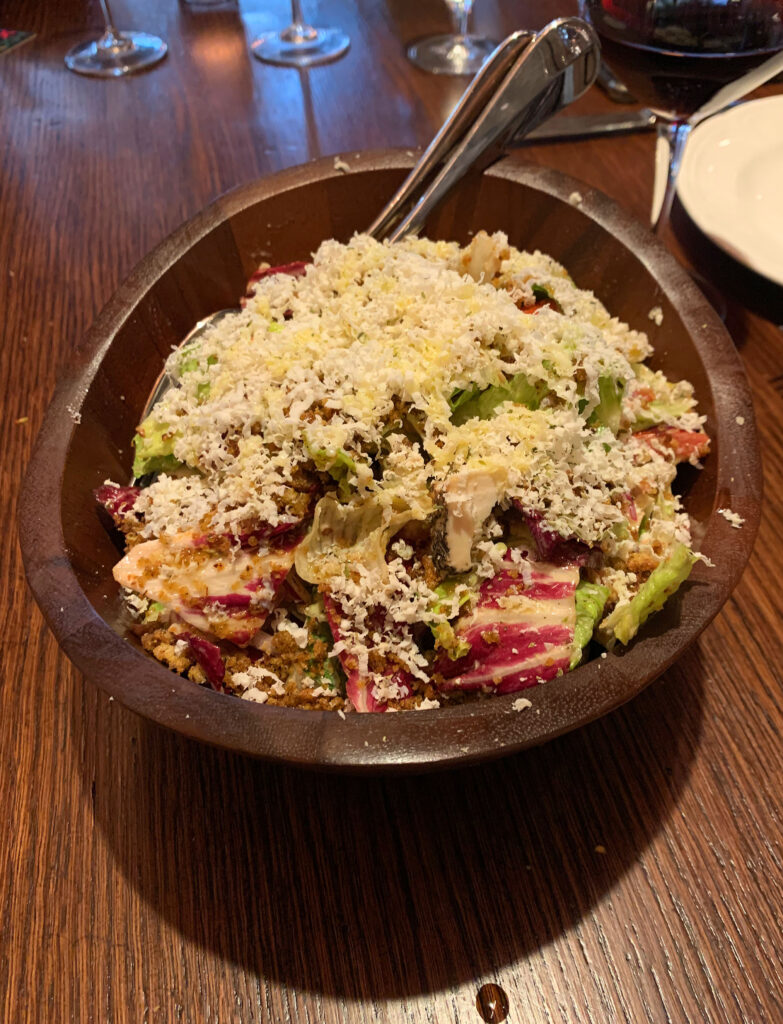
The next section of Alla Vita’s menu comprises those fabled “giant bowls of chopped salads that can be shared for groups as large as six,” which had been touted from the very moment the concept was announced. Truthfully, you are glad that this element came to fruition, commanding—as previously mentioned—a special, encircled place on the menu opposite the “Antipasti.” The salads, along with Wolen’s pizza and pastas, form the lifeblood of the restaurant’s “comfortable Italian” identity. And you had good reason to believe that the chef would so such a seemingly unglamorous idea justice. His kale and Brussels sprouts salad (with grapes and cashews) served at Somerset ranks as one of the very best examples of the form you have ever tasted.
The recipes showcased here are a bit more familiar, yet they demonstrate the same sense of vitality and textural mastery. Both offerings cost $15 each or $10 per person for two or more servings. While the standard portion is presented on a plate, larger orders are placed in attractive wooden bowls that facilitate sharing.
First, there’s the “Alla Vita Chopped,” an Italian-American stalwart comparable to the “Chopped Salad” offered at both Adalina ($16) and Elina’s ($14). Wolen’s rendition combines gem lettuce, radicchio, finocchiona (the fennel-tinged king of Tuscan salami), pepperoncini, red onion, and tomato dressed in a red wine vinaigrette. Additionally, though not listed, the dish is topped with tiny ribbons of grated parmigiano and coarse bits of breadcrumbs. These latter two elements beautifully coat the larger ingredients at hand, ensuring that each crunching leaf or bursting vegetable is enlivened by an additional layer that is pleasingly soft or crisp. With regard to flavor, the salad balances bitterness, pickled peppery heat, aniseed sweetness, savory pork, and a cleansing pungency on the blank canvas provided by the gem lettuce. The red wine vinaigrette is not only attractively tangy, but envelops each of the more aggressive components with its full, fruity character. The “Alla Vita Chopped” is a joy to eat, and you think it just surpasses the more humble version at Elina’s.
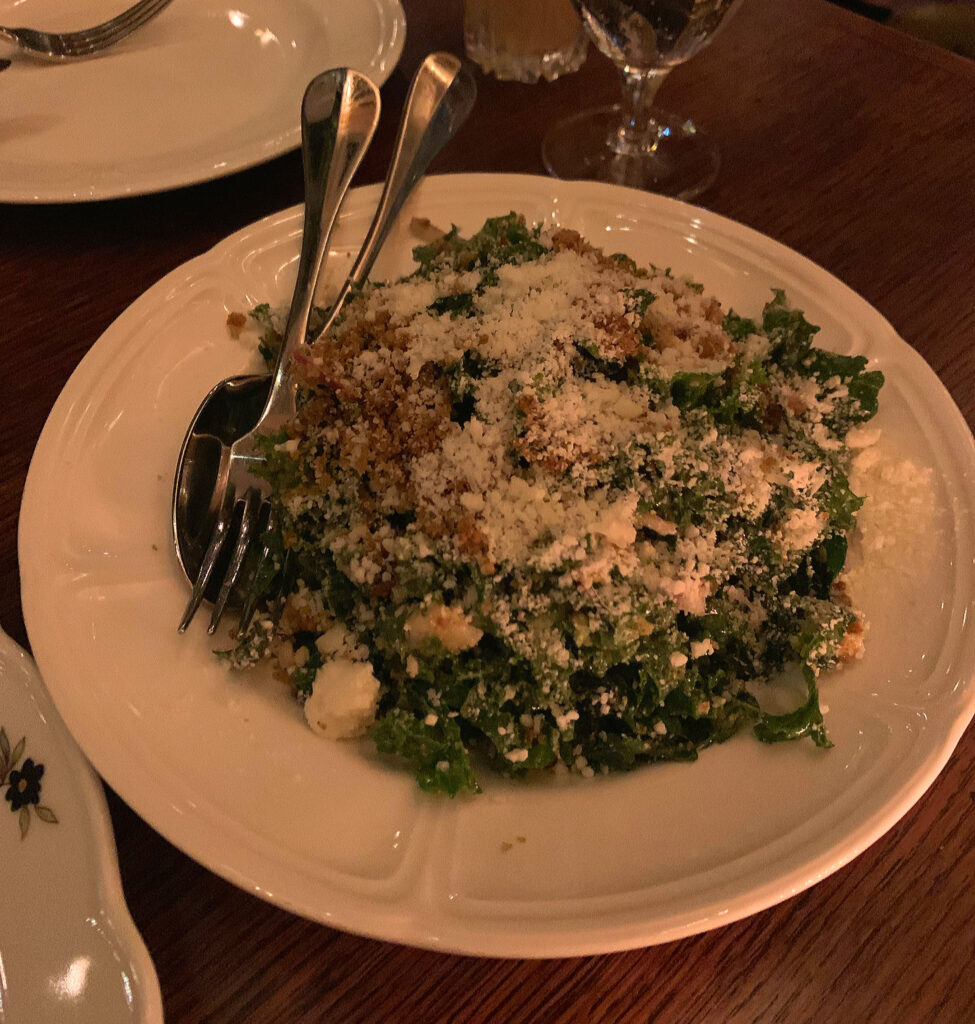
Wolen’s “Kale Caesar” is no slouch either. In fact, its shredded leaves really do remind you of that salad he served at Somerset. They are sized in such a way as to offer an addicting crunch that, nonetheless, gives way quickly enough to the lip-smacking black pepper-parmesan dressing. Sourdough croutons and some red onions are thrown into the mix, along with that same duo of breadcrumbs and grated cheese. However, in this case, the parmigiano possesses a granular—rather than a ribbon—structure. Instead of melting on the tongue, the cheese joins the other ingredients in offering an opposing crispness to the kale. Thus, the Caesar has a bit less going on than the chopped salad, but it shines on account of its focus. The leaves possess an appealing umami quality on account of the dressing, which is appropriately amped up in accordance with the kale’s more robust flavor. From there, the croutons, breadcrumbs, and grated cheese simply pile on the pleasure. It’s a beautiful rendition that, once more, edges out the more basic version served at Elina’s. Wolen deserves real credit for his achievement on this section of the menu.
With its “Homemade Pasta” section, Alla Vita offers one of the best means of comparison against its competitors. The restaurant shares several particular dishes in common with Adalina and Elina’s, like vodka rigatoni and chicken parm, but the three generally diverge at a conceptual level. Creatively, Wolen’s pastas may be judged against Ahn’s creativity and Rusnak/Safin’s devout classicism. However, each of the chefs can also be judged more simply on the quality of texture and balance of flavor they have achieved in each of the dishes. You can ask, “does this pasta fulfill the sense of comfort customers desire?” rather than subject the composition to a cultural-historical evaluation that privileges thoughtful engagement with (or subversion of) tradition. Omitting that more intellectual consideration, which Adalina and Elina’s excel in satisfying, allows each of the restaurants to be compared purely at the level of technical execution and is considerate of the admittedly more casual focus of Wolen’s venture.
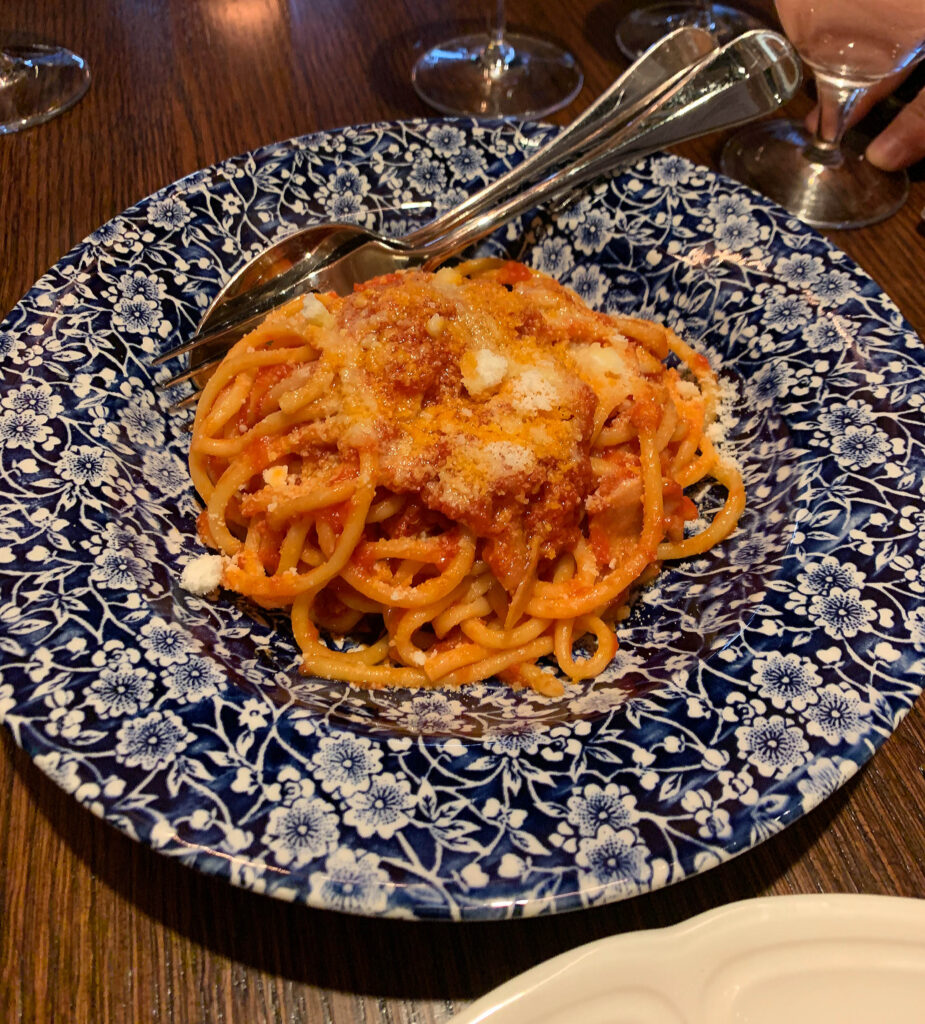
“Bucatini” ($20), paired with roasted tomato sauce, guanciale, and pecorino, starts off the section. (Other restaurants might term this preparation an all’Amatriciana, given the combination of the thicker extruded noodle with cured pork jowl and grated cheese). Though crushed red pepper flakes sometimes provide this recipe with a jolt of heat, Wolen sticks solely to black pepper and a garnish of a few basil leaves. This not only makes the dish more widely accessible but, actually, mirrors the original Roman version of the Amatriciana sauce developed in the late 1700s.
The bucatini arrive boasting their signature “little holes” and an attractive thickness. Loosely spooled, the noodles emphasize their weight as they bend around the plate. The sauce and other accompanying ingredients are largely restricted to the center of the mound, allowing you to control the pasta’s exact amount dressing as it’s served out from the shallow bowl. Starting with one of the relatively naked noodles on the outside, you appreciate the bucatini’s faint chew. Then, digging further into the plate, you slurp up the noodles whose holes contain more of tomato sauce and whose exteriors are blanketed by all of the grated cheese. Mixing everything together, you note the crispy bits of guanciale that punctuate each bite.
Texturally, Wolen’s “Bucatini” is well-conceived. The noodles impart a substantial, yet yielding, effect on the palate that signals a good al dente preparation. The encasing of sauce, small bits of pork jowl, and even smaller granules of cheese serve to accentuate their weight and circumference all the more via a variety of contrasting mouthfeels. However, while the sweet-porky guanciale and salty-sharp pecorino combine to form a substantial savory flavor, you do not find it to be enough to carry the dish. Even with its tinge of black pepper, the roasted tomato sauce strikes you as too mild. It lacks the driving depth of flavor—the captivating fruitiness, tang, and acidity—that must undergird such a simple preparation. Crushed red pepper may not be the only solution, but at least one talented Chicago pastaia combines them with both garlic and anchovy to enliven her Amatriciana. Wolen’s, meanwhile, is more broadly-appealing but stops short of being truly delicious.
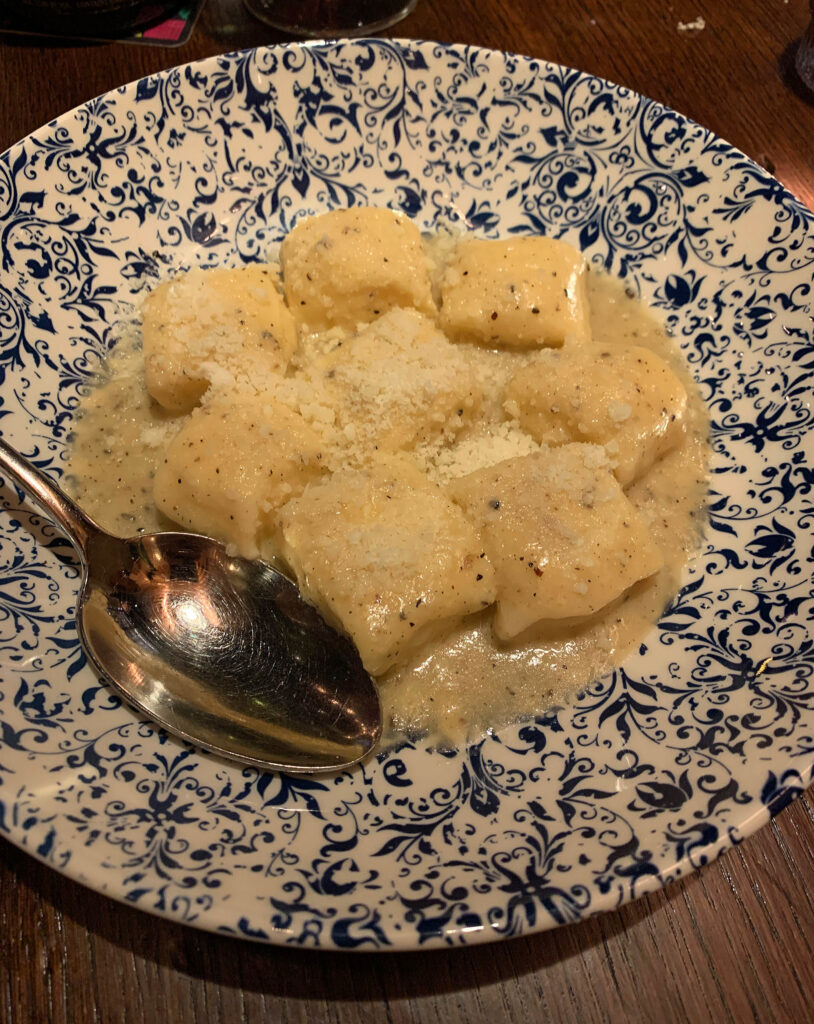
Alla Vita’s “Ricotta Dumplings” were touted as one of the chef’s signature pastas that would be brought over to the restaurant from Boka (where they might typically be paired with peas and black truffle). $21 gets you eight of the medium-sized pillows covered in a coating of cacio e pepe-inspired sauce with a garnish of grated pecorino. The dumplings sort of form the restaurant’s answer to gnocchi while, at the same time, asserting a distinctly American interpretation. However, in porting the item over from its one-star environment, Wolen clearly chose to further amplify its Italian character.
Cacio e pepe, typically, comprises the classic Roman combination of spaghetti, black pepper, and Pecorino Romano bound together with a bit of cooking water. Here, it refers to a peppery, cheesy sauce that is only barely creamy and, thus, faithful to the liquid formed upon dressing the noodles in the traditional recipe. This substance lightly coats the dumplings—made from flour, egg yolk, and the titular ricotta—and runs across the bottom of the plate. Other than the additional dusting of pecorino and some freshly ground black pepper, the dish is concentrated solely on the interplay of the pasta with its sauce.
Wolen’s dumplings are smooth, soft, and possess a moderate density. With just a couple chews, they break apart and ooze onto on your palate but retain a trace amount of structure. This finishing texture, which borders on gumminess, is not that jarring but does distinguish the pasta from, for example, the melt-in-your-mouth gnocchi served at Adalina or Rose Mary. With the right contrasting ingredients, like the peas and black truffles at Boka, this lingering textural quality to the dumplings could actually be a boon. In fact, had Wolen thickened his cacio e pepe sauce to be more like a mac and cheese, it might have melded seamlessly into (and, thus, elevated) this nearly gummy quality.
However, as it stands, the dumplings strike you as plodding and one-note. The faint, latent flavor of the ricotta is enriched by the deeper flavor of the peppery, pecorino-based sauce, yet neither cheese can make up for the pasta’s middling texture. The dumplings must attain a more ethereal, pillowy quality or be paired with a greater diversity of ingredients to shine. As it stands, neither they nor the cacio e pepe element are executed well enough to form one of the restaurant’s signature items. These “Ricotta Dumplings,” for want of decadence, fall well short of the “Cacio Whey Pepe” ($21) at Monteverde and “Radiatore ‘Cacio e Pepe’” ($17) at Rose Mary.
Wolen’s “Tagliatelle,” too, aims to offer a deep sense of satisfaction but falls short. Dressed with a beef shank ragù, the “cut” ribbons ostensibly offer the menu’s meatiest pasta experience. The noodles are impressively thin and offer only a faint resistance as they hit the tongue. They pair beautifully with the strands of braised beef that, while robust enough to contrast the tagliatelle, ultimately yield to a pleasing tenderness. Some fresh oregano and an ever-present grating of pecorino provide the finishing touches, but the combination does not amount to a cohesive pasta dish.
As with the “Bucatini,” Alla Vita’s “Tagliatelle” fails to offer of a sauce of adequate intensity. Each of the plate’s elements combine to achieve a textural balance, and there are some bites—loaded up with beef and cheese—that smack of savory power. Nonetheless, the ragù made from the braised shank tastes like little more than a light jus. It moistens but lacks the depth of beef or tomato flavor to make the ribbons of pasta or strands of meat really sing. The dish ends up eating like a bland Stroganoff rather than a bonafide meat pasta, and it’s disappointing given how well the shank is prepared. The kitchen may only need to reduce the beef’s braising liquid a bit more (or gussy it up with tomato, onion, garlic, and even a touch of balsamic) to succeed. But, for now, the preparation’s great textural appeal is let down by a dearth of supporting flavor.
Thankfully, Wolen’s “Rigatoni” (alla vodka) is a smashing success. At $20, the dish measures up to the version served at Elina’s ($19) and, if you are being honest, actually surpasses it. The latter recipe impressed you with its restraint: Rusnak and Safin’s sauce was flavorful yet used sparingly, allowing the chew of each noodle and crunch of the Calabrian breadcrumb topping to assert themselves. Texturally, this made for a more intelligent interpretation of the beloved, canonical Italian-American recipe. Wolen, by contrast, aims straight for guests’ pleasure centers. It’s an uncharacteristic strategy for the chef, but one that might rescue Alla Vita’s entire “Homemade Pasta” section.
The restaurant’s rigatoni first appeared in the form of a longer pipe shape but, as seen elsewhere, were exchanged for a shorter, slightly bent lumache style. This revision made it so that customers need not cut the larger pieces in two to take a bite. Rather, they can now probe each piece of pasta one at a time and enjoy a double-jointed sense of chew as it caresses their palate. Alla Vita’s vodka sauce displays the same neon color as that served at Elina’s but is wielded a bit more generously. The familiar combination of tomato, heavy cream, and the namesake spirit coats the tubes of pasta with a glistening sheen. They are then topped with nothing more than some grated parmigiano.
Such a simple formula reminds you of Wolen’s faulty “Ricotta Dumplings,” but the chef’s “Rigatoni” undoubtedly succeeds. The vodka sauce possesses a lip-smacking sweet-acidic quality that you cannot get enough of. It ranks, in your opinion, as Alla Vita’s best sauce by a country mile, delivering all the depth and intensity you found to be glaringly missing from the menu’s other pastas. Building off of that, the rigatoni need only fulfill the same pleasing texture as Wolen’s noodles, which it does. The grated parm adds a bit of intrigue and some additional umami. However, the sauce—at last—really is the star, and the dish is sure to please scores of customers naturally drawn to one of the Italian-American genre’s hallmarks. For Wolen, it is a monumental success, and you can only hope that the vodka recipe is one day used to dress the restaurant’s pizzas as well.
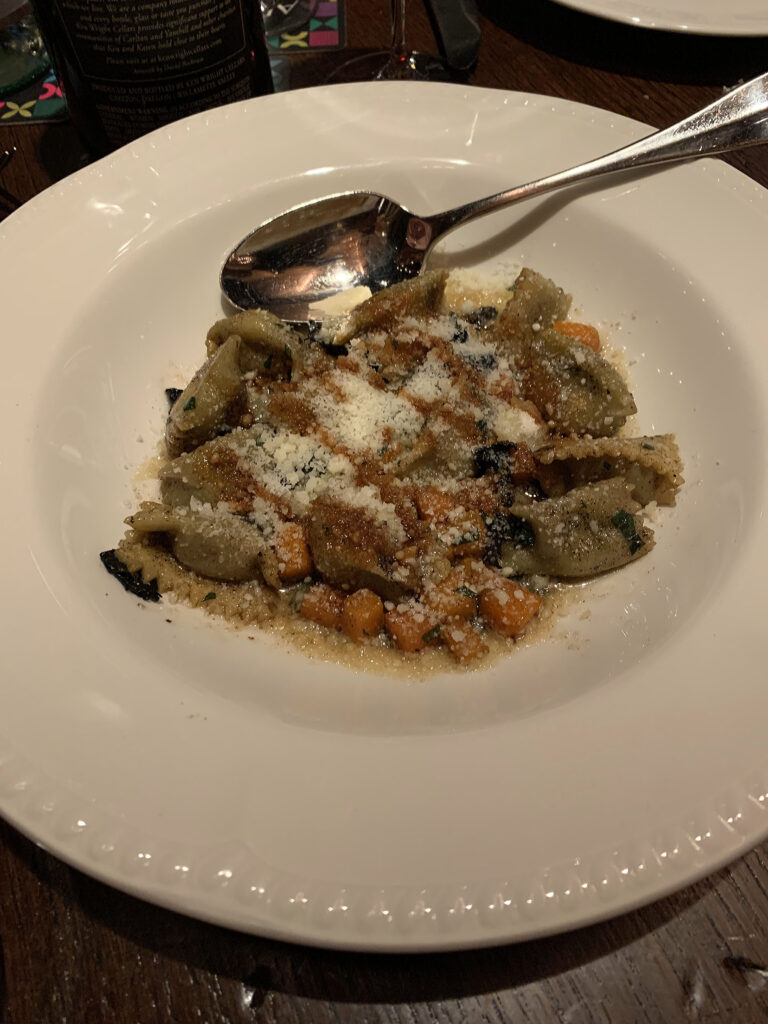
The next pasta appeared on Alla Vita’s opening menu as “Agnolotti” ($19) before changing its shape to “Cappelletti” ($19) but keeping the same accompanying ingredients. Eventually, the dish would transform into the slightly reconfigured “Tortelli” ($21) item that is now currently offered. However, you only tried the dish in its original “Agnolotti” form and will only speak to that experience.
The dish comprised small rectangular packets of pasta with crinkled edges that had been folded over a central stuffing of ricotta cheese. Thus, the agnolotti, in some sense, are “ricotta dumplings” (but do not incorporate the ingredient into the structure of the dough as Wolen’s dish of “Ricotta Dumplings” do). The pasta is dressed with brown butter and joined by leaves of Swiss chard, bits of butternut squash, grated parmigiano, and saba—a sugary, syrupy condiment that is made from reduced grape must. The combination reminds you a bit of the sage, squash, ricotta, and brown butter ravioli preparations done all over the place, but somewhat reimagined.
Diving into the dish, you chew on the agnolotti, which release their cheesy interior onto your tongue. The oozing ricotta marries with the brown butter, the granules of parm, and the soppy strands of tender char. The crinkled edges of the pasta help break up the monotony on your palate. As you chew, a couple chunks of the butternut come into the mix. They crunch against your teeth and impart a range of sweet, nutty, and buttery notes that meld perfectly with the other elements. The saba, only present in trace amounts, shoots through the entire mélange and refreshes your tongue with a puckering burst of sweet-sour flavor. The grape must entices you to take another umami-rich bite and start the process over again.
While the “Agnolotti” looked like a bit of a mess, it stood as one of Wolen’s better pastas. Particularly, you think that changing the squash from a smooth purée into a chunked, textural element makes better use of the ingredient. (The ricotta, for what it’s worth, still provides that smooth-textured filling). Likewise, while classic squash ravioli dishes sometimes include a bit of brown sugar to enhance the fruit’s sweetness, the saba is a clever substitute. The reduced grape must possesses a richness and roundness similar to balsamic with a latent acidity that does more to accentuate the accompanying elements than mere sugar. Ultimately, your only criticism of the dish was that the agnolotti overshadowed the small chunks of squash. However, by changing the pasta’s shape to the smaller “Cappelletti” and now “Tortelli,” Wolen should have brought the preparation into balance. The chef deserves credit for tweaking a recipe that, with regards to flavor, is one of his most sound.
Lastly, as a seasonal item, Alla Vita’s “Homemade Pasta” section offered “Alba White Truffle Tagliolini” for $68. At Boka, Wolen has long offered the truffles “at cost” shaved over any item or, in particular, over the same kind of tagliolini noodles offered here. Thus, in some sense, the dish—perhaps even more than the “Ricotta Dumplings”—represents the importation of one of the chef’s classic dishes into the West Loop.
2021, by all accounts, was a poor white truffle season. A hot summer with little rain cut yields in Northern Italy and sent prices tripling and quadrupling from those of years past. In Chicago, only Smyth, Kyōten, and Oriole really did the totemic luxury ingredient justice. The former two restaurants charged no special supplement for their white truffles but, rather, used a sparing amount of high quality, highly aromatic tuber incredibly well in items like miso soup, king crab and corn soufflé, mushroom custard, and tamago. The latter, Oriole, charged a fair supplement of $60-$70 for a throwback dish of caraway capellini with yeast beurre monté that resonated with deep truffle flavor. Esmé served the year’s most expensive supplement, coming in at over $150, with a rather delightful tableside frothed egg foam presentation. However, the white truffle used had almost no aroma and, likewise, no flavor.
And there’s the rub. In the best of times, paying a premium for white truffle is far from a sure thing. So often, the tuber is solely an ornamental item meant to send tongues wagging on social media. Very rarely do you find a chef who sources exceptional product and accentuates it boldly enough to really justify the price. By offering truffles “at cost,” restaurants like Boka stoke a feeling of generosity that makes customers more forgiving in their expectations. Nonetheless, in a year like 2021, there is no room for error. Truffles are scarce and expensive, and anyone selling them must do more than simply shave them over pasta.
Wolen’s “Alba White Truffle Tagliolini” makes use of the thin, fresh “cut” ribbon pasta known in Piedmont as tajarin. The noodles are dressed simply in butter and parmigiano then garnished with about four grams of the cherished tuber. Immediately, it strikes you that Wolen’s tagliolini are about two times too thick. The truffles, too, are not shaved to a sheer, translucent thinness but retain their full color and a bit of firmness. The sauce of butter and parm, also, is missing the nutty overtones needed to carry the dish. Thus, you are left with little more than expensive buttered noodles with some bland mushroom shavings thrown in. Alla Vita’s white truffles offered only the faintest aroma and had absolutely no impact on the pasta’s flavor. Short of adding more cheese or sourcing more discernibly, pairing thinner shavings with a thinner noodle might have provided a better textural experience. Likewise, microplaning the truffles or supplementing them with a high quality truffle oil (something of a dirty secret) might better unleash the flavor of a comparably average product.
You do not fault Wolen for trying to offer Alla Vita’s guests a taste of luxury, but his “Alba White Truffle Tagliolini” was an undeniable waste of money and a glaring example of how the mythos surrounding such totemic ingredients often stands in the way of actually delivering a dish of pleasure. Should pricing come down in the future, perhaps the restaurant will at least be able to live up to the feeling of generosity the chef conjures over at Boka. However, even that “at cost” quantity of truffle can never eclipse quality, especially the quality of a preparation that uses the tuber not as a bauble, but in pursuit of ultimate deliciousness.
While Alla Vita’s “Homemade Pasta” section, save for the vodka rigatoni, is largely disappointing, the restaurant’s “Pizza” selection is a veritable cornerstone of the menu. The 14-inch pies, priced from $20-$23, were originally described as “neo-Neapolitan.” You think that characterization holds true. The dough, which also featured in the “Wood Fired Table Bread,” possesses an attractive depth of flavor due to a long, cold fermentation. More importantly, it displays all the large, thin bubbles and blisters—also known as “leopard-spotting”—indicative of a light, crisp crust. Whatever early potential the table bread showed is absolutely fulfilled by the time you sample Wolen’s pizza.
Some of the more interesting varieties offered have included “Artichoke” (with garlic cream, fontina, and red onion), “Brussels Sprouts” (with garlic cream, pancetta, and pecorino), “Mushroom” (with black truffle, caramelized onion, and taleggio), and “Butternut Squash” (with roasted garlic, salsa verde, and pecorino). The more classically derived, benchmark options have comprised “Margherita” (with tomato sauce, fior di latte, and basil), “Soppressata” (with provolone, Calabrian chili, and honey), and “Fennel Sausage” (with broccolini, mozzarella, and pecorino).
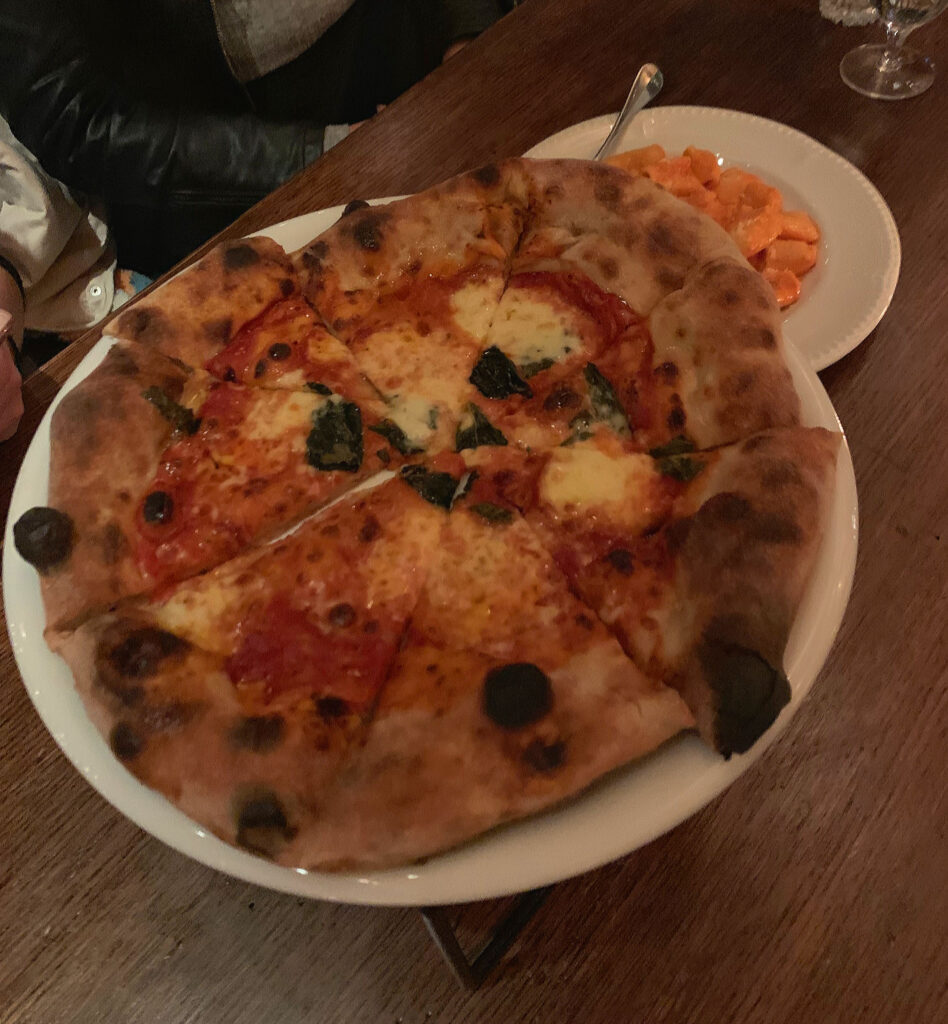
Over the course of your visits, you have indulged only in those latter three pies; however, they stand as a good representation of Alla Vita’s pizza fundamentals. The “Margherita,” by drawing on fior di latte (a cow’s milk version of mozzarella), features a nicely incorporated layer of cheese that avoids some of the splotchiness derived from the buffalo milk variety. While the basil is somewhat thoughtlessly tossed on top, it crisps up nicely in the oven. The tomato sauce, which disappointed you as part of Wolen’s meatball and pasta preparations, does a fine job here. For, rather than needing to provide a dish’s driving flavor, it simply forms an accessory to the mildly sweet, slightly sour, and beautifully caramelized crust. Those background notes—the latent complexity drawn from the dough’s fermentation—enable each of the restaurant’s combinations to shine.
For the “Soppressata,” ingredients like spicy salami, sharp provolone, and Calabrian chili are moderated by a mouthcoating drizzle of honey. In the “Fennel Sausage,” bitter, crunchy broccolini balances the chewy chunks of anise-tinged pork. The toppings, in both of these cases, are finely incorporated onto the pizza to ensure homogenous bites. However, despite being processed in such a way, they still strike you with their freshness and robust textural quality. These pies also make use of a more standard shredded mozzarella that ensures equal and consistent coverage.
Thus, when you pick up a slice, it is easy to bite your way from the drooping point closest to the center towards the middle without pulling off an entire layer of cheese. Rather, as you work towards the dough’s puffed end, you marvel at an increasing crispness that offers, texturally, the best of all worlds. By the time you reach the end of the crust, you are ready to applaud. It’s impossibly brittle, bubbled, and airy—but never hard. It crunches delicately between your teeth and emits a head-turning sound. This is Neapolitan pizza for the Chicago cracker crust crowd. It’s a massive achievement, and the closest thing to a reason for being that Alla Vita can claim.

Though you have noted some inconsistency with the application of toppings like the drizzled honey, the pizzas’ crusts have always been perfectly rendered. Based on the quality of its dough and skillful use of its wood-burning oven, the restaurant has earned its place as one of the neighborhood’s best pizzerias. That, perhaps more than anything else he’s done at Alla Vita, stands as Wolen’s claim to fame.
Though the bulk of Alla Vita’s entrées are organized under a section titled “Al Forno,” one of Wolen’s signature offerings is given special billing. The chef’s “particular affinity for chicken” [eye roll] is highlighted by placing “Alla Vita’s Chicken Parmigiana” in boldface type within a thick octagonal border. Yes, the “Salads” are treated similarly, but, there, guests have a couple options to choose from. This is more like an embedded placard, a “must-order” designation that automatically lends the dish a sense of gravitas. How could it not? Next to vodka rigatoni, chicken parm epitomizes BRG’s “comfortable Italian” canard while freeing the restaurant from any allegiance to the larger Italian-American canon.
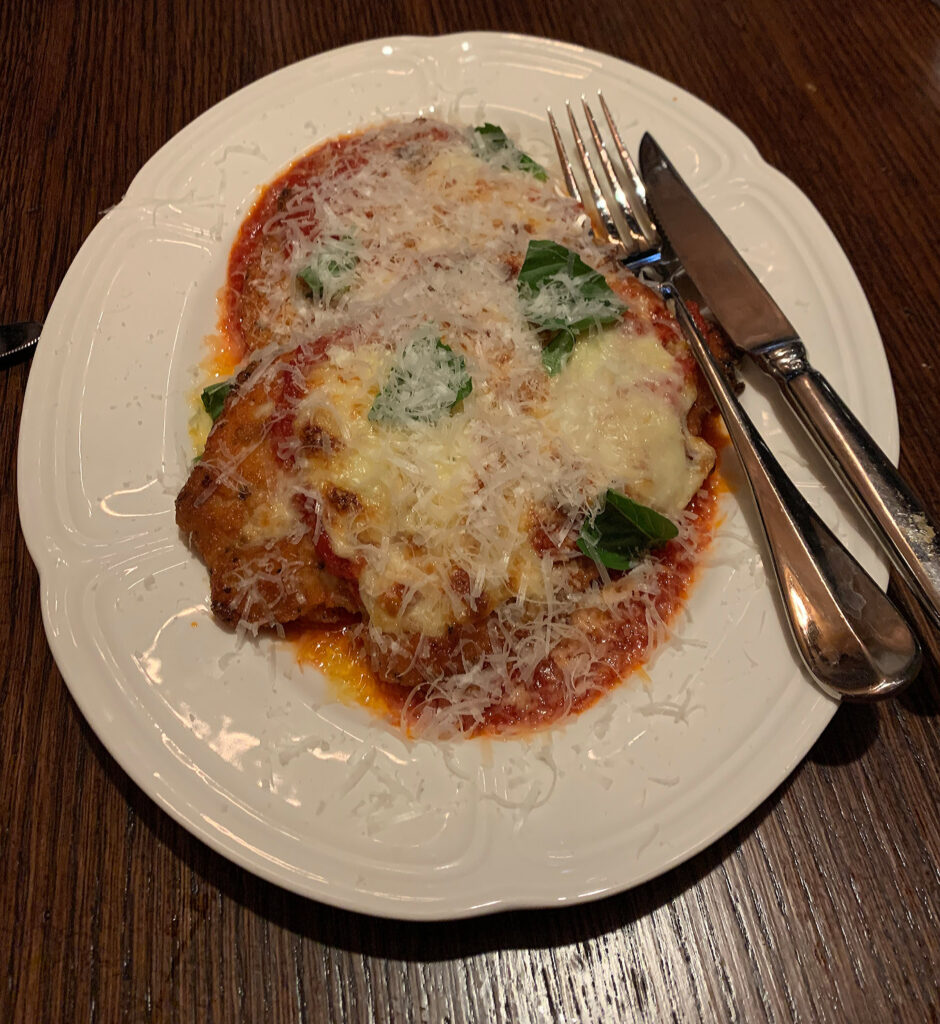
At $34—compared to $28 at Elina’s—Wolens chicken parmigiana contains the same “fire roasted” tomato sauce that accompanies the meatballs and the bucatini. It coats the bottom of the plate and the top of the breaded, fried, and golden brown cutlet (approximately the same portion size, though a bit thicker, than Elina’s). The chicken is then covered with buffalo mozzarella, which is melted, and garnished with leaves of basil and a heap of shredded parmigiano. This topping of thin ribbons of parm is rather unique as far as the dish goes. Rather than being embedded somewhere underneath the melted cheese layer, the ingredient is at the forefront both in terms of flavor and, strikingly, texture.
What impresses you the most about Wolen’s chicken parm is the quality of the meat. Despite the cutlet being a bit thicker, it is perfectly tender and incredibly juicy. In that respect, the chef lives up to his supposed mastery of poultry; however, the rest of the dish falls flat. The “fire roasted” tomato sauce, you have already noted, lacks depth of flavor. The buffalo mozzarella, though an interesting and luxurious choice, hurts the preparation more than it helps. The cheese is fresh and tangy, but its profligate use and high moisture sinks any sense of crispness the cutlet’s exterior might have possessed. For, while the chicken is nicely browned, it lacks those charred bits of black that really crunch. (Elina’s version had those, and the restaurant also opted for far less cheese and sauce to preserve the breading’s texture).
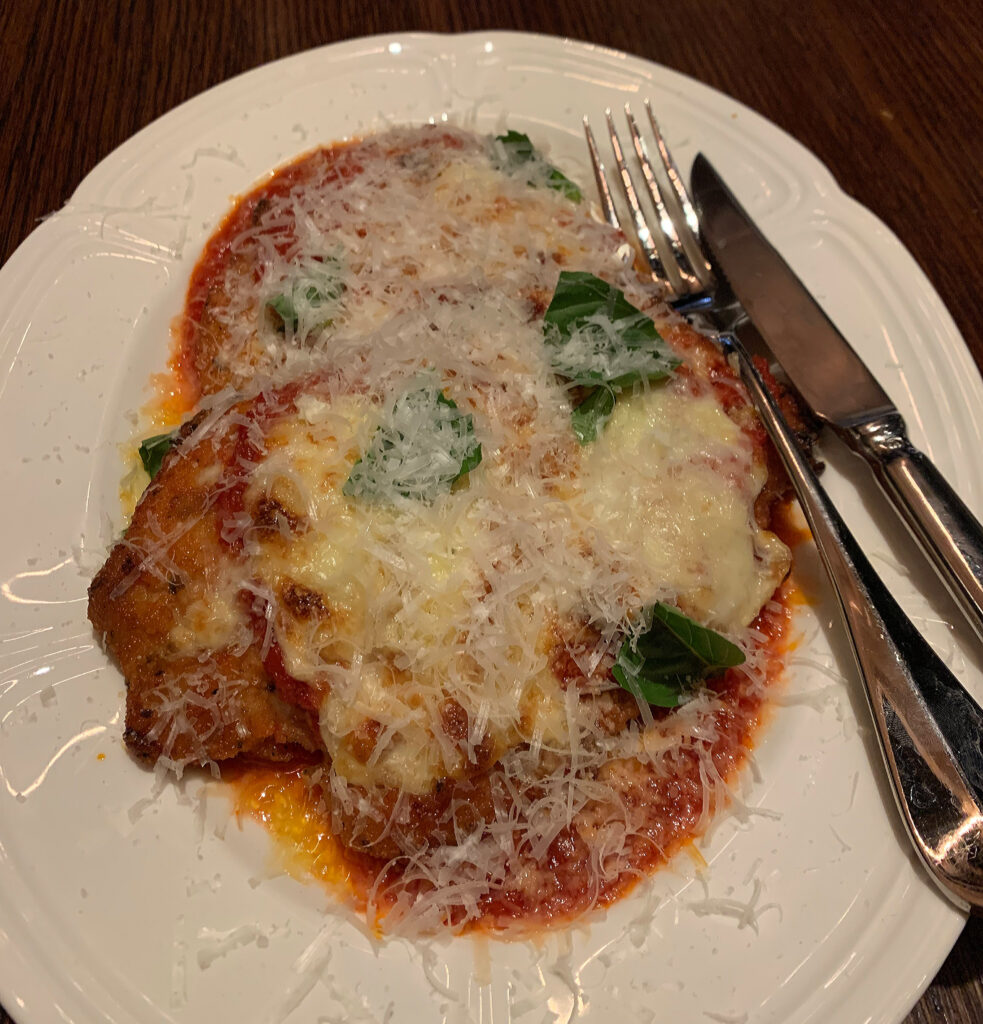
Alla Vita’s chicken parmigiana offers juicy meat, tangy mozzarella, and an additional burst of umami from the shredded parm topping. However, the dish’s lack of a crisp breading is a real letdown that causes the other ingredients to devolve into a goopy mess. Further, while the cheeses do serve to flavor the chicken somewhat, they cannot overcome the anonymity of the tomato sauce. Had the chef made use of veal like Adalina—despite warning customers “don’t look for a veal variant”—the meat’s latent flavor might have overcome the deficiency of the sauce. However, as it stands, Wolen flubbed two of the chicken parm’s key elements and puts out a pedestrian example that, save for its expensive meat, would not surpass even the most lowly neighborhood red sauce joint.
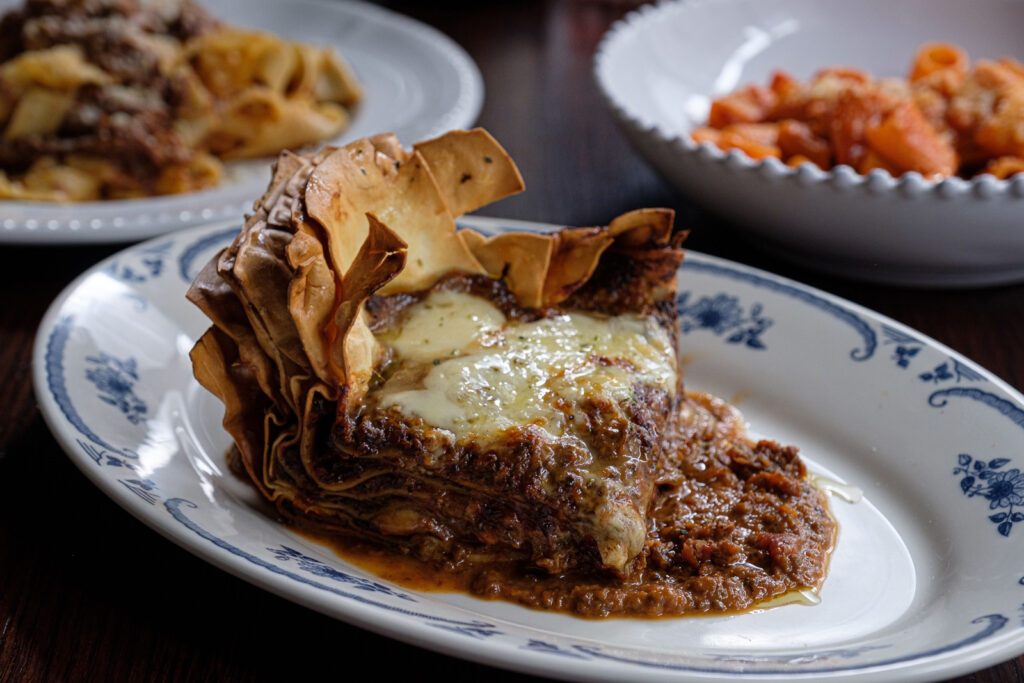
The “Al Forno” section starts with a “Lasagna” that, priced at $29, distinguishes itself from anything offered in the previous “Homemade Pasta” category. Of course, lasagne are naturally oven-baked, but Wolen’s wild mushroom and fontina rendition is also meant to play the part of a vegetarian entrée. The pasta sheets are layered six levels high with plenty of the fungi and cheese packed in between. The lasagna is topped with more fontina and sent into the wood-burning oven, where the intense flame chars the ends of the noodles that peek out over the edge of the pan. This yields a slice with a smooth, soft interior and an attractively crisp outer crust that diners can mix and match as they eat their way through the dish. The whole thing sits in a puddle of tomato sauce with the same shredded parmigiano topping you noted on the chicken parm.
While Alla Vita’s website portrays the “Lasagna” as a towering construction overflowing with a chunky mushroom ragoût, what arrives is long, slender, and defined more by that same old underwhelming tomato sauce. The sweet and nutty fontina is a good choice as a melting cheese. On one occasion, it drooped down from the top layer in a picture perfect style. On another, it was an oily mess obscured by the avalanche of parm. However, in general, the dish is sound. The pasta sheets break apart cleanly and showcase a mushroom filling that is both pleasantly earthy and, texturally, a real ringer for the usual ground beef. Those crisped strands overflowing from the end of the lasagna provide a crunching contrast, but you wish they comprised more of the preparation. As it stands, Wolen’s “Lasagna” is more like a mushroom casserole floating in tomato sauce. The dish lacks the superlative technique and intricacy of something like Elina’s eggplant parm. In its present state, it stands as little more than a passable gimmick for the restaurant’s coveted vegetarian, BIÂN member demographic.
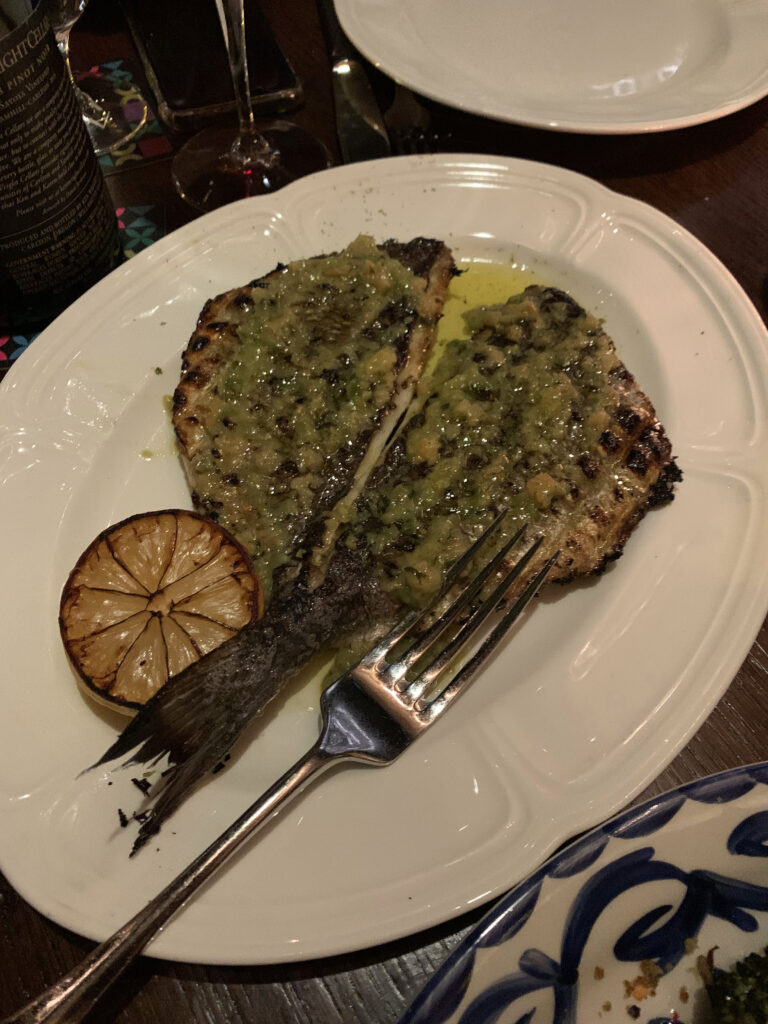
Wolen’s sole fish preparation across the entire menu makes use of sea bream, a meatier choice than the more delicate sea bass (also known as branzino) often seen within the Italian genre. While that sounds like something of a compromise, the chef cooks the whole fish to perfection. It arrives at the table boasting a beautiful, crosshatched char pattern and having already been separated into two neat fillets. Each is dressed in a salsa verde that has been spiked with Castelvetrano olives and golden raisins, and the whole preparation sits in a shallow puddle of olive oil with a charred lemon as an accompaniment.
Priced at $42, the dish first seemed a bit meager. However, you think it stands as Wolen’s finest technical execution across the entire menu. The sea bream’s charred skin breaks apart cleanly and offers a captivating crunch before its succulent, flaky flesh hits your palate. While you have had difficulty noting the influence of the raisins, the combination of buttery-sweet olives, pungent salsa verde, fruity olive oil, and tangy-smoky lemon juice dresses the fish nicely. Ultimately, nearly everything that arrives on the plate is edible, so a party of four could easily halve the two fillets and each take a small (but satisfactory) portion. The dish is not quite delectable enough to entice much of a larger sample, but it confidently reflects the quintessence of grilled fish. It’s certainly one of the menu’s most “Italian-Italian” preparations, and Wolen shows a glimpse of what the menu might have looked like had he been steered more firmly in that direction.
The last of the entrées you sampled was the “Roasted NY Strip,” which has more recently been exchanged for the “Roasted Bone-In Ribeye.” Both steaks cost $78, and both have been paired rather simply with a halved head of roasted garlic, some rosemary, and olive oil. In actuality, the both receive a bit of extra help by way of some flaky salt and cracked black pepper strewn atop the slices of beef. That’s a good thing.
Diving in, you note the steak’s beautifully charred crust that surrounds a glistening medium interior. The portion lands somewhere around 24 ounces by your measure, yielding about two slices per person for a party of four (not including whoever gets to nibble on the bone). The meat is flavorful (being adequately seasoned) and free of any sinew or unrendered fat deposits. The head of roasted garlic, though always a mess to maneuver its cloves onto the steak, provides a pleasing caramelized note that melds with the richness of the olive oil and woodsy lift of the rosemary.
It’s a fine steak that, like the sea bream, is executed with aplomb. Substituting the NY strip for a noticeably larger bone-in ribeye, no doubt, better matches Alla Vita’s theme. But, also like the sea bream, the dish misses some distinguishing factor that would really lodge it in your memory or keep you coming back for more. Wolen has done a good, if simple job. However, you would take Monteverde’s $82 bone-in ribeye (with grilled shallot, cherry tomato, and balsamic) or Rose Mary’s $82 bone-in ribeye (with Split rub, roasted peppers, and balsamic) over the Boka chef’s rendition any day. That $4 difference gets you a steak that is inventively dressed in accordance with some actual vision. Likewise, the “Bistecca alla Fiorentina” at Adalina and the “Prime Ribeye for Two” at Elina’s—while more expensive—undeniably feel more unique than Wolen’s filler item.
As to Alla Vita’s “Veggies” section, you cannot find fault with the “Roasted Broccolini” (with preserved lemon, garlic, and olive oil) or “Roasted Mushrooms” (with bagna càuda and crispy garlic). Nonetheless, as with the “Goomara” at Adalina (save for their excellent crispy fingerling potatoes) and “Contorni” at Elina’s, the side item category does little to distinguish itself other than being a friendly companion for the restaurant’s larger plates.
Though Wolen had forged a winning partnership with executive pastry chef Meg Galus during her six years with BRG, Alla Vita marks his first collaboration with Kim Mok as she steps into Galus’s shoes. You have held high hopes for the restaurant’s “Desserts” section, for Mok had already been the pastry sous chef at Boka and had worked alongside both Galus and Wolen for years. There was every reason to believe she possessed ample talent, and that she might approach the wide range of sweets offered by the Italian genre with a singular perspective.
You start off with Mok’s “Tiramisu” ($14), a firmer, more sharply squared version of the familiar “pick me up” (or tirami su). The dish is built upon the traditional base of ladyfingers—essentially, sponge cake biscuits—that have been dipped in coffee. Alla Vita also adds some Vecchio Amaro del Capo (as featured in the “Sailor’s Delight” spritz you so enjoyed) to the mix. To build the tiramisu, a bottom layer of the soaked ladyfingers is topped with a thin coating of malted mascarpone cream, which is then covered with another layer of ladyfingers. A much thicker layer of the malted mascarpone tops that, and the whole thing is finished with a dusting of cocoa powder.
Digging in, you are first struck by the texture of the mascarpone cream. It is not the soft, nearly oozing sort that can barely hold its structure in other examples of the dish. Rather, it comes closer to a bavarois, possessing a gelatinous quality that better holds its shape. This serves to frame the bottom two layers of ladyfingers split by their own filling of mascarpone. The biscuits have been moistened enough to feel a bit mushy but retain a sense of dryness throughout their interior.
By malting the mascarpone, Mok imparts an undercurrent of nutty, toasted flavor that enhances the slightly sweet, mildly acidic cheese. It also forms a fitting complement to the cocoa powder and notes of coffee. However, the Vecchio del Capo—despite how much you enjoyed it in your spritz—imparts a jarring alcoholic note that spoils all this decadence. Yes, Marsala, rum, Port, Madeira, and liqueurs in the coffee or amaretto style are often used to elevate tiramisu recipes. But the wide range of herbs, spices, roots, fruits, and flowers that flavor this particular amaro form too much of a distraction. This is compounded by the gelatinous texture of the mascarpone, which, lacking the typical enveloping creaminess, calls greater attention part-mushy, part-dry ladyfingers and their errant tinge of alcohol. The recipe, while it holds some visual appeal, is guilty of complicating, rather than refining, the tiramisu’s core elements. It cannot hold a candle to the version served at Monteverde ($17).
Alla Vita’s “Apple Ricotta Cake” ($14), sadly, has proven an even worse dessert. The combination of the sweet, caramelized fruit with soft, creamy cheese sounds like a winner. A topping of lemon streusel, olive oil vanilla gelato, and salted caramel makes the dish sound as if it combines the best elements of an apple pie and a cheesecake. However, both times you have tried the dessert, the cake’s texture was dense and unyielding.
The dish looks as though it possesses a glimmering, custardy consistency. It looks as though it is positively dripping with flavor. But its interior is perplexingly drying, and it takes every bit of the gelato simply to choke it down. That’s a damn shame, as the streusel and caramel elements are delicious. The idea behind the recipe, too, is fundamentally sound, and it could have satisfied the decadence you found missing from the tiramisu. You have a hard time believing either of these desserts are being executed as intended, but you have no way of knowing. Whether flawed in conception or in practice, they make Elina’s humble offering of cannoli look smart by comparison. They are certainly miles off of Guini’s work at Adalina, which manages to be both highly creative and strikingly delicious.
Alla Vita’s “Nutella Sundae” ($14) is marginally better. It combines a Nutella gelato with cocoa streusel, caramelized hazelnuts, Amarena cherries, whipped cream, and chocolate sauce in a traditional sundae bowl. As with the aforementioned olive oil vanilla variety, you think Mok’s gelatos (which also include pistachio and mint stracciatella) possess good flavor. The toppings at play in the sundae are well-suited to the dish and serve to extend and enhance the pleasure one derives from Nutella. However, you would like just a bit more creaminess from the gelato (or for it to be melted just a bit more by way of a warm element) to let those crunchy textures really pop. As it stands, your favorite dessert at the restaurant is an affogato made with pumpkin spice gelato—a nostalgic combination that amounts to a refined version of the infamous Starbucks latte.
Soured by the pastas, chicken parm, and desserts but satiated by pizza, you make ready to depart the garden. With enough booze in you, your disdain for the setting has faded. Kehoe’s hodgepodge of cheap materials isn’t offensive to sit within. It does not affect your perception of Wolen’s food, but, looking back, it does form the key to understanding why Alla Vita is such an underwhelming concept.
The restaurant, to its credit, maintains a decent wine list and makes some good cocktails. It serves a good table bread, some stellar salads, a great vodka rigatoni, and a style of pizza that is worth the trip alone. This is the extent of Wolen’s talent, vis-à-vis Italian food, and it should have formed the ironclad core of Alla Vita’s concept.
BRG could have pursued each of these elements wholeheartedly, privileging consistency, value, and creativity within a narrow range of surefire crowd-pleasing forms. Over time, the group would surely develop better “Antipasti” while expanding the salad and pizza options to better showcase seasonal flair. The wine list, being driven by the cuisine’s high volume and lower overhead, could have become an attraction in itself. Rather than stocking Hillside Select and Super Tuscans to pair with a lone steak dish, Alla Vita might have built an engaging selection of crushable wines (not to mention Champagne) well-suited to pizza. Trying new bottles, alongside a rotation of delectable pies, could have offered a compelling to return time and again. Alla Vita might have become something like USHG’s Marta: a broadly-appealing, wood-fired hotel restaurant that, at the same time, lures connoisseurs from all over town.
To execute that, the restaurant’s setting need not dazzle, but simply make guests comfortable as they indulge in timeless pleasures. Instead, the “shock and awe” approach to ambiance chosen by BRG and Kehoe belies the deep cynicism with which Boehm and Katz approached the concept.

The honchos had no particular vision for the kind of food Wolen would serve, hence the shift from “Italian-American” to “comfortable Italian” during the period of time between Alla Vita’s announcement and its opening. Rather, repeating the same mistake they made with Bellemore, Boehm and Katz latched onto the nonsense metaphrase “to life.” That phrase, like “bright, bold, and beautiful,” birthed a concept that was superficially grounded on the theme of shared plates in a vibrant setting. They gilded the pitch with a trite reference to the “pandemic isolation” the restaurant sought to reject, but, in truth, countless eating establishments can claim to offer the same communal experience.
Rather than task Wolen with articulating any particular approach towards (or excitement for) Italian cuisine, BRG bought him a pizza oven and let him transplant a couple of his creations from Boka. Chicagoans, surely, would eat up whatever the group’s shining star chose to serve. Why bother appealing to them on the basis of passion, creativity, or nostalgia? Why put in the hard work of forging a unique culinary identity in a city loaded with Italian concepts? Why not just regurgitate the same Bellemore playbook, confident that the unwashed masses could never say no to chicken parm however lazily it is prepared?

Boehm and Katz set the BRG marketing machine in motion, confident the media manipulators masquerading as journalists would eat up Alla Vita’s prepackaged post-pandemic narrative with glee. As the hype took shape, the question became “how do we deliver?” Wolen, of course, wasn’t up for it (or wasn’t asked to be). So that “to life” gimmick would need to take on an obvious form. So obvious, lacking a viral dish like Bellemore’s “Oyster Pie,” that even the city’s braindead influencers could catch on. But it needed to be something low risk too. The honchos had already wasted far too much money on the misfiring space.
Enter Kehoe, whom you can now only assume was tapped as a discount designer hungry to make a name for themselves outside of private events. For what you hope was a cut-rate price, they vomited all their party tricks onto Studio K’s former aesthetic. The firm thought, surely, that what clients loved about their ballrooms and tents guests would surely love when going to dinner. After all, “to life” is not a restaurant theme so much as a vague sense of occasion. There would be nothing captivating about the food—just like at a private event—so the evening would be defined by set dressing.
With so many plants at their disposal, Kehoe and BRG knew that “garden party” would be a safe and affordable bet. A bit of stone cladding here, some cheap wooden construction there, and a bit of tissue paper hanging from the ceiling made it happen. They dimmed the lights and slapped a wine display down by the entrance. Ah, Italia!
At opening, BRG lured its usual parade of plastic self-promoters into the dining room. Boehm and Katz plied them with pizza, pasta, and chicken parm—food so simple that even an influencer need not strain too hard to promote it. More importantly, this conspicuous consumptive scourge took plenty of pictures. Kehoe’s set, which looks two-dimensional in person, was transformed by the power of Instagram into the perfect backdrop for a glamorous night out. Threw the skewed perspective of a filtered, posed photograph, content creators big and small perpetuated BRG’s latest bastard child.
You feel bad for Alla Vita’s servers and everyday kitchen staff, who do an admirable job keeping the dining experience moving along. You also think that Beeler did a fine job with the wine program when little suggests that BRG envisioned the restaurant catering to the wino crowd. Wolen should be commended for his wood fired bread, vodka rigatoni, salads, and pizza crust but little more. The hollowness of the chef-partner’s personality leaves a gaping hole in the concept, one that resonates throughout the space. You found none of the little details, none of the warmth or ownership, that give restaurants like Elina’s and even Adalina a sense of charm.
BRG phoned it in. There’s no question about that. But why needlessly shoehorn steak and white truffle onto the menu? Why distract guests with so much visual clutter when, even if the dishes lack any creative spark, they only need to be executed consistently? Why, from their position as James Beard Award-winning elder statesmen of Chicago dining, did Boehm and Katz settle on a thoughtless concept that uses marketing black magic to steal food from the mouth of the city’s independent Italian restaurants?
You wish you could say that Alla Vita bettered its neighborhood or Chicago’s larger dining scene. If the salads, pizzas, and rigatoni were extricated and brought over to a more appropriate setting, perhaps that would be the case. But, as it stands, the restaurant does little more than reflect BRG’s creative bankruptcy. The sycophants—professional and amateur—who continue to fellate the group’s founders should feel ashamed. They, like Boehm and Katz themselves, privilege personal gain over the cultivation of taste. They stunt the growth of the city’s dining scene in pursuit of style over substance. And they want to reap social status for doing so!
Bellemore obscured its lack of a cohesive identity with marketing drivel, but the restaurant still formed a stage for some of Papadopoulos’s interesting ideas. Alla Vita, though given free reign to define the Italian genre on its own terms, strips every bit of soul from the cuisine. It stands as nothing more than a monument to a restaurant group that has given up.



